Land Rover 90 TD5 Tribute Build & Video Series
Discussion
My 1999 Defender TD5 90 was beginning to look a little tired, it's been my runabout for over 5 years and after a lot of hard winters up north - it's definitely suffered.  ops:
ops:
With the Defender production coming to a halt soon, I've decided to create my own tribute to the Land Rover itself. To take the most iconic elements from previous Land Rover vehicles and combine them with the Defender to produce my own ideal Land Rover. I was a little underwhelmed by the Land Rover heritage special edition, so in effect, this is my interpretation of that concept. Any work carried out, the goal is to make it better than factory wherever possible.
I've been busy filming videos on the build too, you can watch how things have progressed so far:
https://www.youtube.com/playlist?list=PLhy-5DHZzPf...
So, I found a small lock-up in early 2014, it had everything I needed (room for 2 Landy's, plus space for tools and body panels e.t.c).
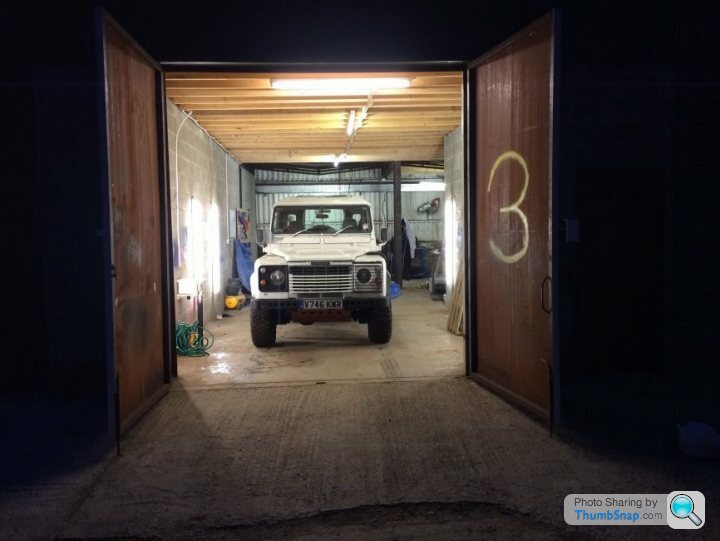
I started stripping down the Defender in January of that year. Then, my parents had their car stolen from their drive, so the Land Rover was hastily rebuilt and loaned to them for several months.
After getting it back in one piece, I began removing panels (again) and assessing the general condition:
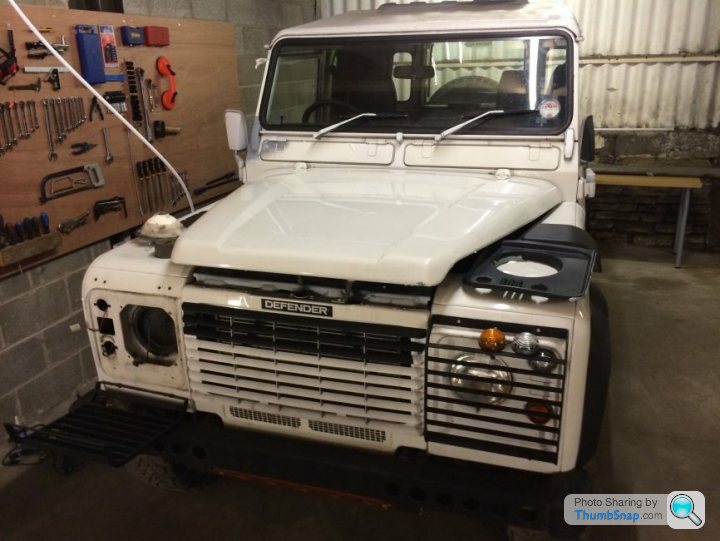
After painting the vehicle with Plastidip to use as a wedding car, I had to remove the film first.
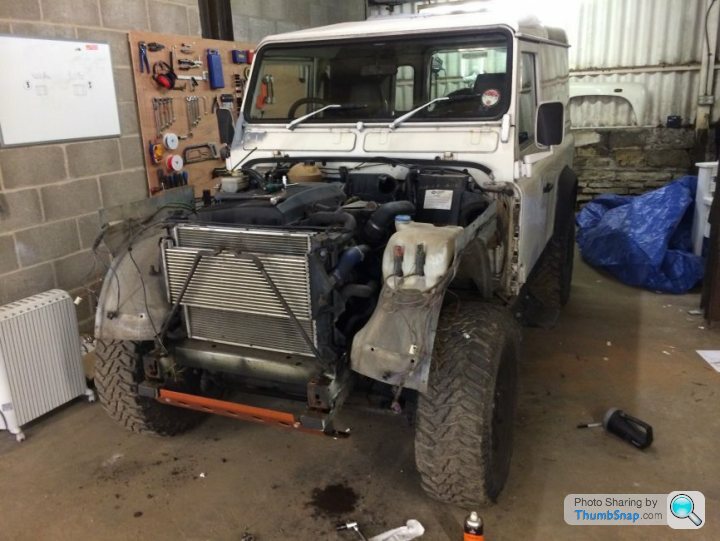
Then began removing panels, when removing panels, you slowly reveal hidden corrosion and rust :S
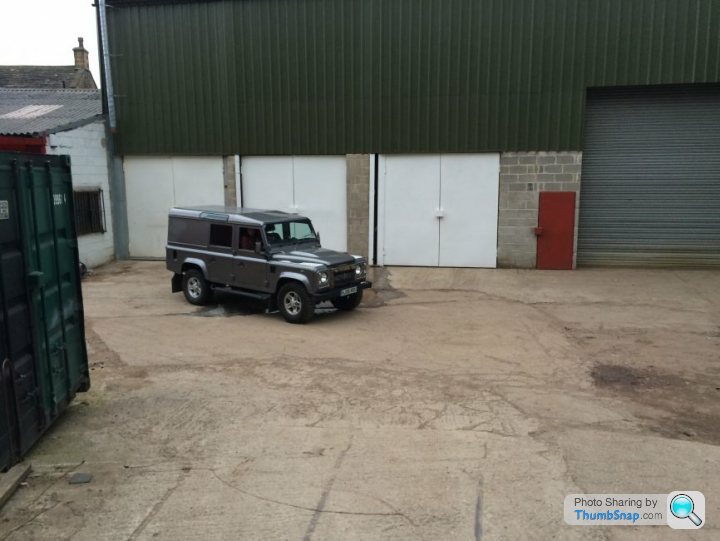
In the meantime, I bought the wife let me purchase this 110 Puma, which has been a fantastic Land Rover!
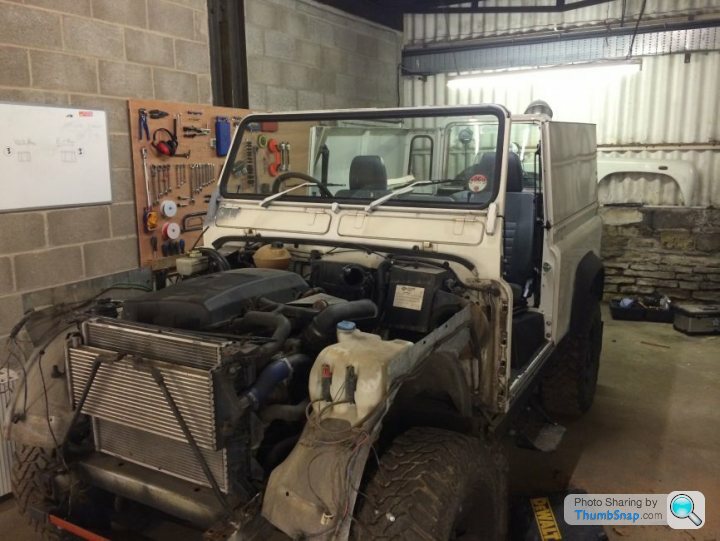
Removing panels like the roof and wings is very quick and good for morale - progress is rapid at this stage. Most of the panels are in good condition, the roof will be replaced with a soft top so I'll lose my webasto sun roof But gain a canvas top. :thumbsup:
But gain a canvas top. :thumbsup:
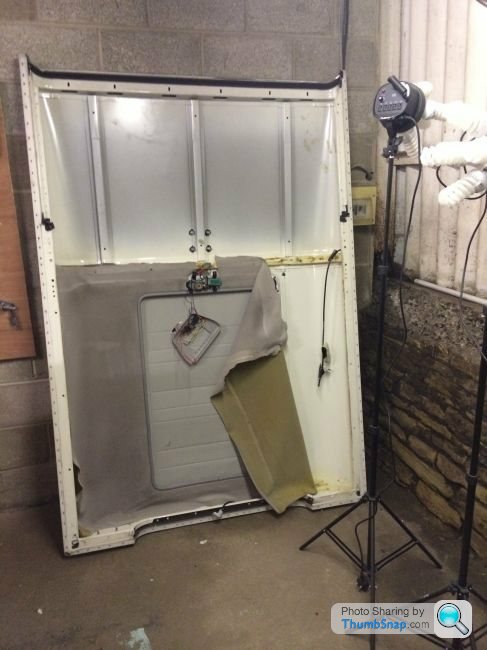
The sunroof was fitted at Land Rover Special vehicles - the 90 was originally owned by the National Grid who would drive up and down power grids with a hefty thermal imaging camera poking our the roof.
It was also used as a driver training vehicle, shown here at 2 Dales 4x4 training centre in Derbyshire. Apparently, as it had road tyres fitted, the instructors preferred this Land Rover over others available, it helped install off-road driving techniques.

The windscreen surround and hard top sides are gone! The whole lot will be stripped back so I can paint them later.I also spent time carefully drilling out rivets so I can get the capping galved. Upon refitting, I'm going to take measures prevent galvanic reactions from taking place ever again!
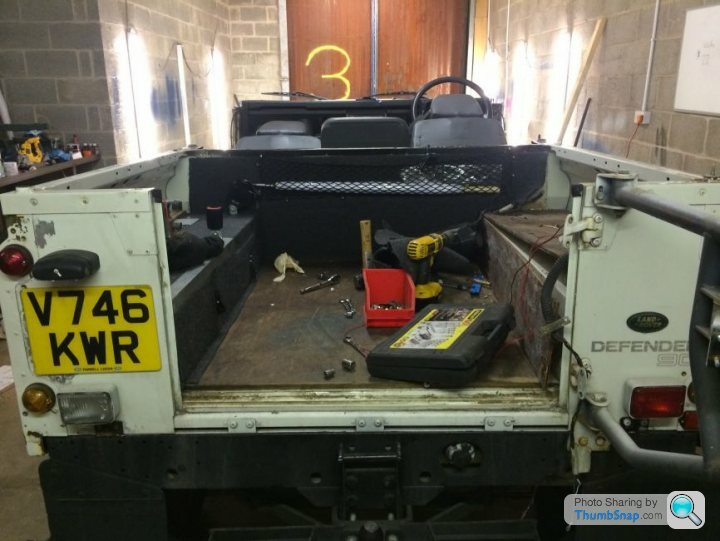
Then, the gearbox and engine needed to come out. The TD5 unit we have is low mileage and a really sound power plant. I love them! My plan is give this a good clean, perhaps a tasteful tune by Alive Tuning but that is all by way of modifications.
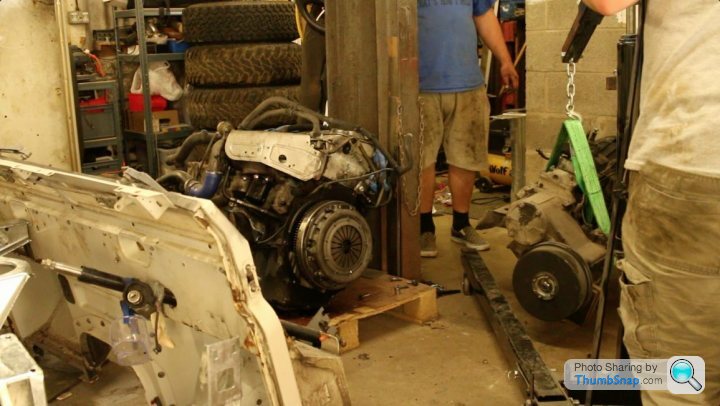
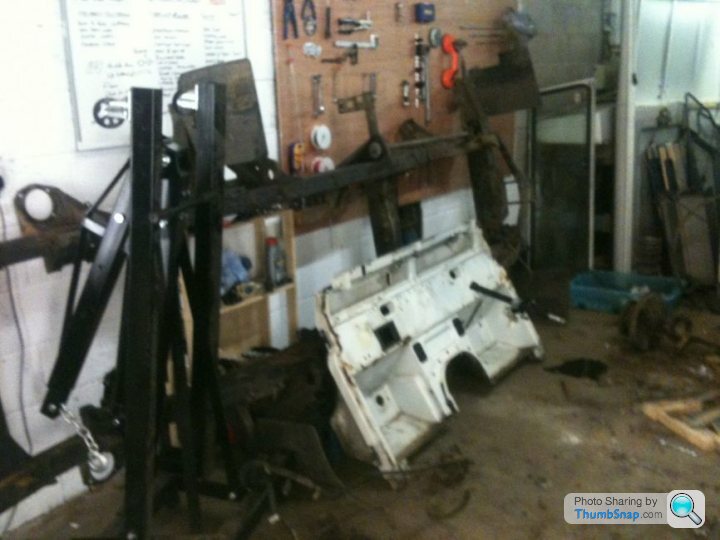
Then, the tub was removed, along with the bulkhead. The chassis was shifted to the side of the workshop to give me a little space.
I then began experimenting with electrolysis to remove rust. My experiment was working well, until the power supply exploded! Will come back to that at some point:

Underbody components were as expected for a 16 year old Landy - these are all at the shot blasters along with the bullhead as we speak.
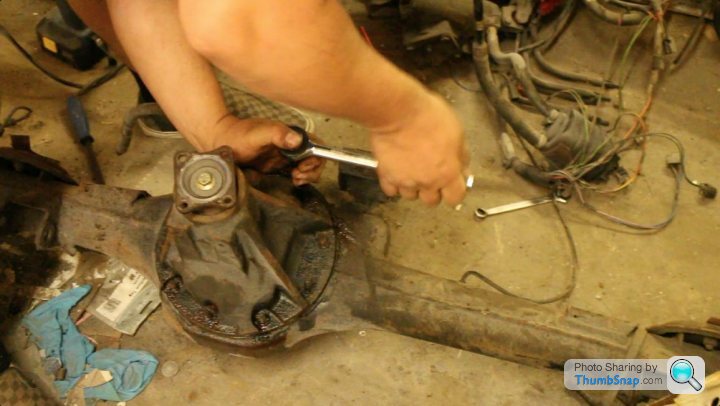
Then, it's time to start rebuilding! A shiny new galv chassis came by way of Richards Chassis at Doncaster. I've been very impressed with the build quality and finish this chassis! Top notch product, should mean this Land Rover lasts a long time.
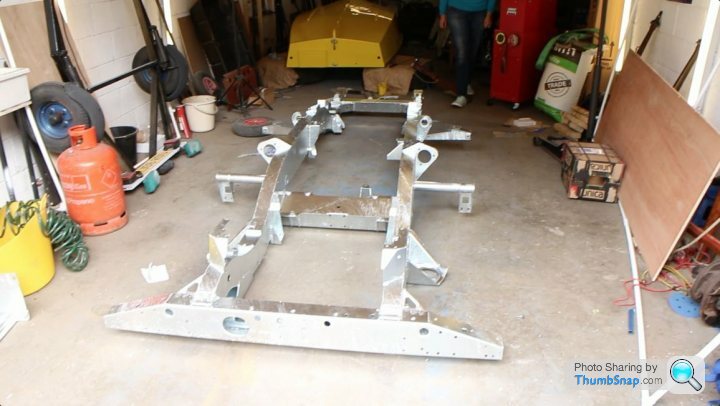
This was promptly sprayed black using a T-Wash solution, followed by etch primer and then an acrylic based top coat from Frost Autos! Looks very good now! I'm aiming for a factory finish so this extra work was worth the effort
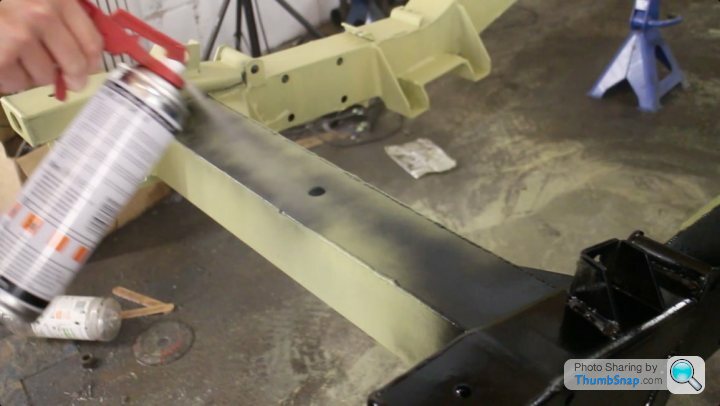
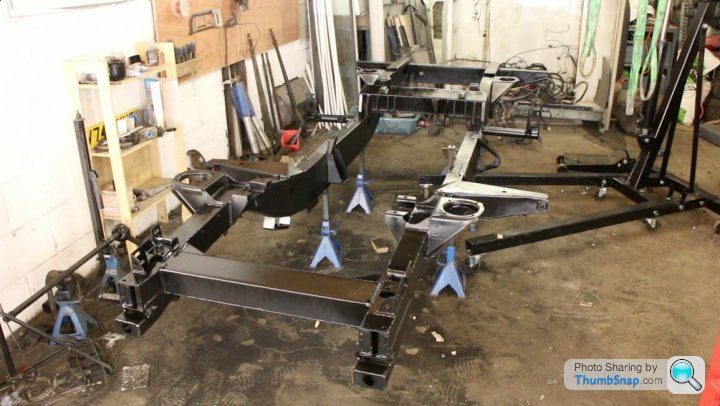
And that brings you all up to press, with the chassis painted - I'm hoping to get the whole lot built by January 2016. I'm carrying out any work I can in the shop, including a paint job, so stay tuned!
 ops:
ops: With the Defender production coming to a halt soon, I've decided to create my own tribute to the Land Rover itself. To take the most iconic elements from previous Land Rover vehicles and combine them with the Defender to produce my own ideal Land Rover. I was a little underwhelmed by the Land Rover heritage special edition, so in effect, this is my interpretation of that concept. Any work carried out, the goal is to make it better than factory wherever possible.
I've been busy filming videos on the build too, you can watch how things have progressed so far:
https://www.youtube.com/playlist?list=PLhy-5DHZzPf...
So, I found a small lock-up in early 2014, it had everything I needed (room for 2 Landy's, plus space for tools and body panels e.t.c).

I started stripping down the Defender in January of that year. Then, my parents had their car stolen from their drive, so the Land Rover was hastily rebuilt and loaned to them for several months.
After getting it back in one piece, I began removing panels (again) and assessing the general condition:

After painting the vehicle with Plastidip to use as a wedding car, I had to remove the film first.

Then began removing panels, when removing panels, you slowly reveal hidden corrosion and rust :S

In the meantime, I bought the wife let me purchase this 110 Puma, which has been a fantastic Land Rover!

Removing panels like the roof and wings is very quick and good for morale - progress is rapid at this stage. Most of the panels are in good condition, the roof will be replaced with a soft top so I'll lose my webasto sun roof
 But gain a canvas top. :thumbsup:
But gain a canvas top. :thumbsup: 
The sunroof was fitted at Land Rover Special vehicles - the 90 was originally owned by the National Grid who would drive up and down power grids with a hefty thermal imaging camera poking our the roof.
It was also used as a driver training vehicle, shown here at 2 Dales 4x4 training centre in Derbyshire. Apparently, as it had road tyres fitted, the instructors preferred this Land Rover over others available, it helped install off-road driving techniques.

The windscreen surround and hard top sides are gone! The whole lot will be stripped back so I can paint them later.I also spent time carefully drilling out rivets so I can get the capping galved. Upon refitting, I'm going to take measures prevent galvanic reactions from taking place ever again!

Then, the gearbox and engine needed to come out. The TD5 unit we have is low mileage and a really sound power plant. I love them! My plan is give this a good clean, perhaps a tasteful tune by Alive Tuning but that is all by way of modifications.


Then, the tub was removed, along with the bulkhead. The chassis was shifted to the side of the workshop to give me a little space.
I then began experimenting with electrolysis to remove rust. My experiment was working well, until the power supply exploded! Will come back to that at some point:

Underbody components were as expected for a 16 year old Landy - these are all at the shot blasters along with the bullhead as we speak.

Then, it's time to start rebuilding! A shiny new galv chassis came by way of Richards Chassis at Doncaster. I've been very impressed with the build quality and finish this chassis! Top notch product, should mean this Land Rover lasts a long time.

This was promptly sprayed black using a T-Wash solution, followed by etch primer and then an acrylic based top coat from Frost Autos! Looks very good now! I'm aiming for a factory finish so this extra work was worth the effort


And that brings you all up to press, with the chassis painted - I'm hoping to get the whole lot built by January 2016. I'm carrying out any work I can in the shop, including a paint job, so stay tuned!
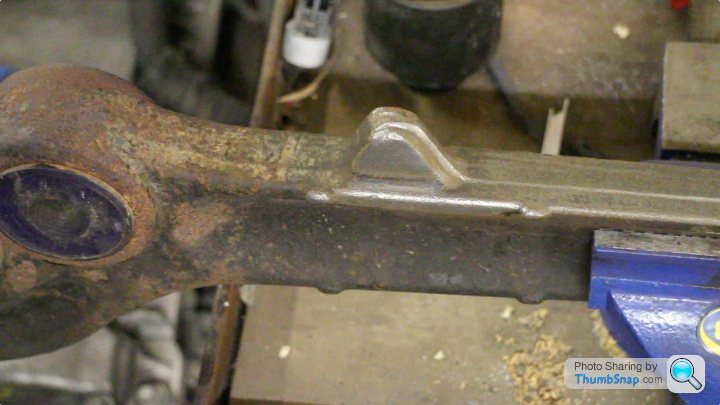
Using a twisted wire cup, started removing the worse of the rust. Really impressed with the cups, they work pretty quickly! A friend removed the superpro bushes using threaded bar - as they are a one piece construction, you'd need an 8" vice and suitable drifts e.t.c.
I'm hoping to go collect my bulkhead and axles: here's a sample from the video I shot whilst I was there on Monday
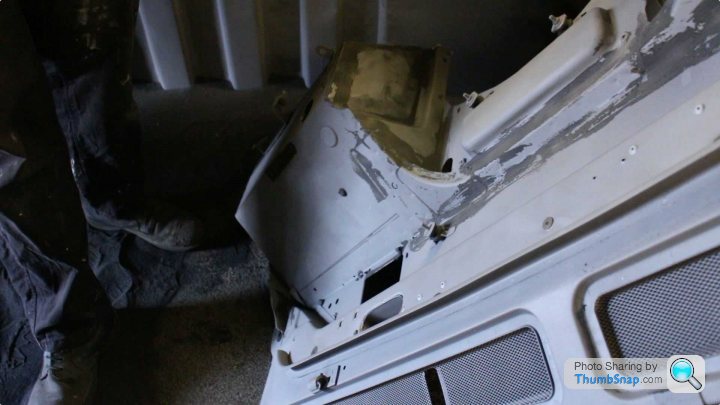
It's brought it up lovely! Much less welding needed than I thought, then off to galvanisers :shock:
More progress made, a little gutted that my axles and bullhead won't be finished till next week - could slow me down a bit. I had help off my mate last night, but we didn't have tonnes to do.
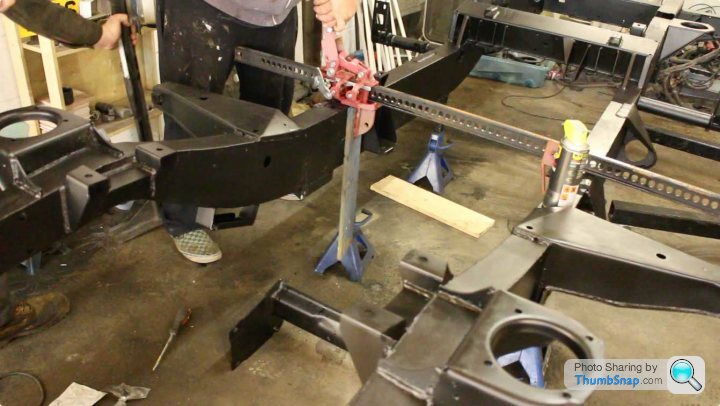
The gearbox crossmember is in. These require a slight spreading of the chassis. I do not like farm jacks but it's all that was to hand, so packing it out with wood to protect the chassis and one man operating the jack whilst another hammers the gearbox in. The ends we're coated with grease to make the job a bit easier. Glad to be able to put the farm jack away again, no incidents :thumbsup:
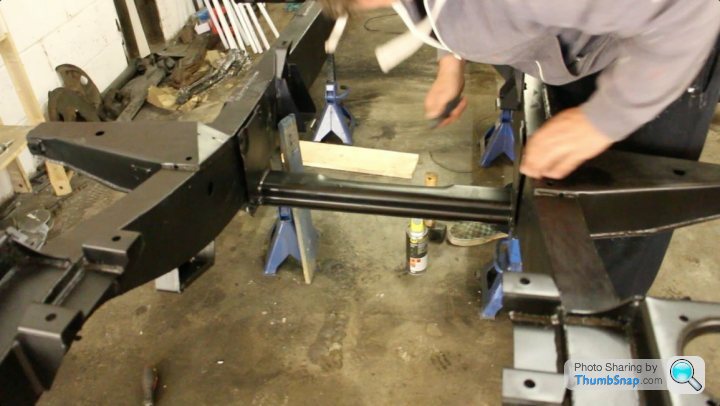
I took delivery of this fantastic bit of kit from SIP Industrial products. It cut right through the CV shaft grease and means they are ready for rebuilding.

I've filled it with paraffin for now, am waiting on some proper parts washer fluid for items I want to paint afterwards.
The rear upper link arms still had metaplastic bushes fitted. These were totally shot, they were burned out:

Then it's a case of cleaning off all the cast parts, going from this:
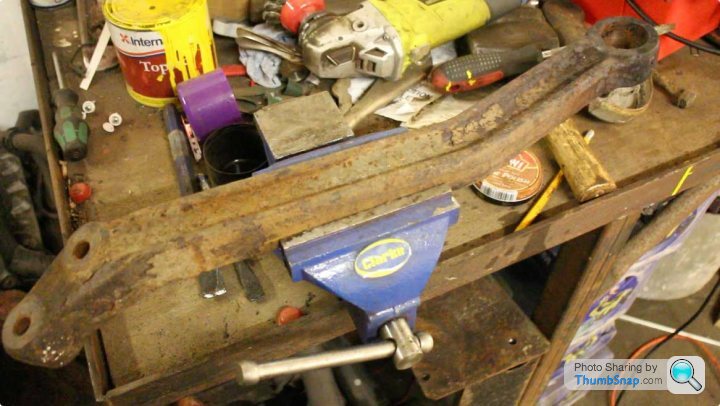
Using a twisted wire cup
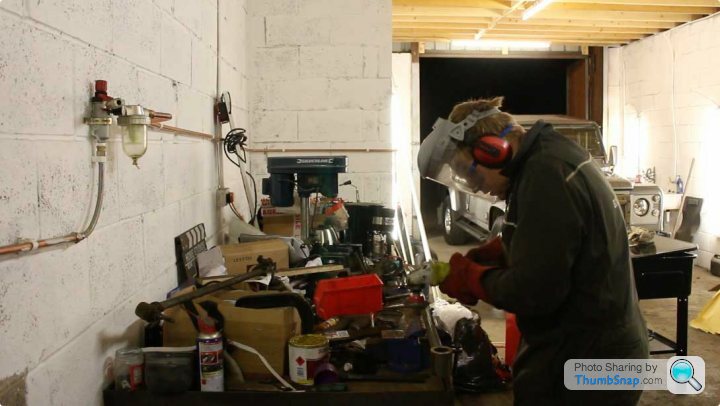
Was a late night for me. Here's how they looked afterwards. I'l treat them to some anti-rust agent then etch prime and paint them satin black to match. There'll be no blingy bits underneath.

Also, couldn't wait to start fitting new bits and bobs, so....
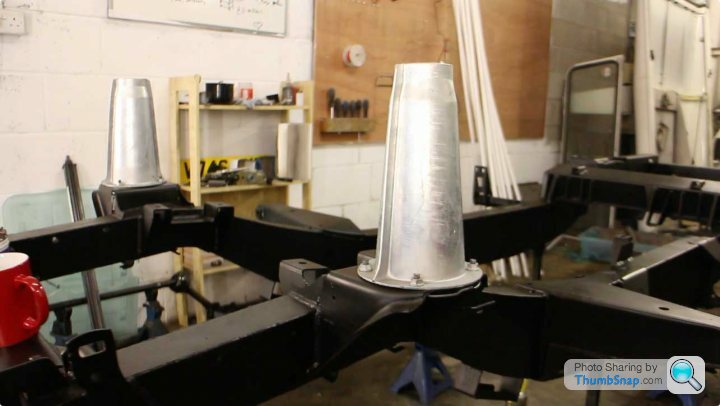
I'm going with a standard suspension set-up.

The gearbox crossmember is in. These require a slight spreading of the chassis. I do not like farm jacks but it's all that was to hand, so packing it out with wood to protect the chassis and one man operating the jack whilst another hammers the gearbox in. The ends we're coated with grease to make the job a bit easier. Glad to be able to put the farm jack away again, no incidents :thumbsup:

I took delivery of this fantastic bit of kit from SIP Industrial products. It cut right through the CV shaft grease and means they are ready for rebuilding.

I've filled it with paraffin for now, am waiting on some proper parts washer fluid for items I want to paint afterwards.
The rear upper link arms still had metaplastic bushes fitted. These were totally shot, they were burned out:

Then it's a case of cleaning off all the cast parts, going from this:

Using a twisted wire cup

Was a late night for me. Here's how they looked afterwards. I'l treat them to some anti-rust agent then etch prime and paint them satin black to match. There'll be no blingy bits underneath.

Also, couldn't wait to start fitting new bits and bobs, so....

I'm going with a standard suspension set-up.
Episode 05 is out here:
https://www.youtube.com/watch?v=aTuVt1WY3E4
So, since the last update, the following has happened.
After giving the parts a thorough clean, using a combination of wire brushing, degreasing and the parts washer:
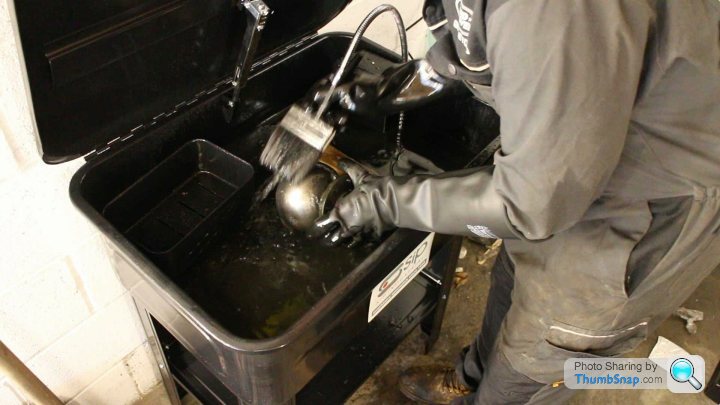
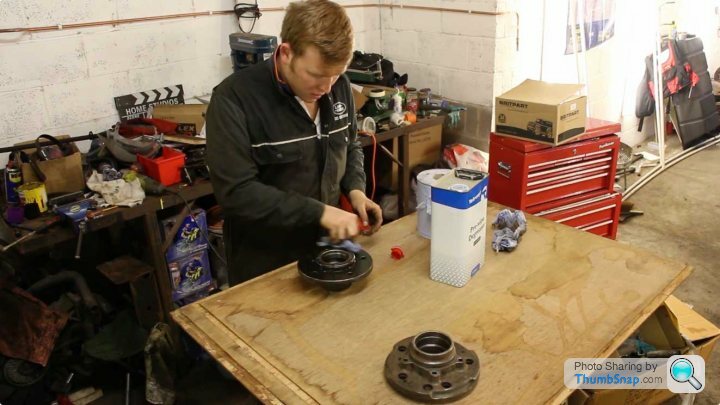
The items were then masked up:
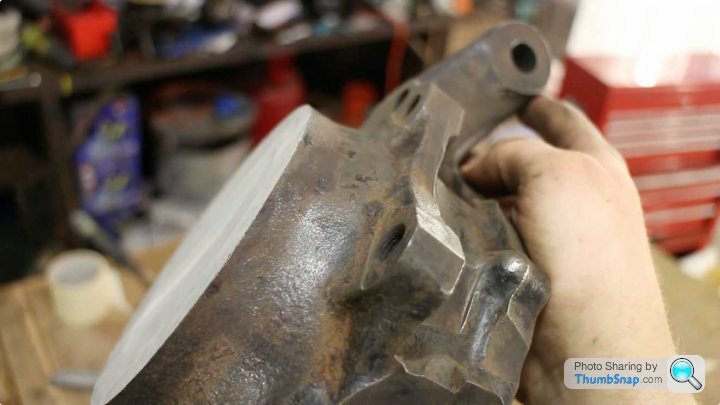
Hung up for painting on an industrial clothing rail:
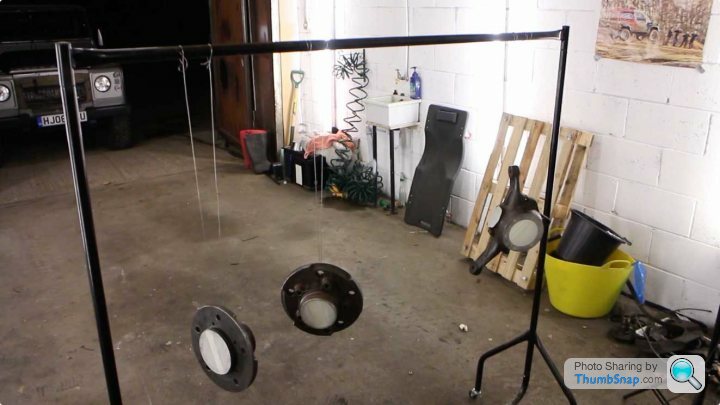
Or slotted into some holes we drilled in a palette for things like the arms:
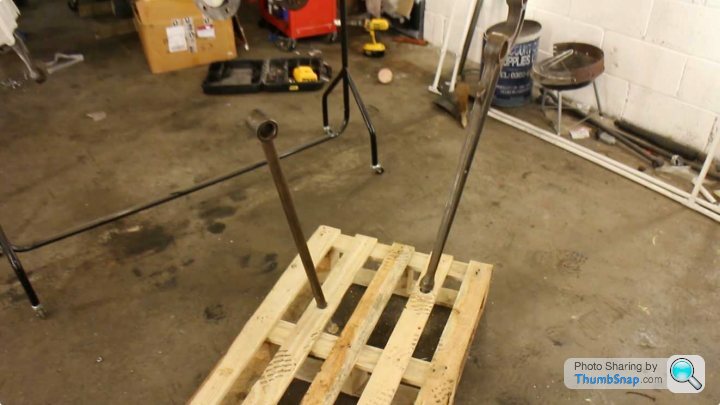
And hit with some etch primer:

Then, all the fixings on the chassis added so far were treated with M1 Corrosion protector (like ACF50, but cheaper)

Fitted the bump stops:
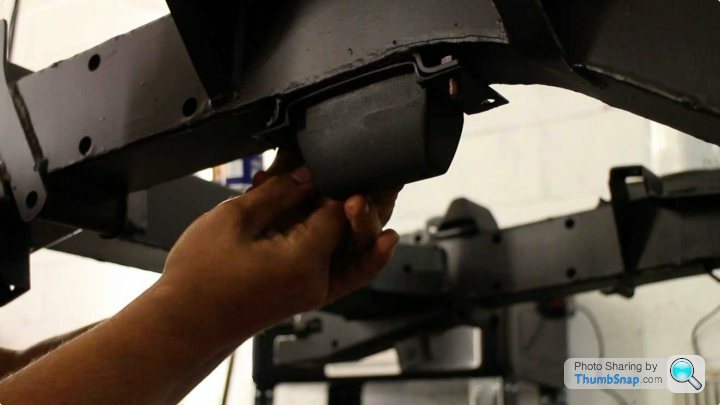
And today I can go collect the bulkhead and axles!
https://www.youtube.com/watch?v=aTuVt1WY3E4
So, since the last update, the following has happened.
After giving the parts a thorough clean, using a combination of wire brushing, degreasing and the parts washer:


The items were then masked up:

Hung up for painting on an industrial clothing rail:

Or slotted into some holes we drilled in a palette for things like the arms:

And hit with some etch primer:

Then, all the fixings on the chassis added so far were treated with M1 Corrosion protector (like ACF50, but cheaper)

Fitted the bump stops:

And today I can go collect the bulkhead and axles!
Righto, things happened yesterday :thumbsup:
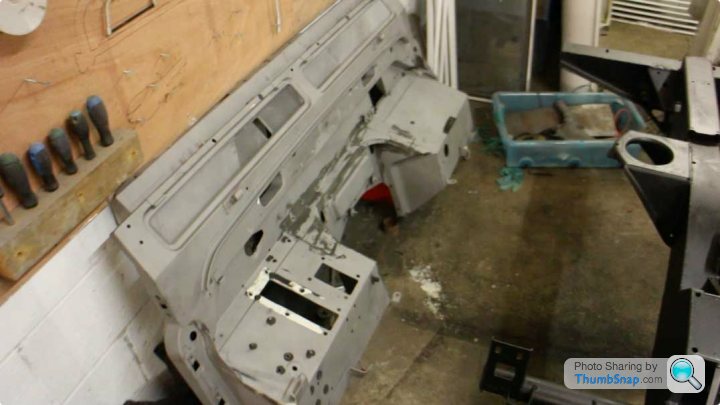
Collected the bulkhead and axles form the shot blasters. The bulkhead has come up very nice! Not as much welding needed as I thought so well worth having it blasted.
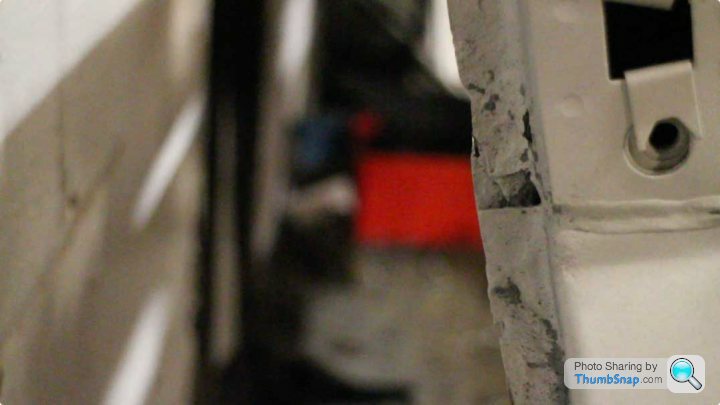
That's not to say I got off welding completely, both pillars will need to be replaced. Then once it's cleaned up, a jig will be welded up and sent to the galvanisers.
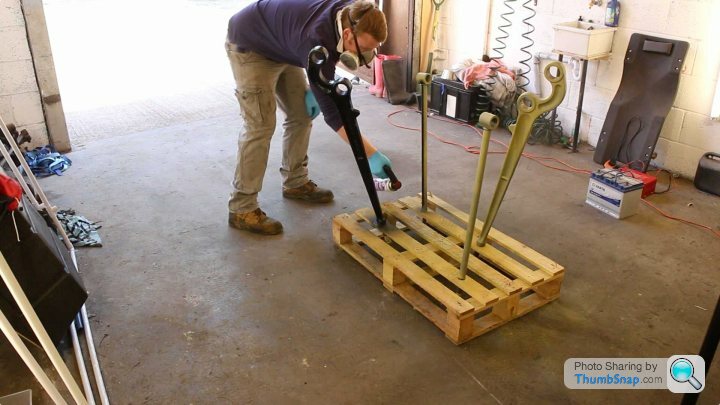
Here, all the underbody parts that prepped are getting a top coat of satin black like the chassis. These have cured to a pleasing finish. The masking trick worked perfectly
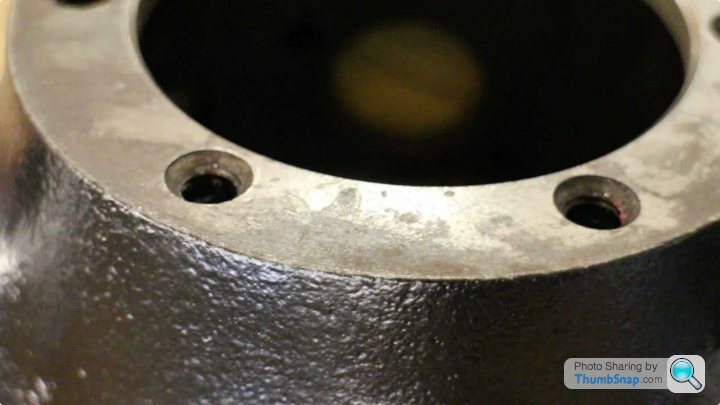
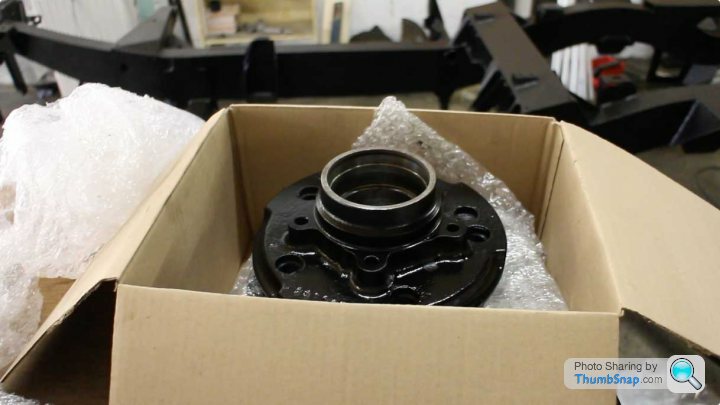
Then once fully cured, the parts are packed up safely until I need them - I'm trying to prevent accidental damage
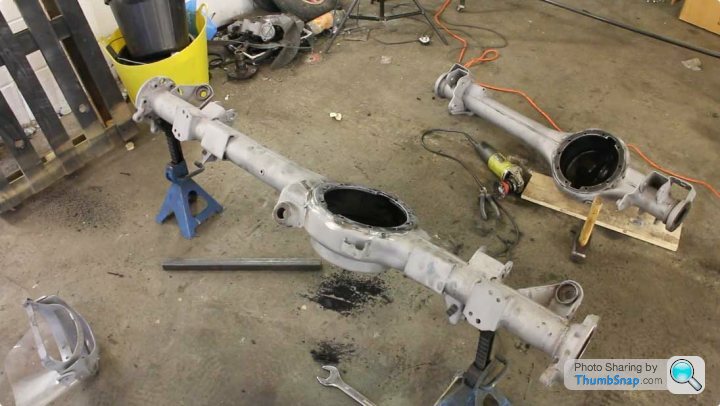
Finally, the axles had some final prep for painting - I'll hit those with etch primer e.t.c as before. I'll then clean the internals throughly and the final drive case - bolt the lot back together and paint it!
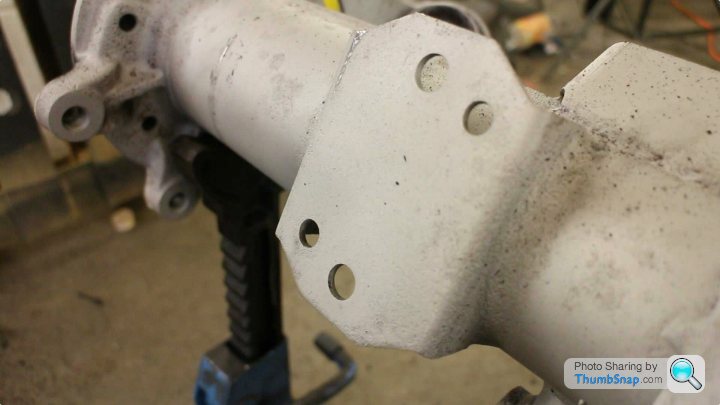
This is how the everything looks so far, great finish from the blasters - who've recommended that I hit everything with 60 - 80 grit paper. I'll see if it seems necessary.

Collected the bulkhead and axles form the shot blasters. The bulkhead has come up very nice! Not as much welding needed as I thought so well worth having it blasted.

That's not to say I got off welding completely, both pillars will need to be replaced. Then once it's cleaned up, a jig will be welded up and sent to the galvanisers.

Here, all the underbody parts that prepped are getting a top coat of satin black like the chassis. These have cured to a pleasing finish. The masking trick worked perfectly



Then once fully cured, the parts are packed up safely until I need them - I'm trying to prevent accidental damage

Finally, the axles had some final prep for painting - I'll hit those with etch primer e.t.c as before. I'll then clean the internals throughly and the final drive case - bolt the lot back together and paint it!

This is how the everything looks so far, great finish from the blasters - who've recommended that I hit everything with 60 - 80 grit paper. I'll see if it seems necessary.
FWDRacer said:
Just rebuilt a Mini. This is other UK motoring icon I need in my life. Proper job=Bookmarked.
Carry on.
And I've yet to own a mini, we should do a swap for a day Carry on.

SPT28 said:
Excellent work so far, love the fact it's like a big Meccano kit. 
Must get round to giving my brothers series III some tlc at some point.
Bookmarked.
When people say they are Meccano it is so true! Someone walked into the workshop the other day and could not believe that the whole Landy was in there, it looks like a pile of odds and ends.
Must get round to giving my brothers series III some tlc at some point.
Bookmarked.
Ok, so Episode 06 is out now:
https://www.youtube.com/watch?v=2AAGJPHGHvE
Here's what I've been up to over the last week. I sold my 110 for a start, which is partly why I've had no time to be posting :thumbsup:
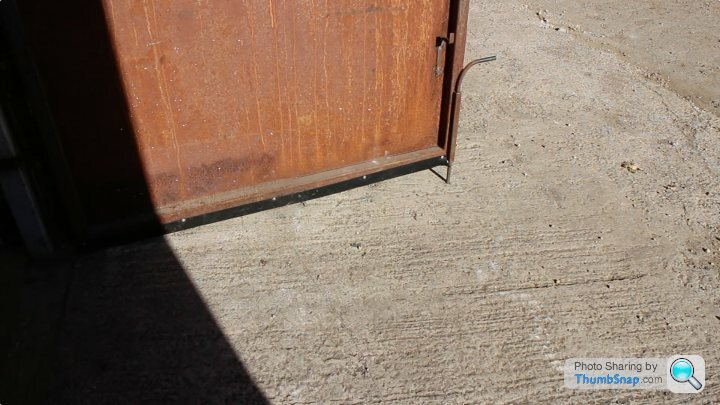
Took the opportunity of perhaps the last bit of good weather to fit a weather sealing strip, should stop the dust blowing under the door in the hard winters we get. :mrgreen:
I then prepped the axles for painting, removing the shot blasting material from the inside of the axles - this would likely make an aggressive grinding paste if there were any left inside.
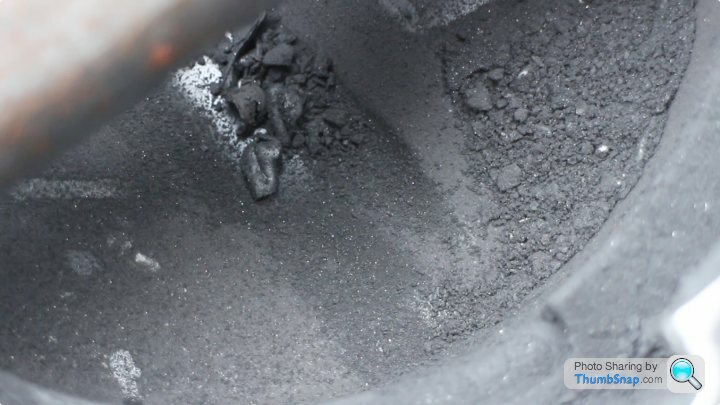
The shot used was an iron oxide of some sort, but was coated on in the intervals of the axle. To remove, I gave the whole lot a through wash with chassis detergent and a sponge.

Placing a scaffold pole through the axle tubes or even bolting some old stub axles on lets you easily rotate the axle on the stands.
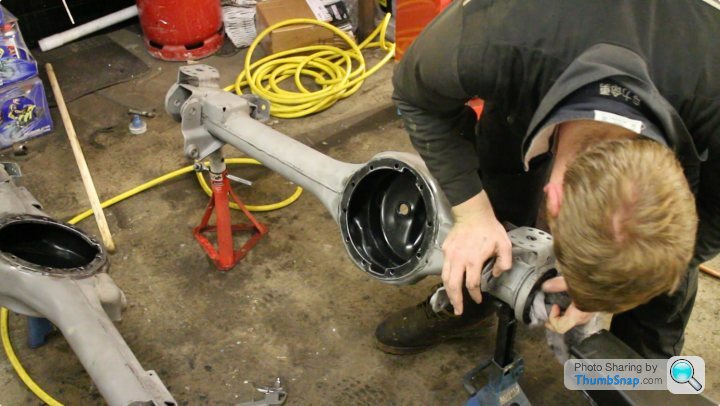
The axles then needed drying completely, before using a solvent soaked rag to clean the internals and outside. The axles were then spotlessly clean, took an hour per axle though
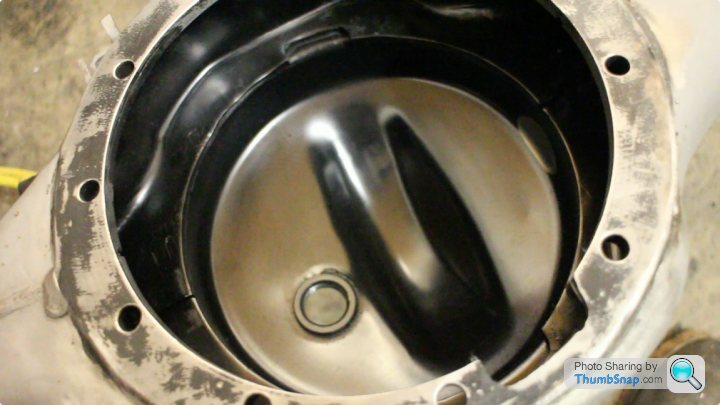
There will be no contamination of the diff oil now!

The diff studs were refitted, ready for the final drive casing.

The final drive casing mating surface after clean up to take RTV sealant.
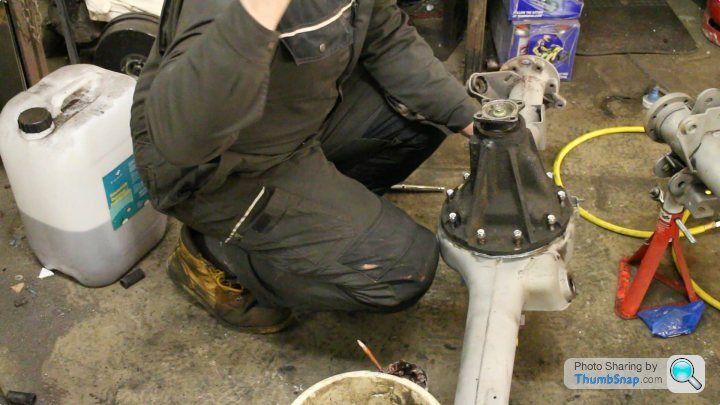
RTV, adding the bits before cinching those down and torqueing up.
After everything is securely sealed up, I can clean the diff casing - preventing the crud falling into the axle or onto the diff.
Then, those were solvent cleaned, etch primed, left to cure and finally painted in satin black

Whilst they dried, I began popping bushes back in. You can fiddle around popping them in with a vice or similar. I found it easier to secure the arm in the vice, then use a large M12 bolt with some thick washers on to pull it through.
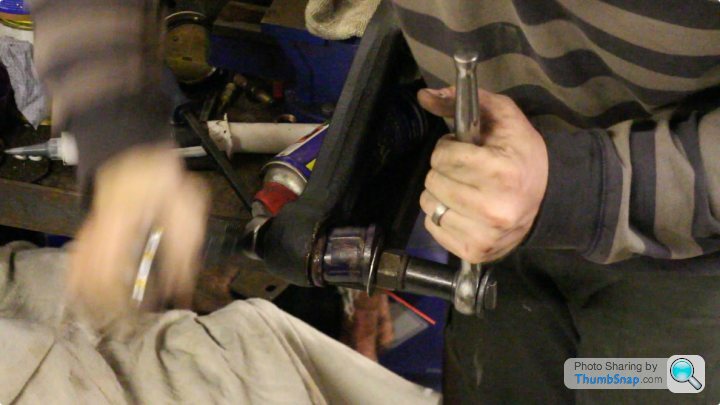
This would work really well if you had to do this at the roadside, a handy homemade 'tool'.
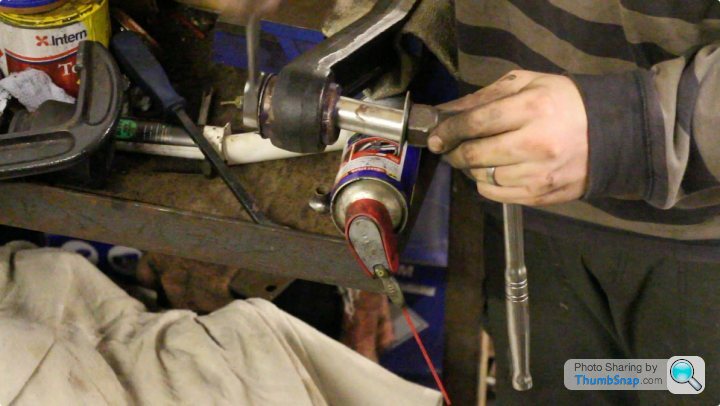
It can also be used to pull the inner race through :thumbsup:
https://www.youtube.com/watch?v=2AAGJPHGHvE
Here's what I've been up to over the last week. I sold my 110 for a start, which is partly why I've had no time to be posting :thumbsup:

Took the opportunity of perhaps the last bit of good weather to fit a weather sealing strip, should stop the dust blowing under the door in the hard winters we get. :mrgreen:
I then prepped the axles for painting, removing the shot blasting material from the inside of the axles - this would likely make an aggressive grinding paste if there were any left inside.

The shot used was an iron oxide of some sort, but was coated on in the intervals of the axle. To remove, I gave the whole lot a through wash with chassis detergent and a sponge.

Placing a scaffold pole through the axle tubes or even bolting some old stub axles on lets you easily rotate the axle on the stands.

The axles then needed drying completely, before using a solvent soaked rag to clean the internals and outside. The axles were then spotlessly clean, took an hour per axle though


There will be no contamination of the diff oil now!

The diff studs were refitted, ready for the final drive casing.

The final drive casing mating surface after clean up to take RTV sealant.

RTV, adding the bits before cinching those down and torqueing up.
After everything is securely sealed up, I can clean the diff casing - preventing the crud falling into the axle or onto the diff.
Then, those were solvent cleaned, etch primed, left to cure and finally painted in satin black

Whilst they dried, I began popping bushes back in. You can fiddle around popping them in with a vice or similar. I found it easier to secure the arm in the vice, then use a large M12 bolt with some thick washers on to pull it through.

This would work really well if you had to do this at the roadside, a handy homemade 'tool'.

It can also be used to pull the inner race through :thumbsup:
https://www.youtube.com/watch?v=KXJ2gZGAUoI
The axles are painted! And looking superb! Love the Frost Chassis paint :thumbsup:
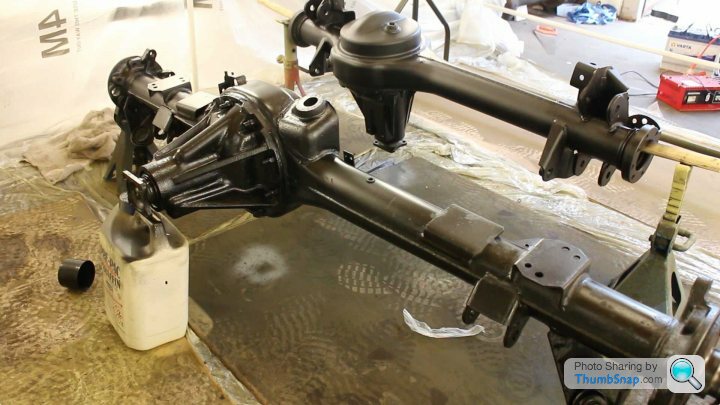
Also, purchased a printed TD5 Defender manual with the 300TDi and Electrical supplements, pricey but worth it for a job like this.
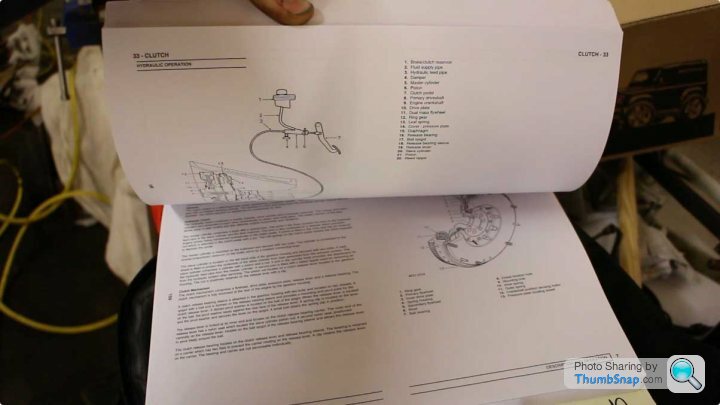
Picked up a new A frame Fulcrum bracket with the ball joint pressed in, saves me the hassle as I don't have a press and these aren't too pricey to buy pre-done.
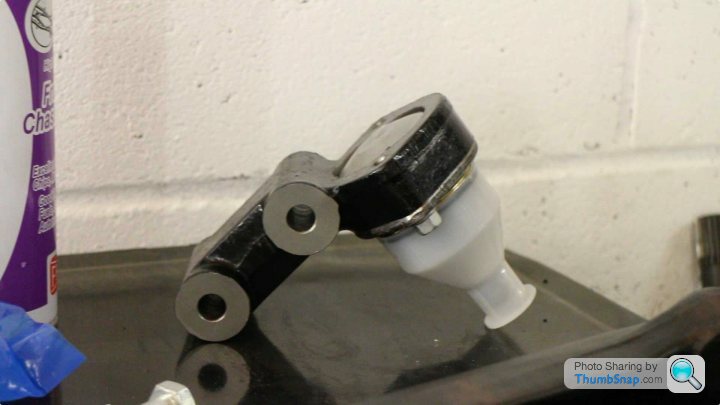
That was all bolted together, using genuine bolts just to be safe.

I applied copper slip liberally - I don't want any trouble if I ever need to disassemble these parts.
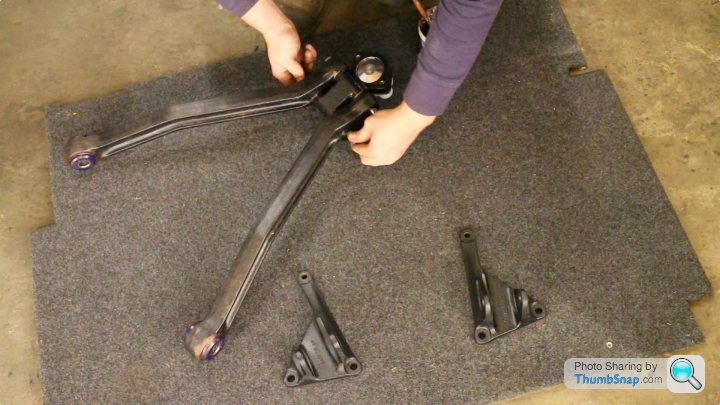
I then bolted the brackets into place, the manual says to not torque everything down till it's in place
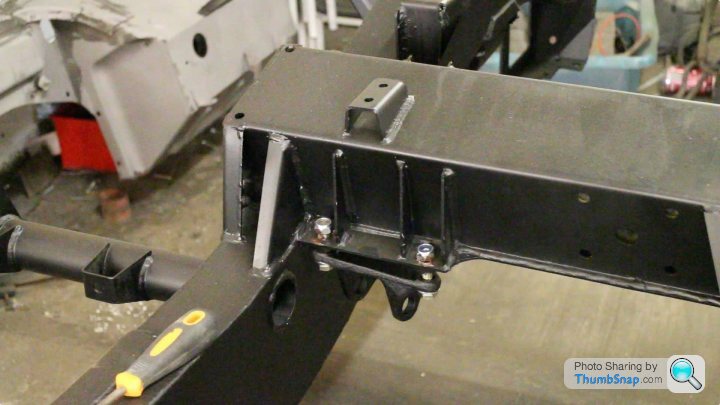
The A Frame was then lifted into place and nipped up, but not fully, I'll do that when the axle is in place.
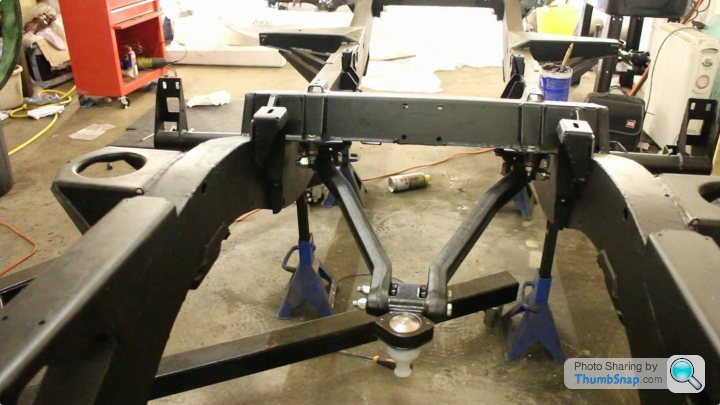
Also bolted on the damper brackets, these ones are not handed, but the manual appears to show them as though they are.
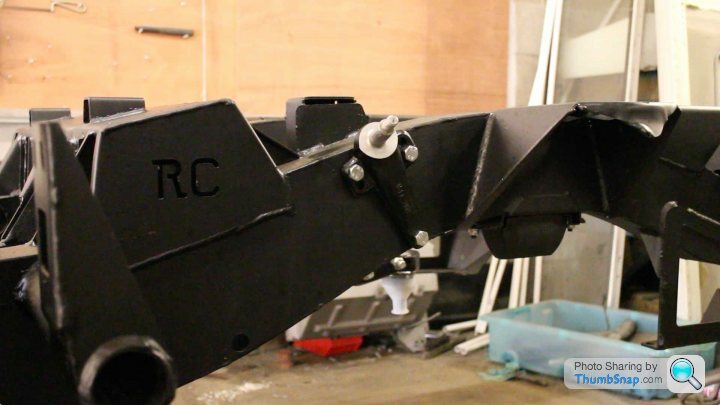
I took the chance this week to set-up the shot blasting cabinet. This one came from Frost.co.uk, they are a good company to work with and have a lot of stuff that's of interest to vehicle restorers. I'm running the cabinet with recycled (crushed) glass - it's cheap at around £5 per 25kg.
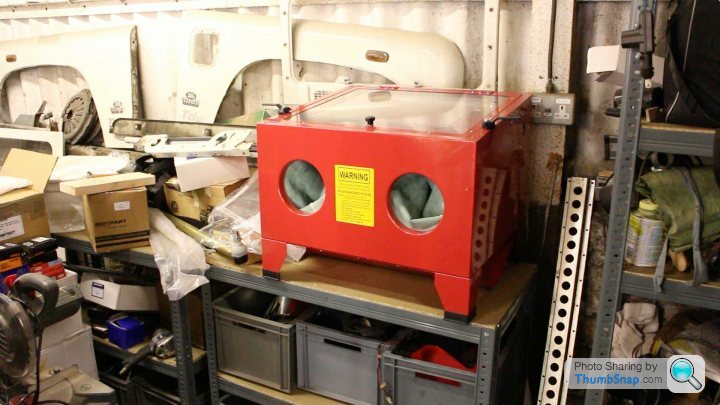
The cabinet has been completely indispensable. Rather than having to replace all those little brackets that quickly add-up the costs - I've been ablate last them, restoring them to as new condition. It's brilliant. I'm going to refurb the callipers using this cabinet :thumbsup:
Here's a before and after (needs a little more blasting, but this was about 1 minutes work)
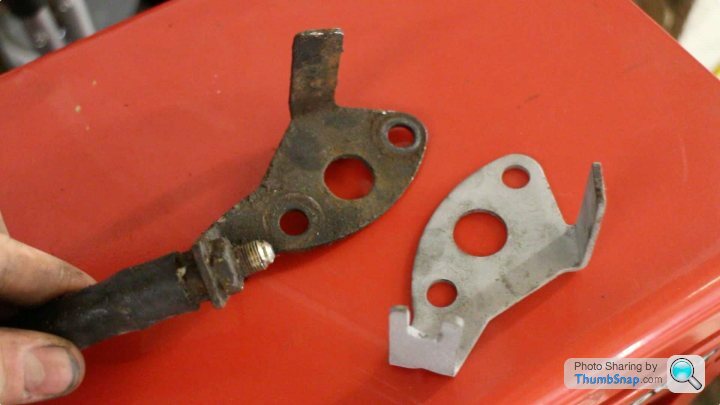
The axles are painted! And looking superb! Love the Frost Chassis paint :thumbsup:

Also, purchased a printed TD5 Defender manual with the 300TDi and Electrical supplements, pricey but worth it for a job like this.

Picked up a new A frame Fulcrum bracket with the ball joint pressed in, saves me the hassle as I don't have a press and these aren't too pricey to buy pre-done.

That was all bolted together, using genuine bolts just to be safe.

I applied copper slip liberally - I don't want any trouble if I ever need to disassemble these parts.

I then bolted the brackets into place, the manual says to not torque everything down till it's in place

The A Frame was then lifted into place and nipped up, but not fully, I'll do that when the axle is in place.

Also bolted on the damper brackets, these ones are not handed, but the manual appears to show them as though they are.

I took the chance this week to set-up the shot blasting cabinet. This one came from Frost.co.uk, they are a good company to work with and have a lot of stuff that's of interest to vehicle restorers. I'm running the cabinet with recycled (crushed) glass - it's cheap at around £5 per 25kg.

The cabinet has been completely indispensable. Rather than having to replace all those little brackets that quickly add-up the costs - I've been ablate last them, restoring them to as new condition. It's brilliant. I'm going to refurb the callipers using this cabinet :thumbsup:
Here's a before and after (needs a little more blasting, but this was about 1 minutes work)

https://www.youtube.com/watch?v=zr_aOIxhuBw
What have we been up to this week with our Tribute build?

First up, we set about finishing the swivels from last time. The pre-load had to be set using shims on the upper pin - a time consuming process to say the least.

You'll need a spring balance, which can be found cheaply online or at a fishing supplies shop.
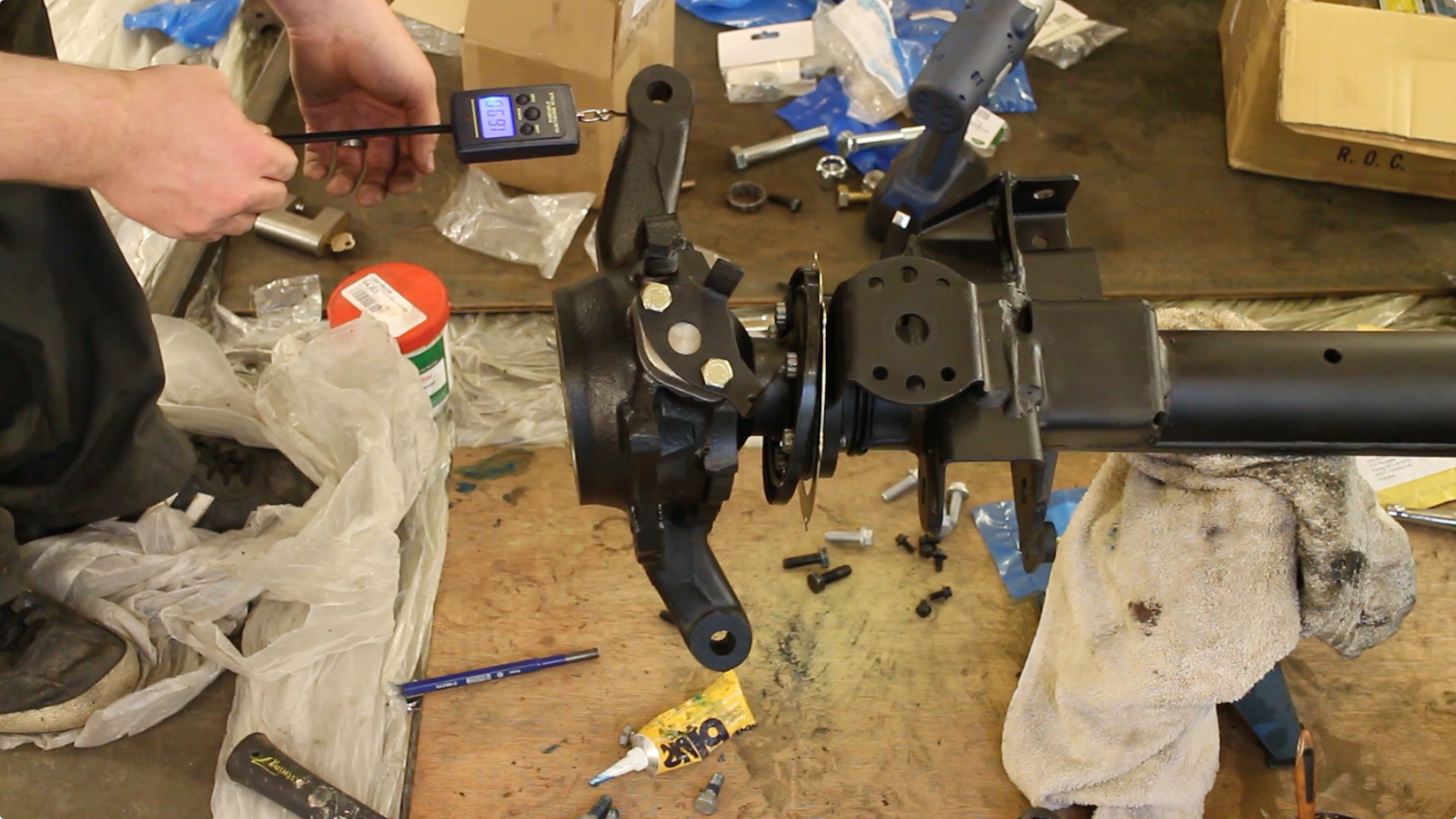
We're looking for a constant pull between 1.2kg and 1.4kg. If you're reading over the number, you need more shims, if you're below, you need to remove some. Be careful not to crank it down with such a high pre-load that you buckle the bearing race.
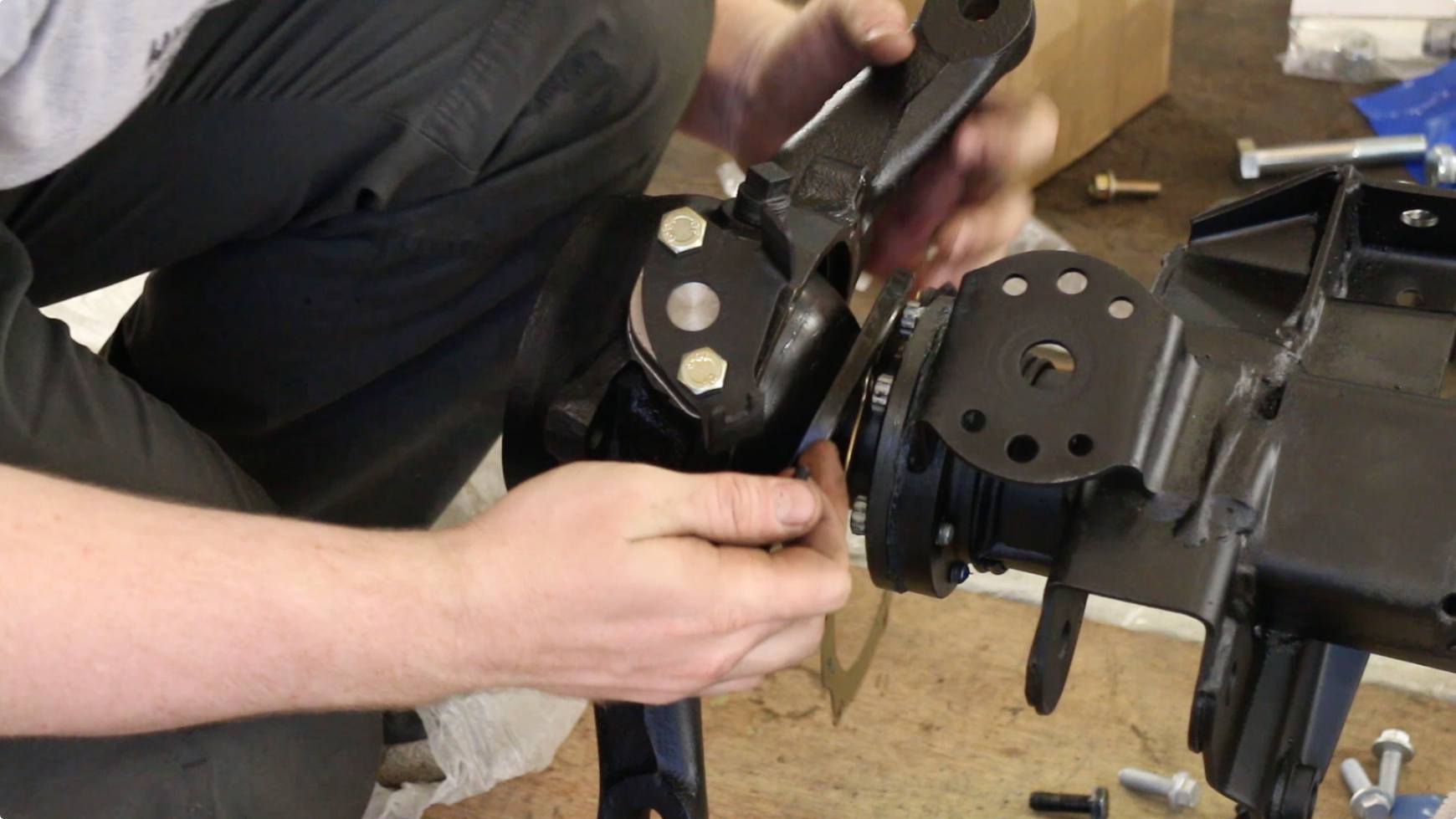
Then the oil seal and retainer plate need fitting. These lock down with small bolts and are torqued to 11nm.

The steering stop lock bolt was added at both sides too, this will need adjusting later.
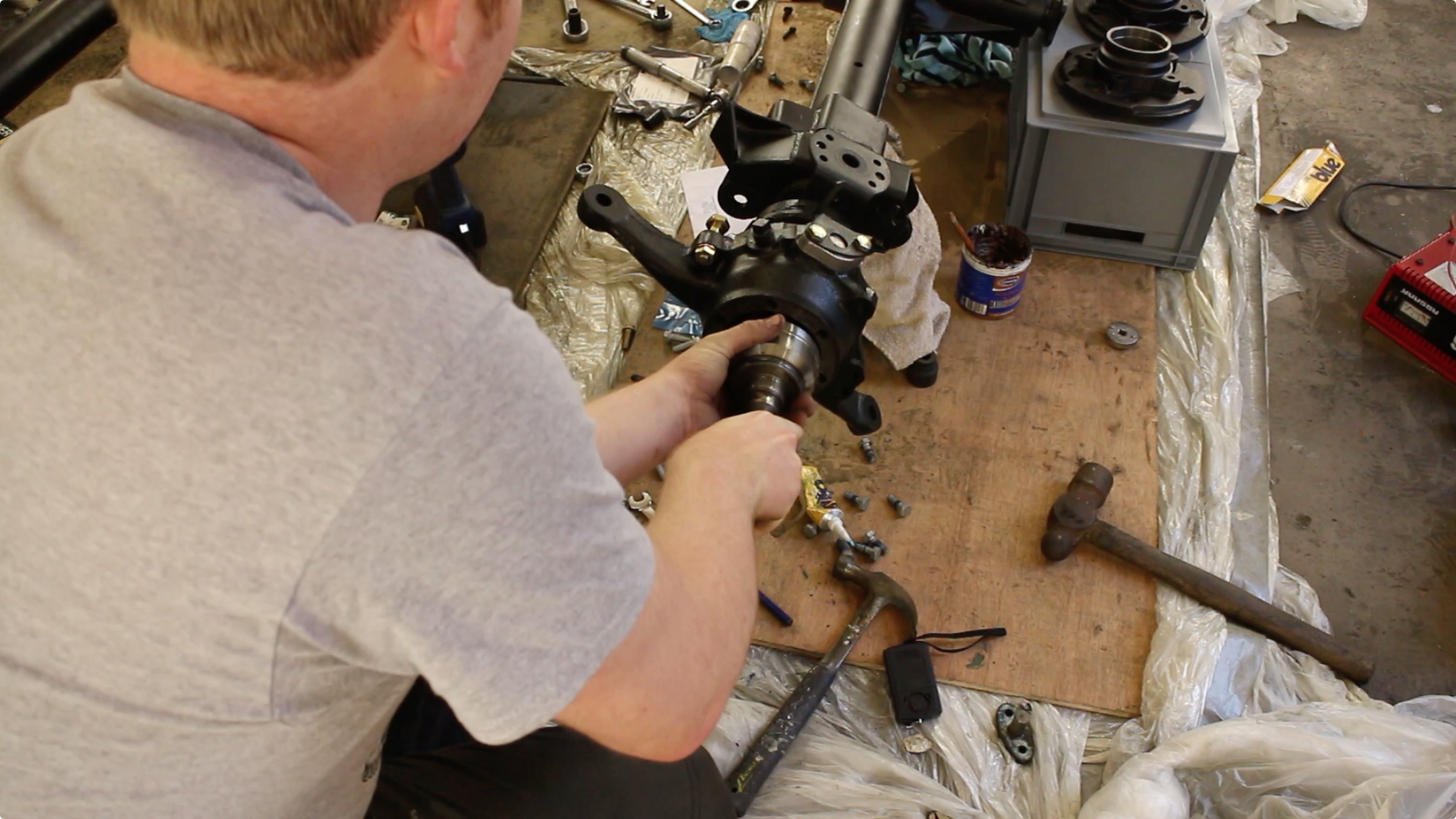
Once the swivels we're correctly pre-loaded, we slid the cv and half shaft into place, feeling for the splines on the final drive unit to match with the half shaft end before gently pushing it home.
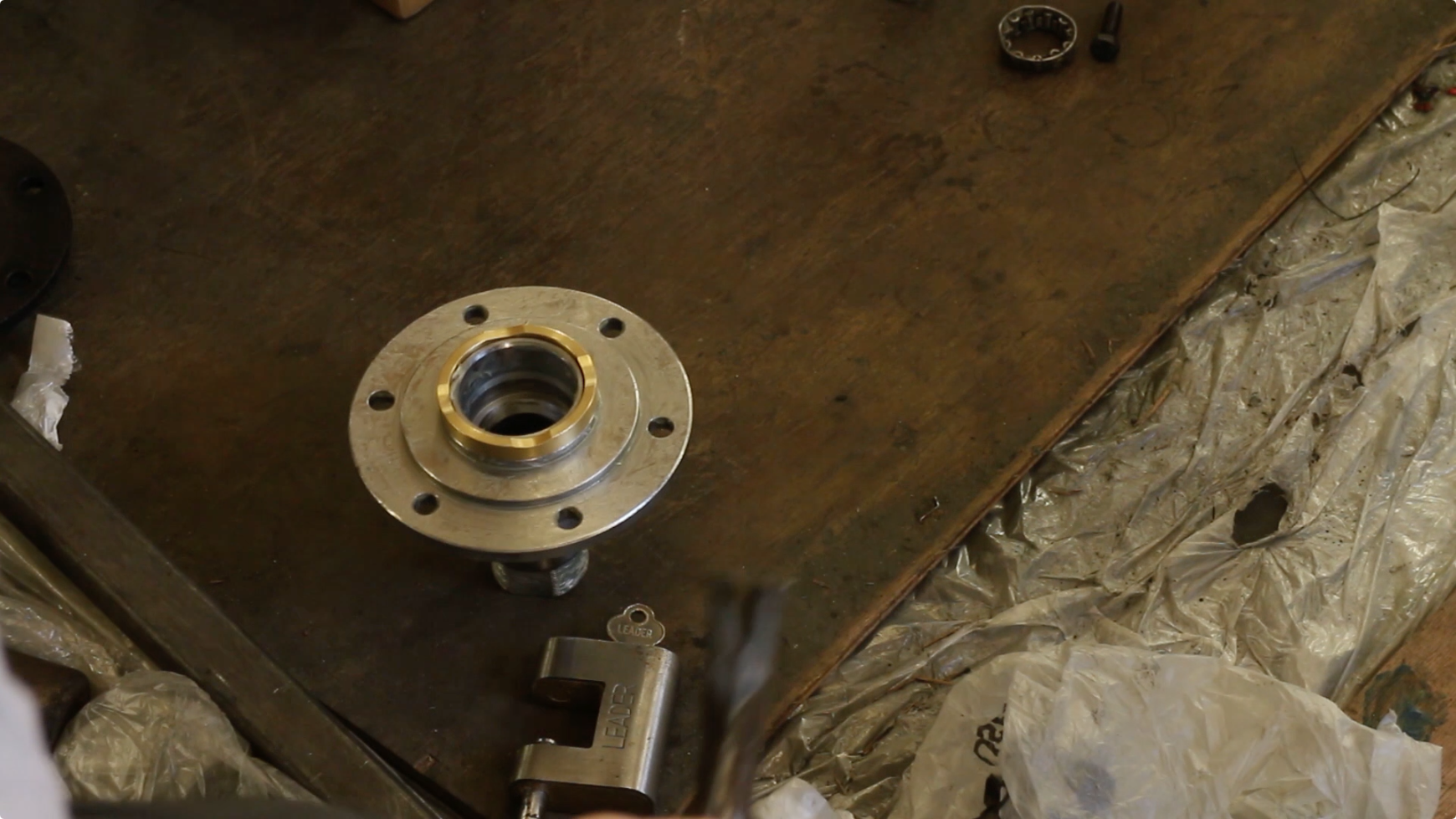
Using a piece of plywood to prevent damage, the brass bushing on the back of the stub axle can be tapped into place. To fit the roller bearing, we used an old cv joint as a bearing setter. Worked very well!
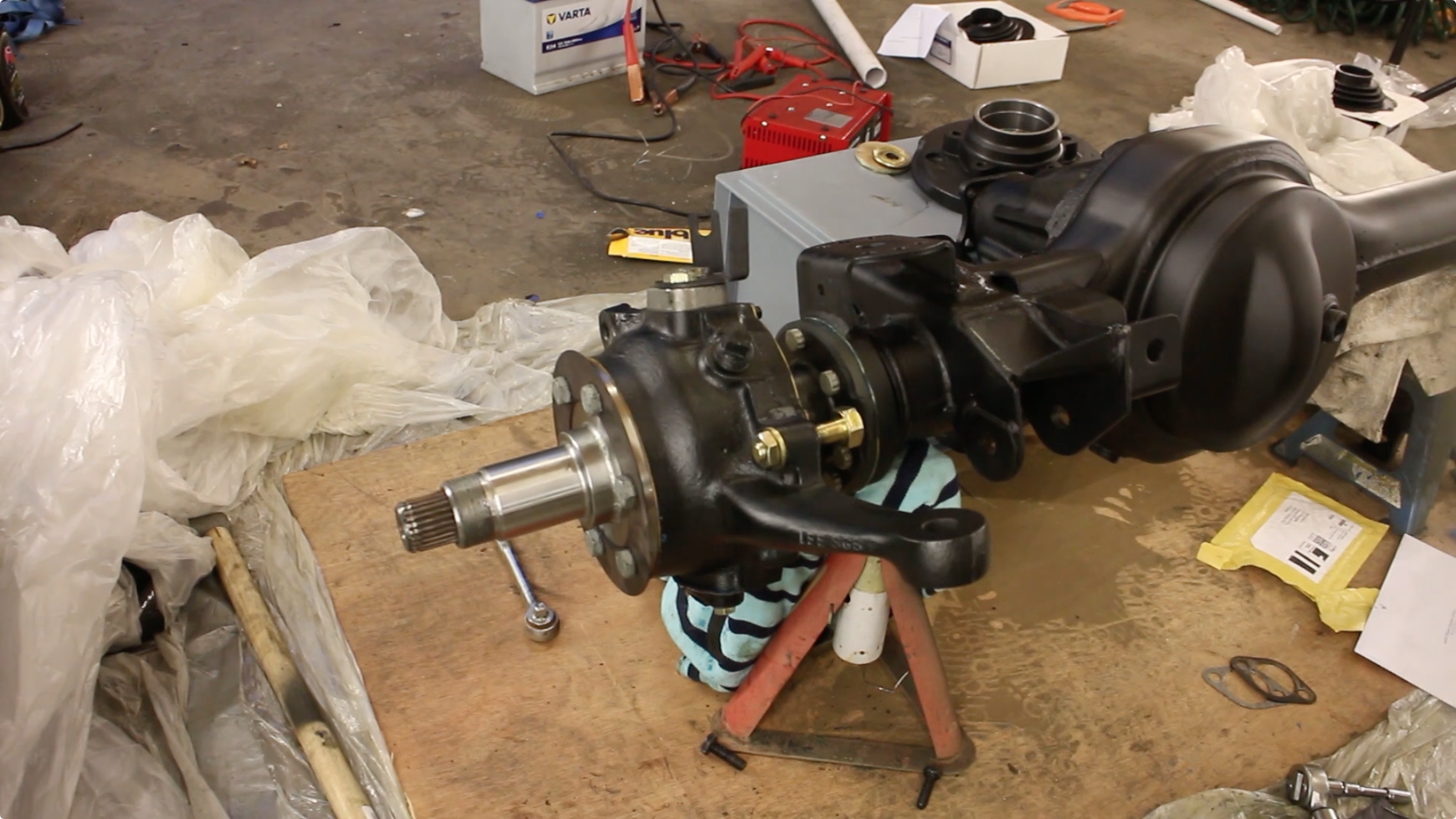
The stub axles can then be bolted on using the correct tensile strength stub axle bolts, with thread lock.
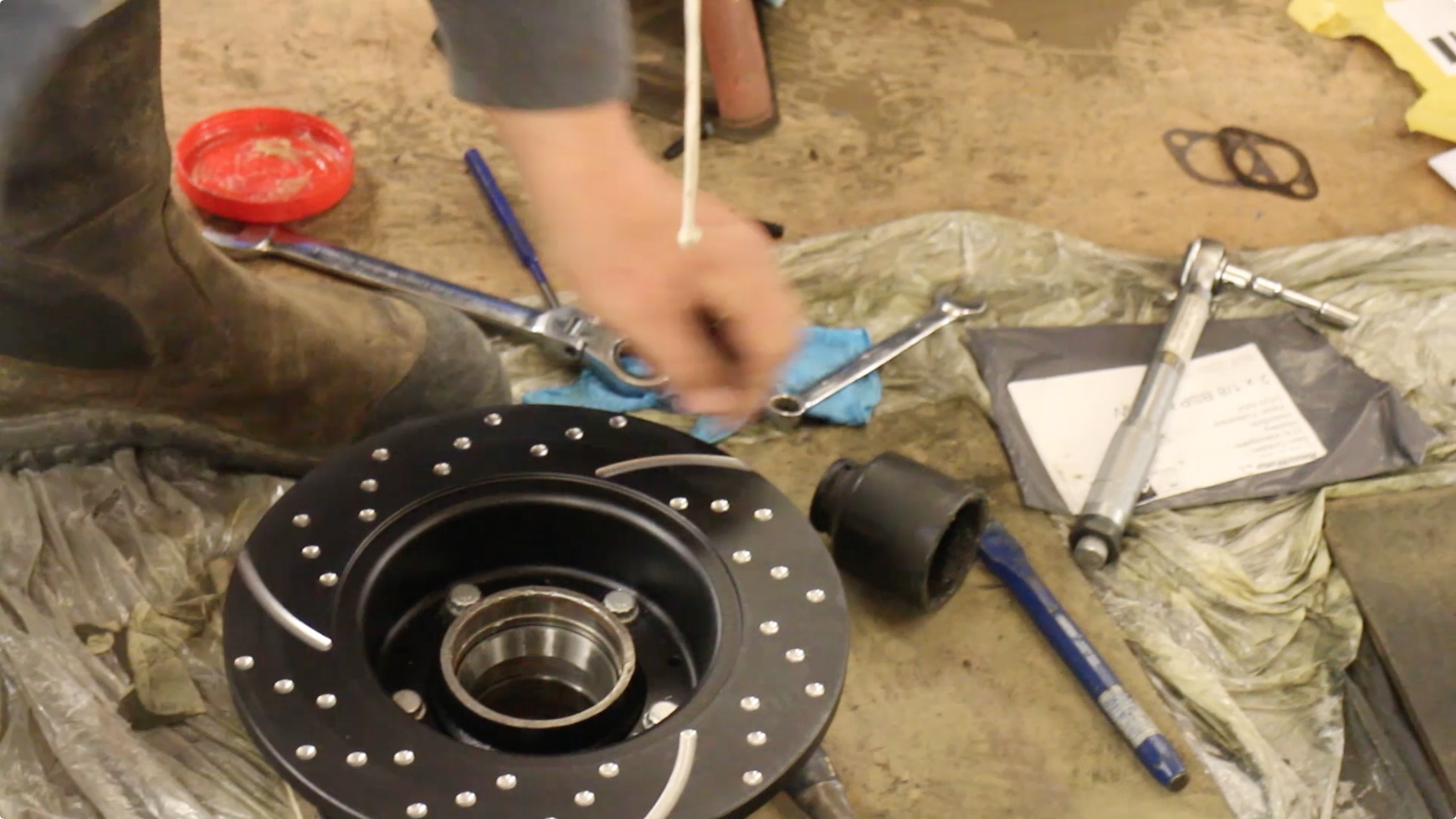
The new discs are from EBC and look awesome! Hopefully they'll provide superior braking capability thanks to the drilled and slotted brake surface.

The hub bearings were then fitted as well as the oil seal and adjusted correctly, before flatting the lock washer around the two hub nuts.
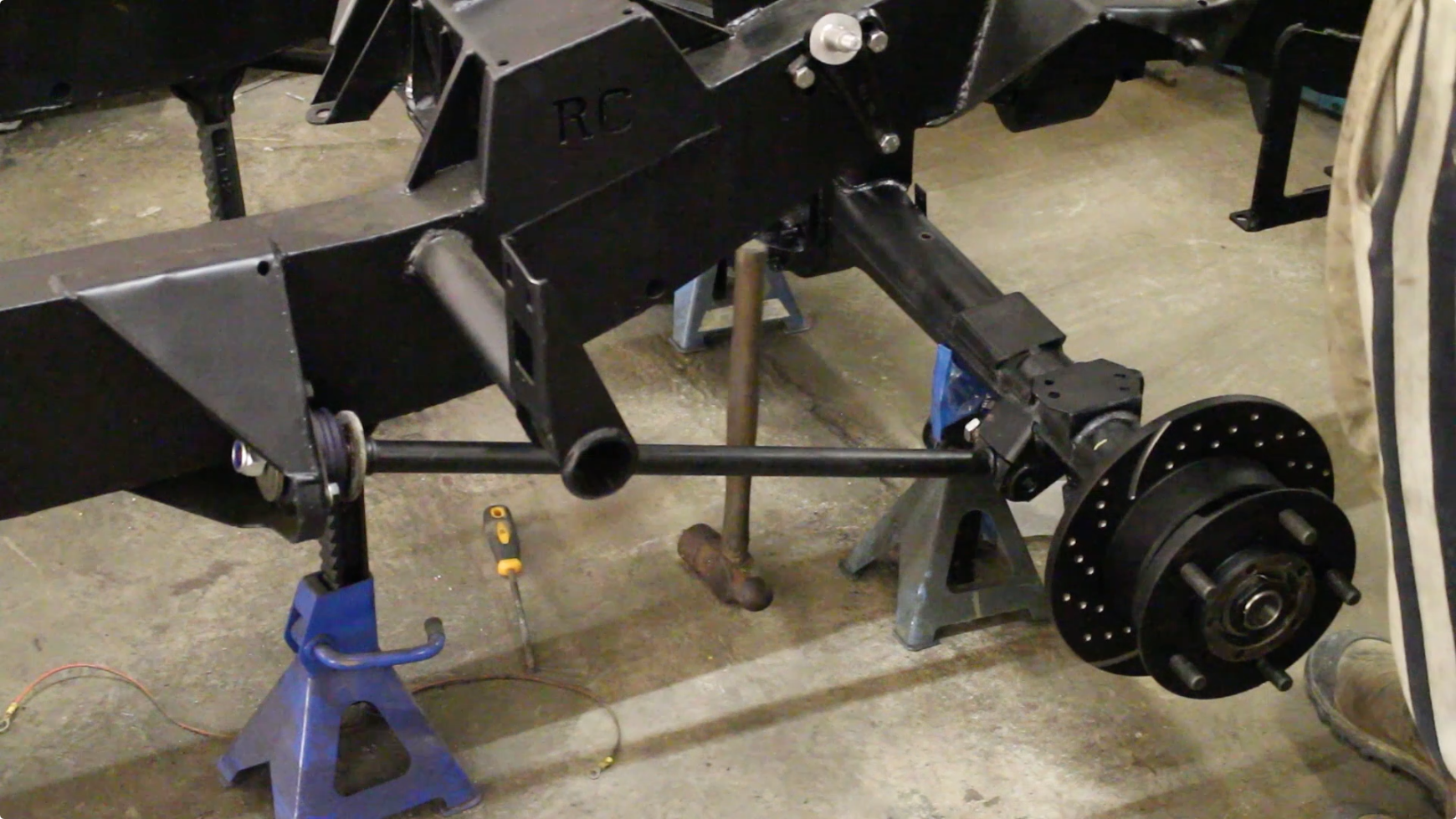
Then we positioned the axle under the rear of the chassis and connected it to the trailing arms, as well as dropping in the a frame ball joint.
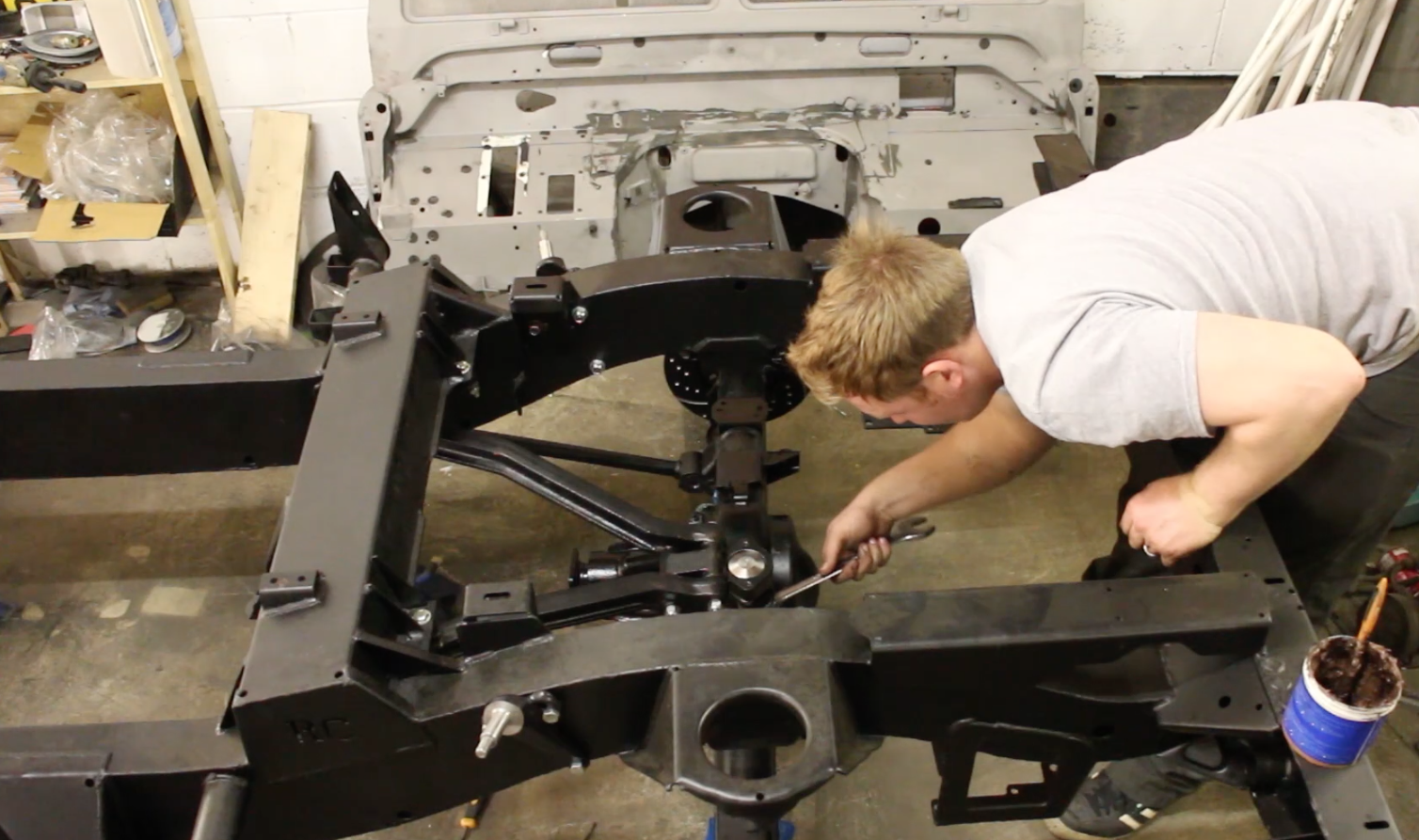
The a frame castellated nut needs tightening and then the split pin pushing through
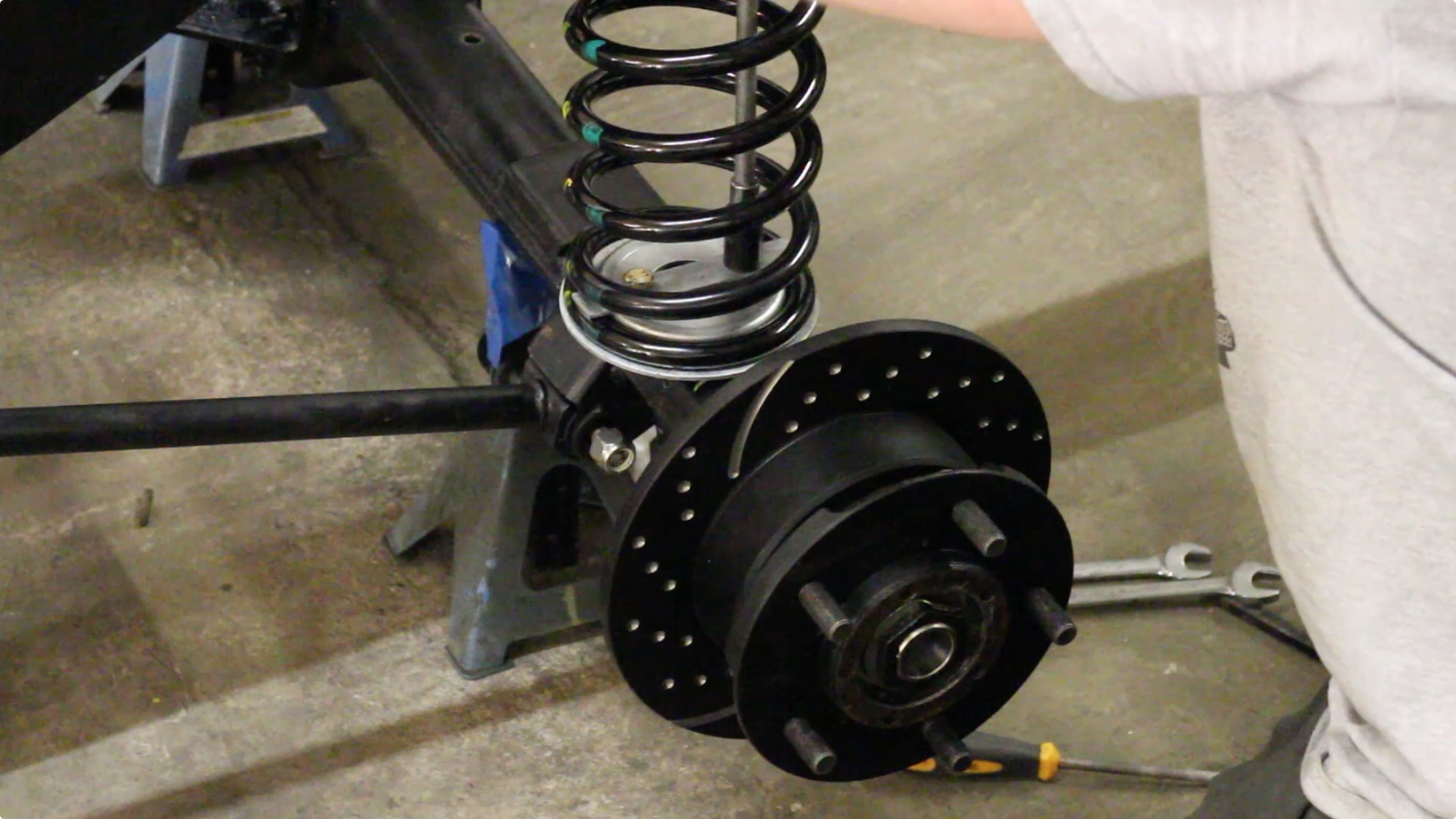
The springs and dampers could then be fitted, along with some nice galvanised seats and retainer plates.

The wheels were then temporarily bolted on. These are not the final wheels we'll be using - those haven't been painted yet. These are just to allow us to shunt the chassis around the workshop.
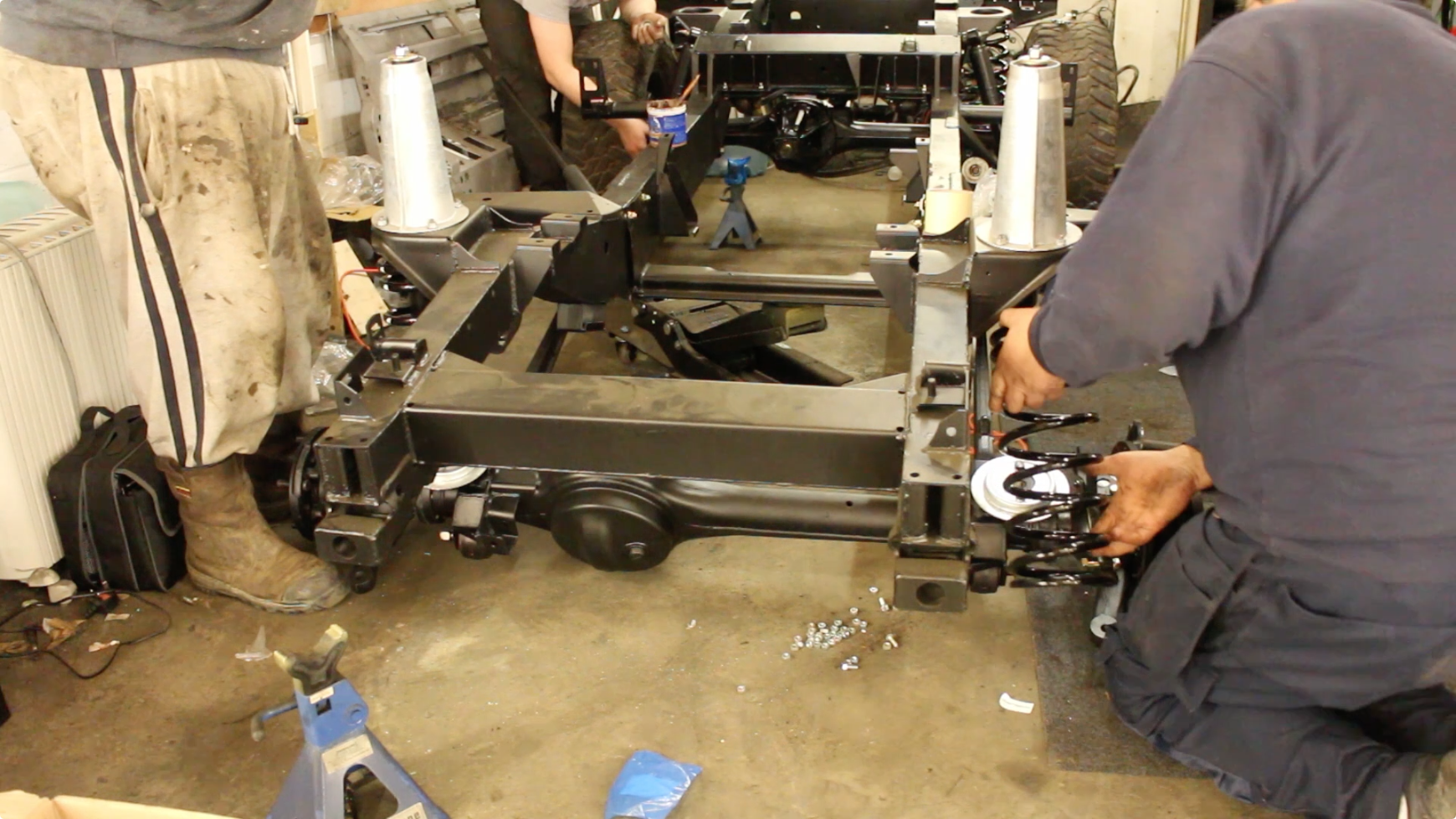
Then the springs and shocks were offered up - working with standard, non-gas filled shocks is a bit of a treat as they don't want to rapidly expand!
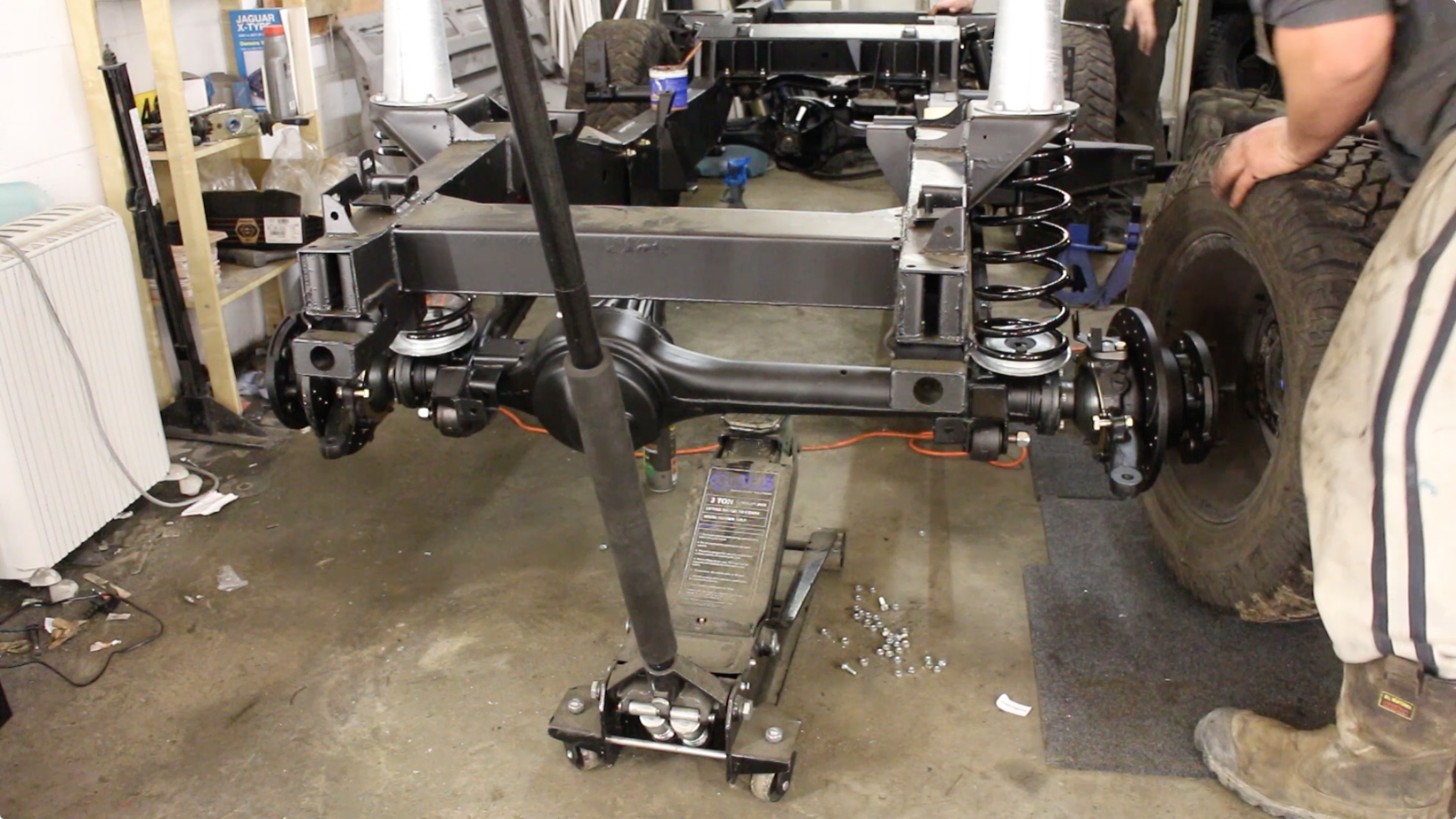
Then the front boots can be chucked on. These will be up for sale once the build is finished as they are surplus to requirements.
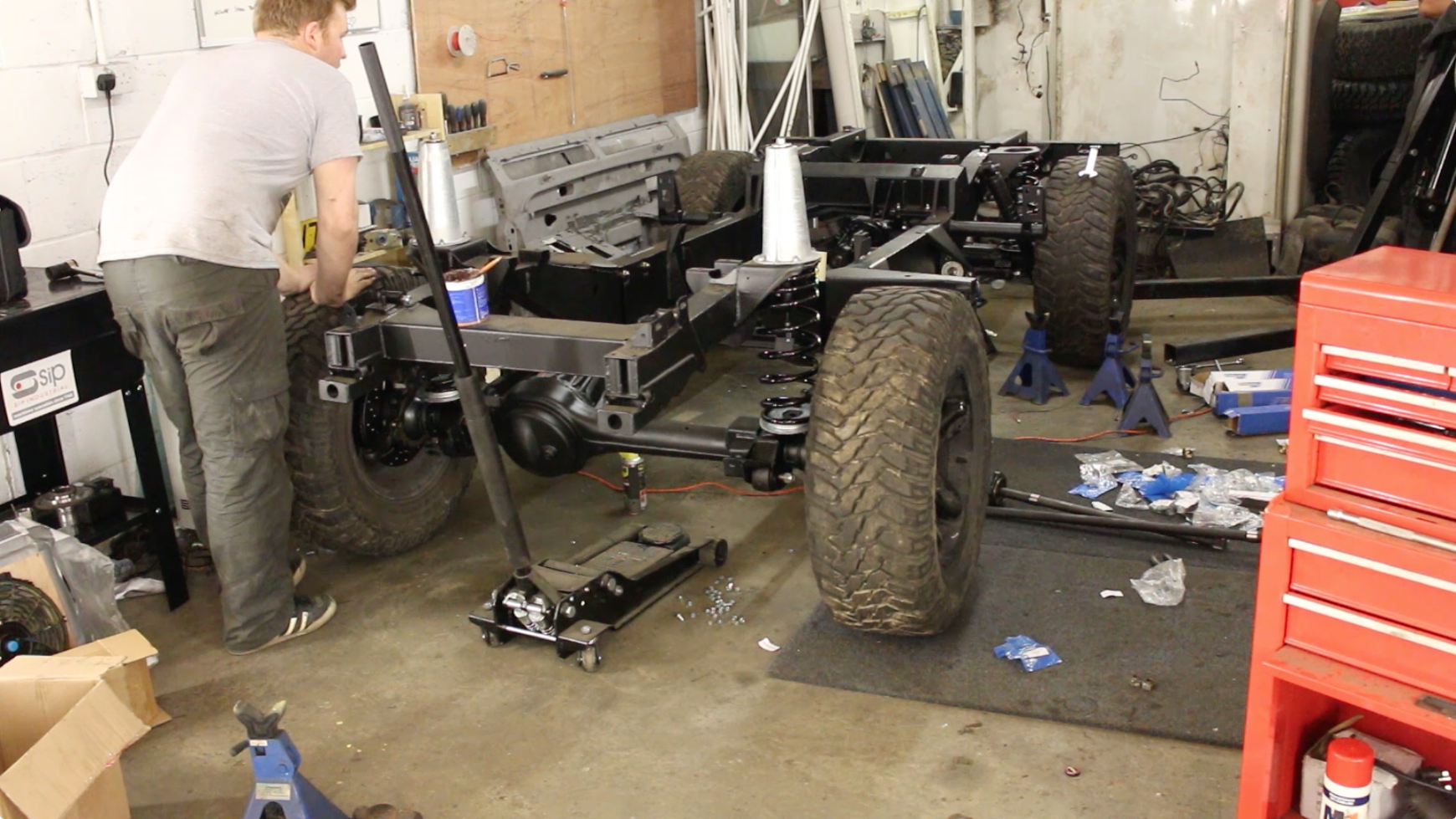
It is now a rolling chassis! Here's proof as I move it further into the centre of the shop for more room!
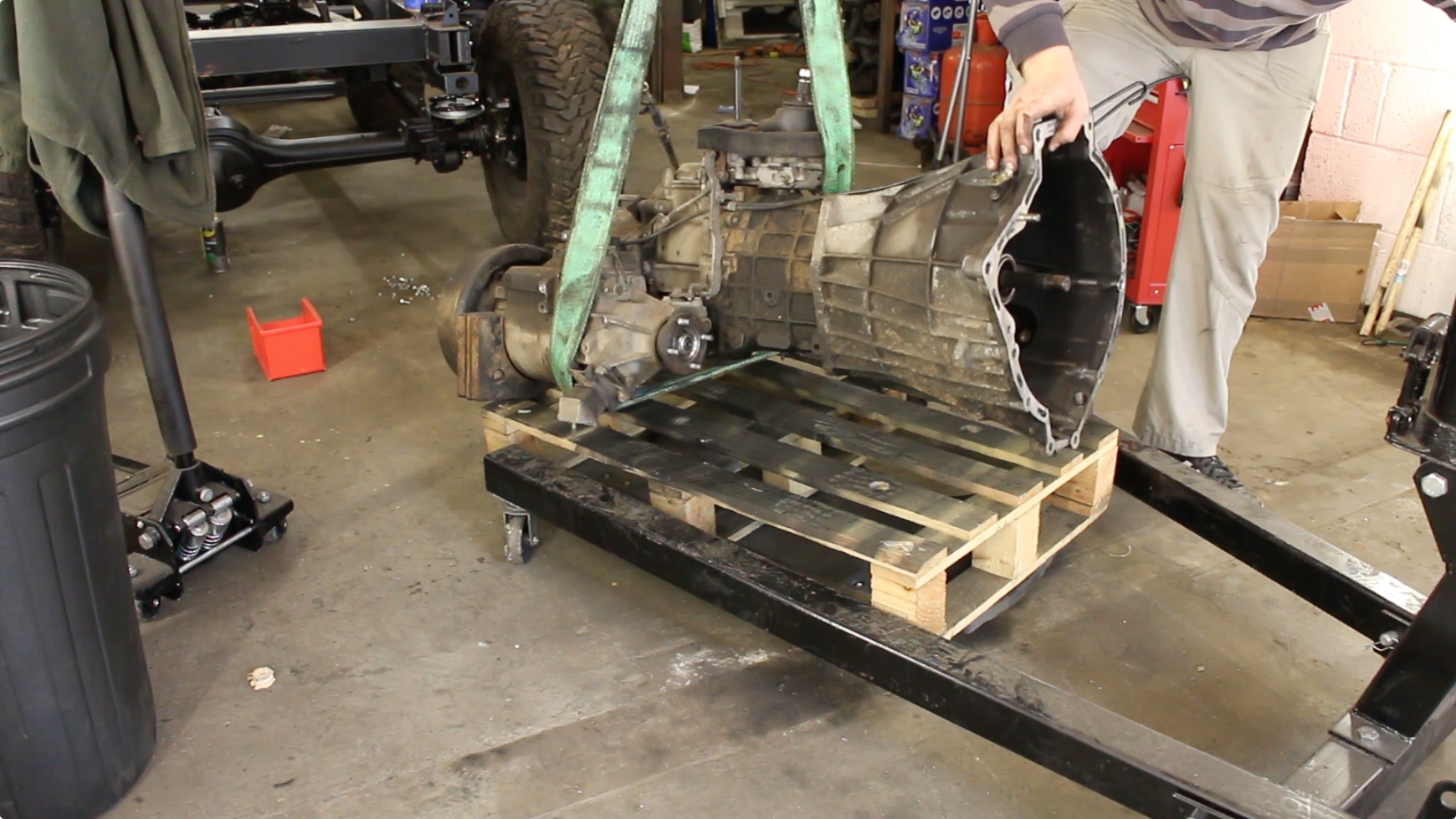
The R380 gearbox was chucked on a palette and taken to a gearbox specialist for a recon and inspection. This one had done around 75k and was getting a little tired, however it's always been well looked after so that's good.

We added the steering arm to make moving the rolling chassis around a bit easier.
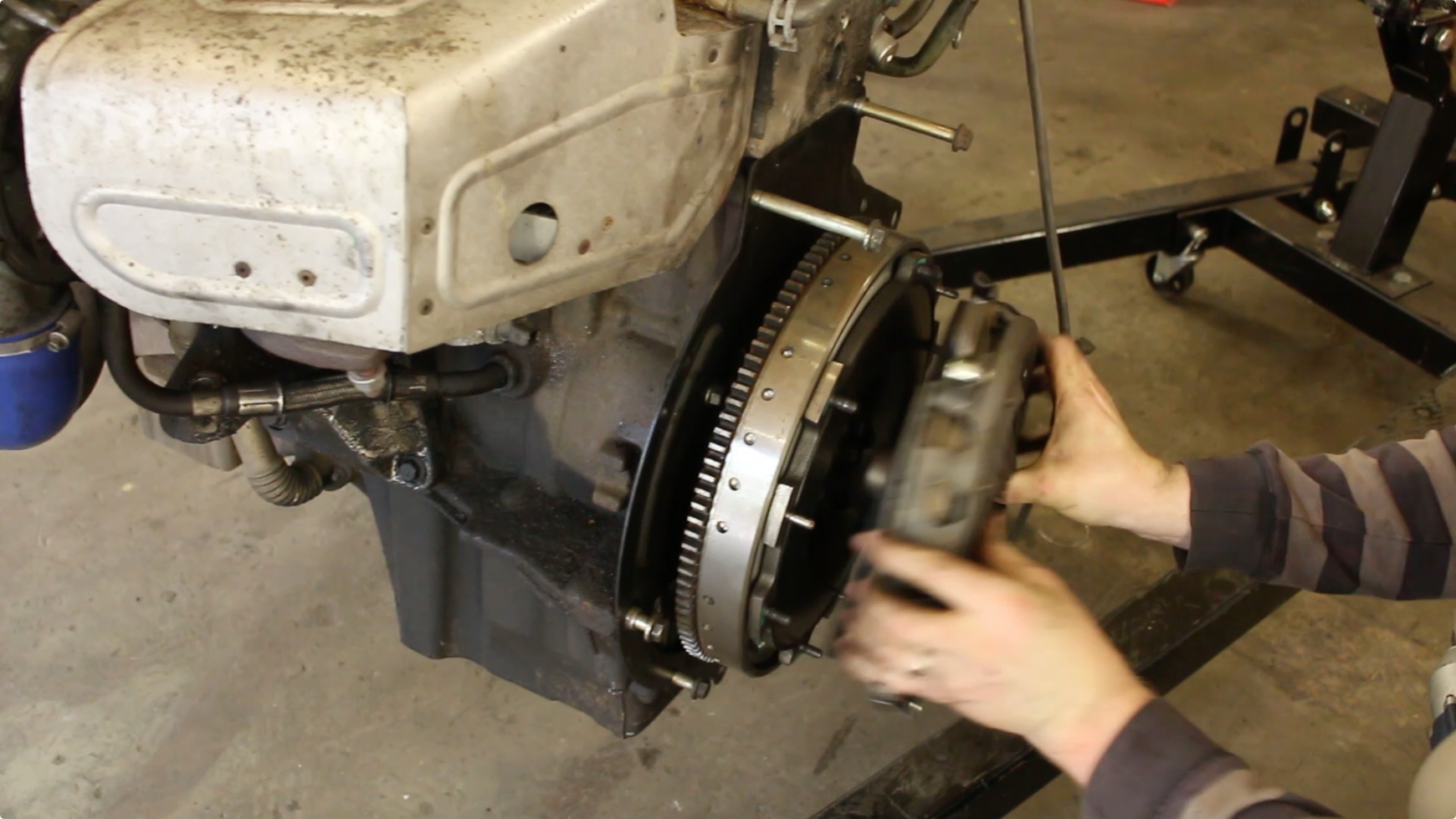
The clutch and Dual Mass Flywheel assembly was stripped from the engine, so we could fit it on an engine stand, this one is from http://www.sgs-engineering.com/garage-equipment/en.... It's a good value stand, but from my past experience with other SGS products, the are as good if not better than their competitors.
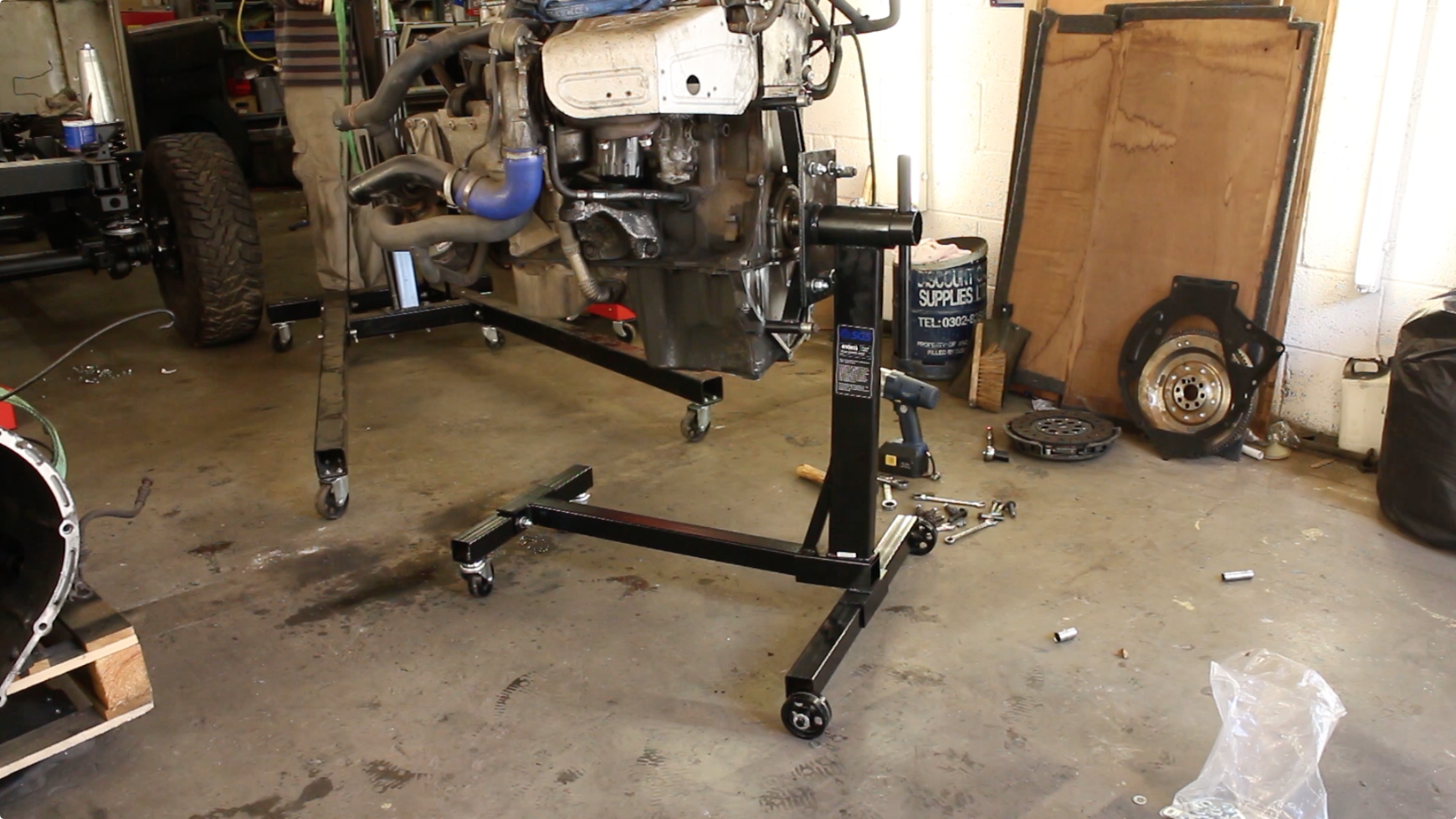
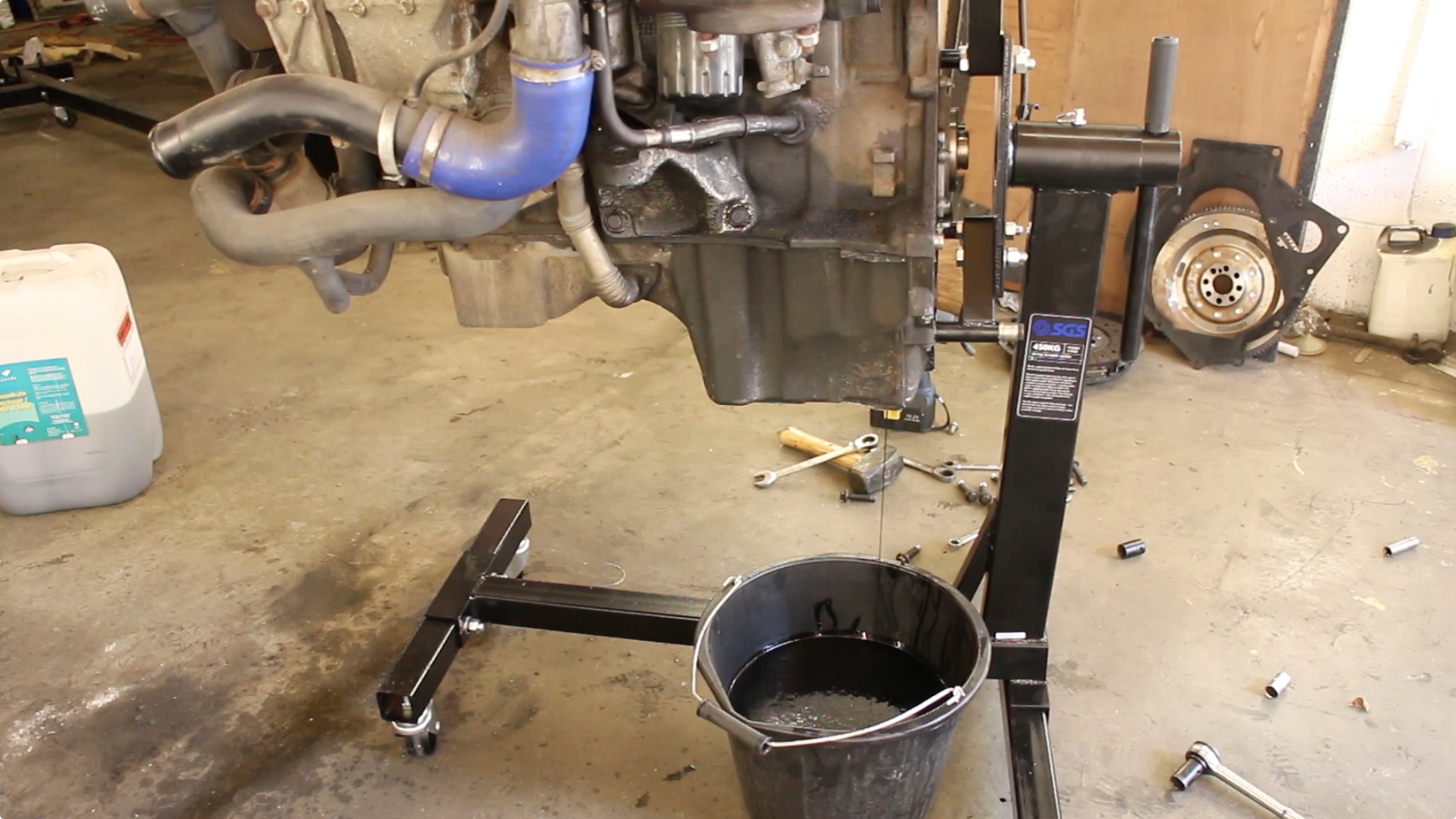
I drained the oil from the engine, before refitting the sump plug and setting about scrubbing it with gunk to get it clean.
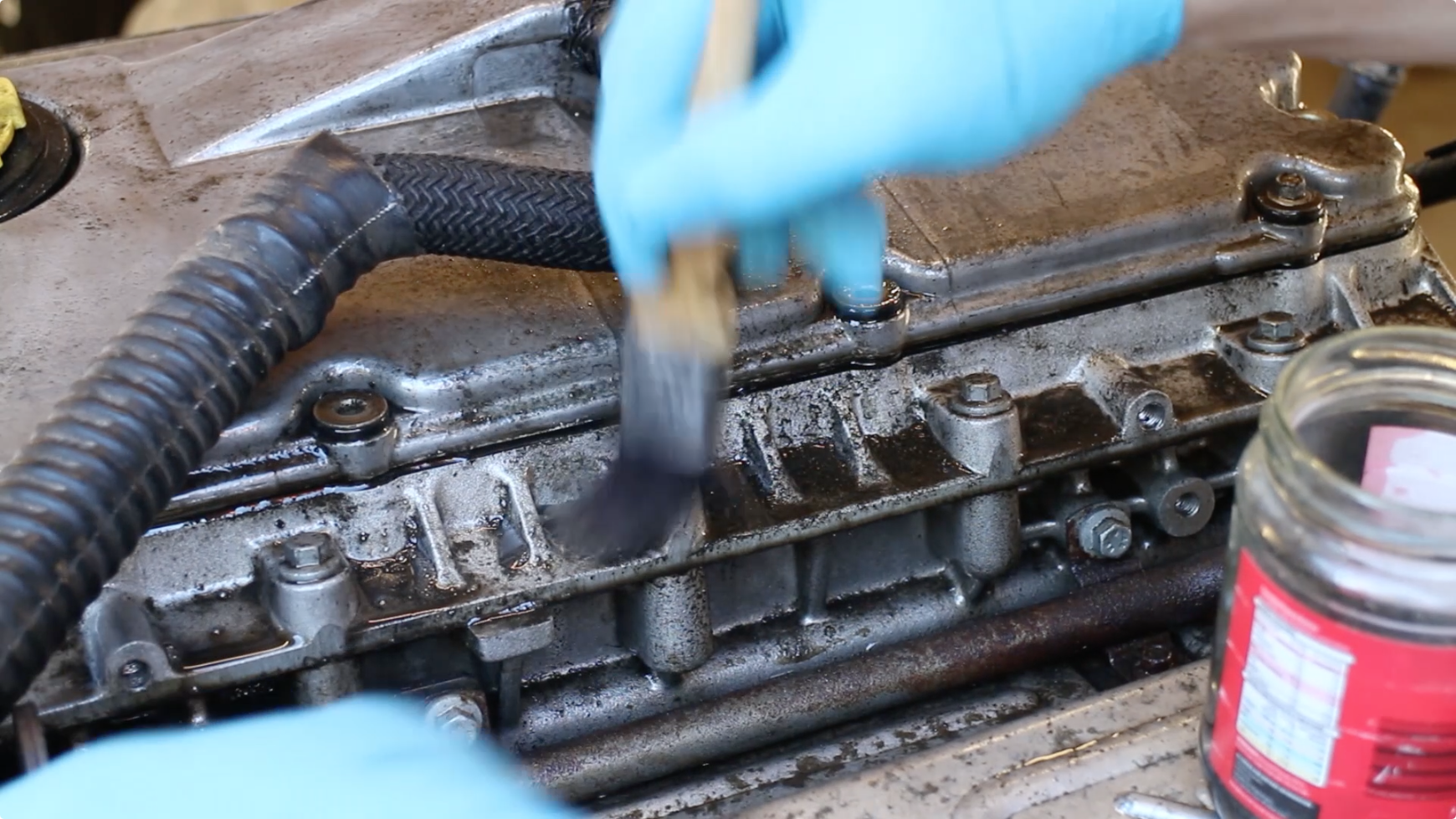
Working in the 'Gunk' degreasing solution to shift those really stubborn stains.

Then fitted some new axle breathers to the axles. We picked up these M12 to 6mm pneumatic elbows from http://www.gwynlewis4x4.co.uk/product/land-rover-d... - I'm impressed with their service, they ship products very quickly! In the kit, you also get a tap. Then it's a case of removing the old brass bushing to reveal the 12mm hole and tapping that. The tap should be dipped into some grease to stop swarf entering the diff oil.
These ones are for TD5 / Puma axles. If you have 300tdi and older, you'll have a 1/8 hole, in which case you can pick up a 1/8 BSPT (British Standard Pipe Thread) fitting to 6mm pipe on eBay for next to nothing. You'll need a 1/8" tap too. The only difference is the elbow is smaller.

What have we been up to this week with our Tribute build?

First up, we set about finishing the swivels from last time. The pre-load had to be set using shims on the upper pin - a time consuming process to say the least.

You'll need a spring balance, which can be found cheaply online or at a fishing supplies shop.

We're looking for a constant pull between 1.2kg and 1.4kg. If you're reading over the number, you need more shims, if you're below, you need to remove some. Be careful not to crank it down with such a high pre-load that you buckle the bearing race.

Then the oil seal and retainer plate need fitting. These lock down with small bolts and are torqued to 11nm.

The steering stop lock bolt was added at both sides too, this will need adjusting later.

Once the swivels we're correctly pre-loaded, we slid the cv and half shaft into place, feeling for the splines on the final drive unit to match with the half shaft end before gently pushing it home.

Using a piece of plywood to prevent damage, the brass bushing on the back of the stub axle can be tapped into place. To fit the roller bearing, we used an old cv joint as a bearing setter. Worked very well!

The stub axles can then be bolted on using the correct tensile strength stub axle bolts, with thread lock.

The new discs are from EBC and look awesome! Hopefully they'll provide superior braking capability thanks to the drilled and slotted brake surface.

The hub bearings were then fitted as well as the oil seal and adjusted correctly, before flatting the lock washer around the two hub nuts.

Then we positioned the axle under the rear of the chassis and connected it to the trailing arms, as well as dropping in the a frame ball joint.

The a frame castellated nut needs tightening and then the split pin pushing through

The springs and dampers could then be fitted, along with some nice galvanised seats and retainer plates.

The wheels were then temporarily bolted on. These are not the final wheels we'll be using - those haven't been painted yet. These are just to allow us to shunt the chassis around the workshop.

Then the springs and shocks were offered up - working with standard, non-gas filled shocks is a bit of a treat as they don't want to rapidly expand!

Then the front boots can be chucked on. These will be up for sale once the build is finished as they are surplus to requirements.

It is now a rolling chassis! Here's proof as I move it further into the centre of the shop for more room!

The R380 gearbox was chucked on a palette and taken to a gearbox specialist for a recon and inspection. This one had done around 75k and was getting a little tired, however it's always been well looked after so that's good.

We added the steering arm to make moving the rolling chassis around a bit easier.

The clutch and Dual Mass Flywheel assembly was stripped from the engine, so we could fit it on an engine stand, this one is from http://www.sgs-engineering.com/garage-equipment/en.... It's a good value stand, but from my past experience with other SGS products, the are as good if not better than their competitors.


I drained the oil from the engine, before refitting the sump plug and setting about scrubbing it with gunk to get it clean.

Working in the 'Gunk' degreasing solution to shift those really stubborn stains.

Then fitted some new axle breathers to the axles. We picked up these M12 to 6mm pneumatic elbows from http://www.gwynlewis4x4.co.uk/product/land-rover-d... - I'm impressed with their service, they ship products very quickly! In the kit, you also get a tap. Then it's a case of removing the old brass bushing to reveal the 12mm hole and tapping that. The tap should be dipped into some grease to stop swarf entering the diff oil.
These ones are for TD5 / Puma axles. If you have 300tdi and older, you'll have a 1/8 hole, in which case you can pick up a 1/8 BSPT (British Standard Pipe Thread) fitting to 6mm pipe on eBay for next to nothing. You'll need a 1/8" tap too. The only difference is the elbow is smaller.

https:/www.youtube.com/watch?v=j48MjyzTwd4
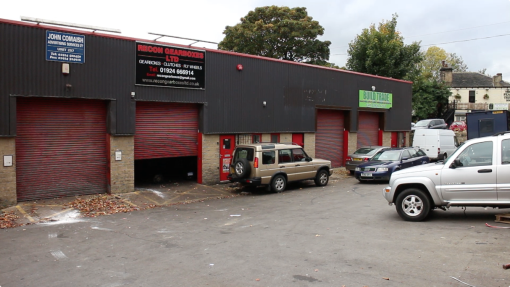
This week, we headed over to a local gearbox specialist to get our R380 stripped down and inspected.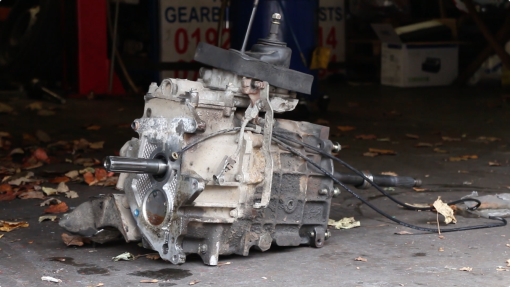
Here it is after we dropped it off, looking a little sad. The plan is to have it inspected, have all bearings & seals replaced then the outer cases will be fully cleaned and painted before reassembly.
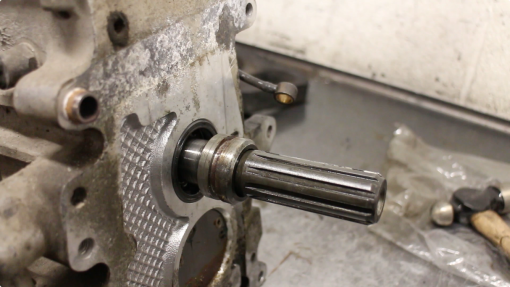
If you look in the R380 manual, it lists the tools need to remove this oil selector collar: LRT-37-009 and LRT-37-010
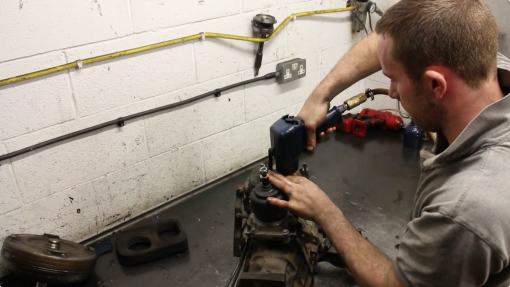
Glenn then removed the foam insulation that sits in the tunnel over the gear selector housing and gear knobs. He then went on to remove the extension housing upper bolts, the ones that go through the remote and gear change housing.
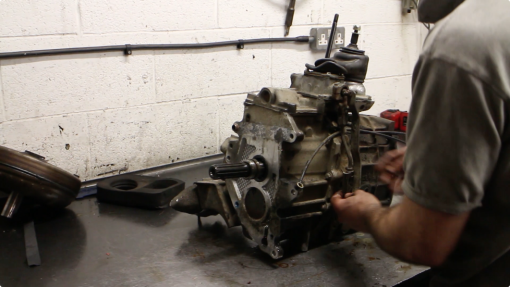
The high low and centre diff lock linkages were also removed as were the breather pipes that were still bundled with the gearbox.

Next Glenn removed the 4 bolts left on the remaining gearbox mounting bracket.
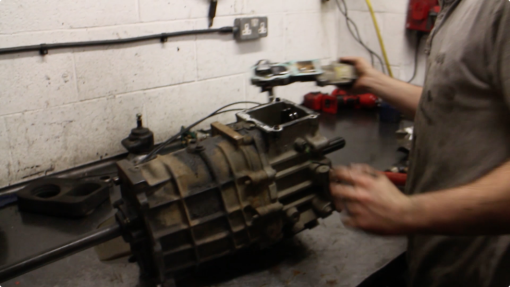
The remote housing was then free to remove.
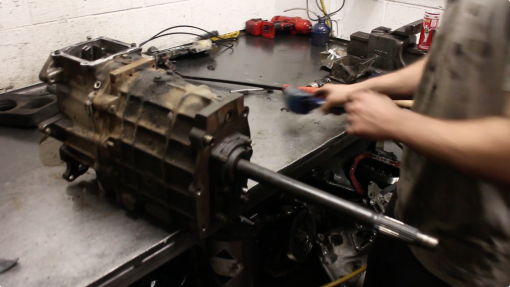
The front cover is held on with 6 bolts. This can be tapped loose using a soft faced hammer.
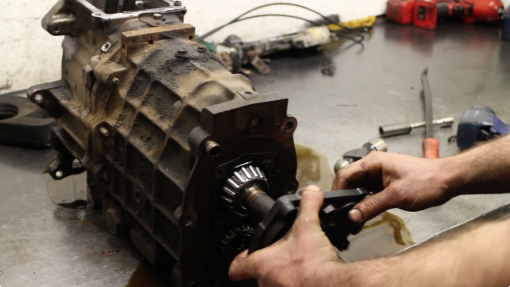
The input shaft front taper bearing is in good condition
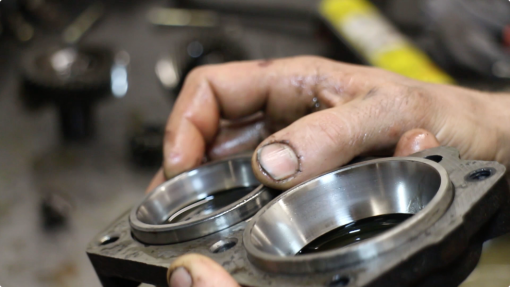
The bearing races themselves though have a little scoring, only light - but then this gearbox has covered 75 thousand miles.
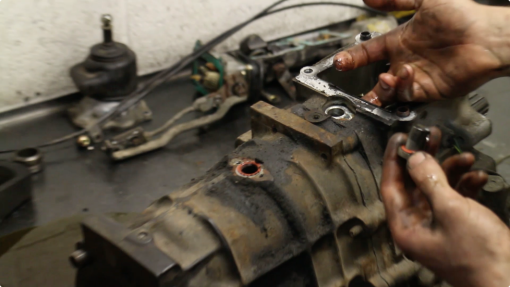
The spool retainers also need removing, there's one in the gearcase and one in the extension housing.
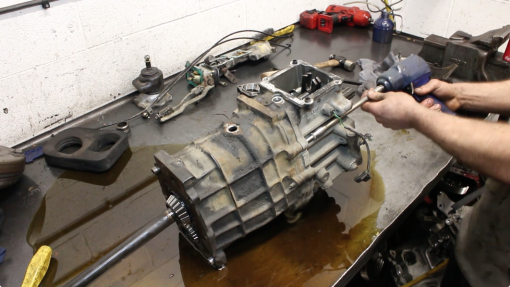
Next out comes the inhibitor camshaft, then Glenn removed the bolts holding the extension housing to the centre plate and gearcase.
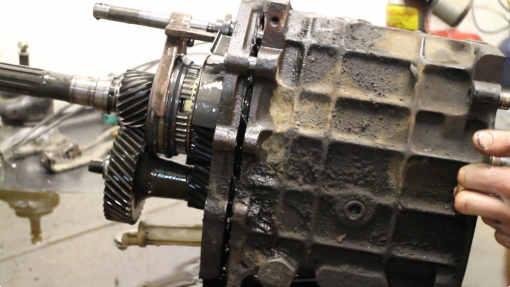
The outer Detent ball and spring need removing, these have a torx screw holding them in on this box. After a liberal spray of penetrating fluid and heating with a propane torch, this came out much easier. The detent ball and spring can be retrieved with a magnet. The gearcase and extension housing are then separated, before removing the selector quadrant and completely splitting the outer cases.
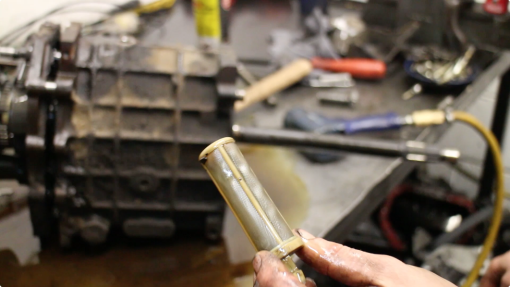
The oil filter was retrieved and appeared to be in good condition
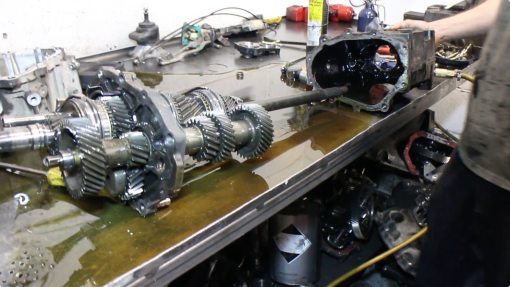
And that's the internals removed.
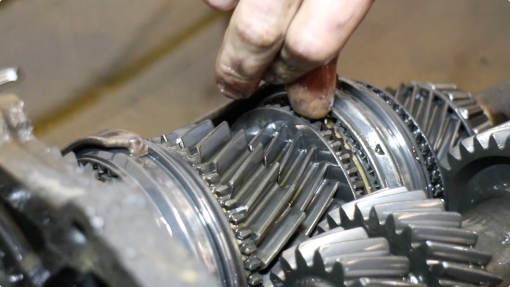
The bank / synchro rings are also in decent condition, they haven't worn sharp.
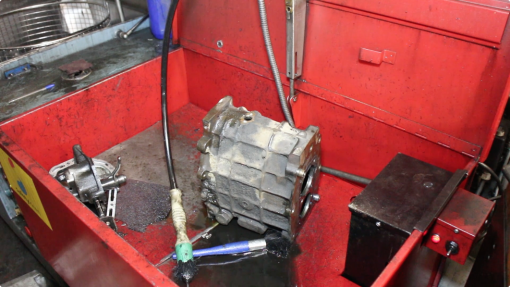
The housings are then put into the parts washer and a hot wash tank for a thorough degrease before painting.

On the gearbox internals, glenn first removes the 5th gear nut - then the layshaft 5th gear
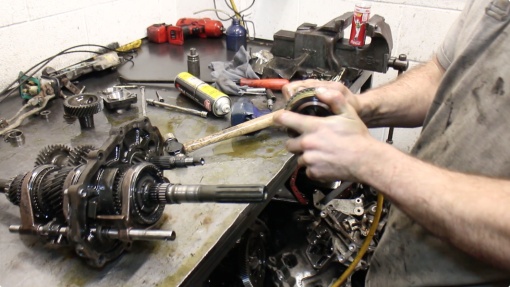
Before moving onto the mainshaft and removing the mainshaft 5th. The syncro here was in excellent condition. After removing the 5th gear, you need to remove the circlip that holds the Reverse/5th gear synchro hub and sleeve in place, then the hub itself.
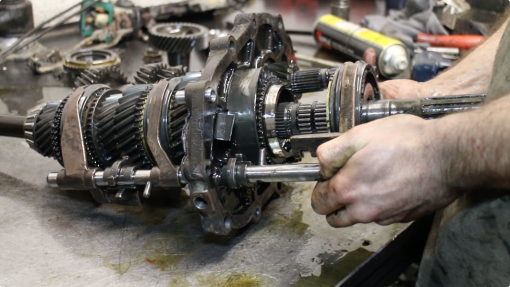

Reverse gear comes off next.
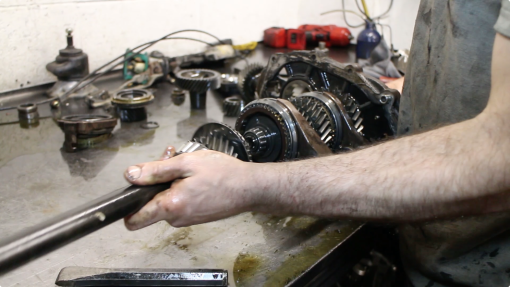
The input shaft slides off now along with the 4th gear syncro ring.
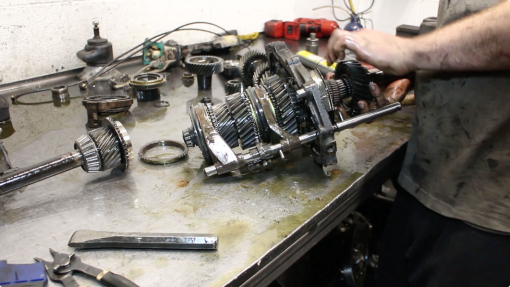
Then reverse comes off.
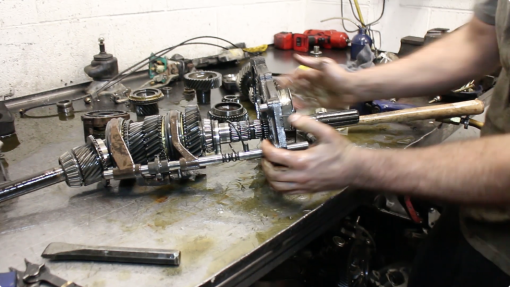
When taking the center plate off, watch out for the lower detent spring and ball. The Selector fork and shaft can be removed next and that’s the gearbox done. It’ll then be cleaned, any worn parts replaced and painted - we should be able to pick that up in the next episode!
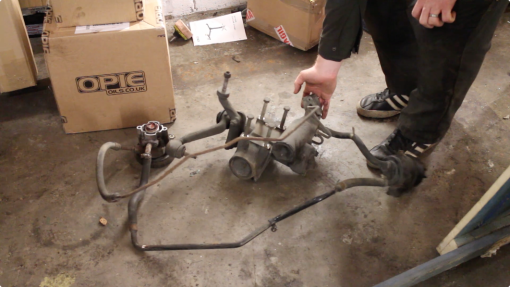
Back at FunRover HQ - we’re working on the steering box. We purchased a recon steering box as the old one would make quite a grumble as it was turned from lock to lock. This was supplied by LrParts.net. Once this is fitted, we can send the old one back, it’s a neat way of saving cash and recycling Land Rover parts. Empty as much steering fluid out the system as you can. Will need to be centred and bled and the torque will be rechecked after our shake down drive.
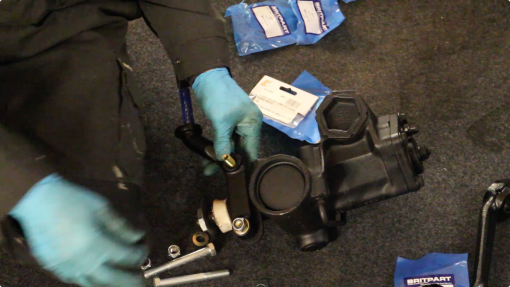
Adding the tie bar

This can be lifted into place and bolted up, it's much easier if there are 2 of you.
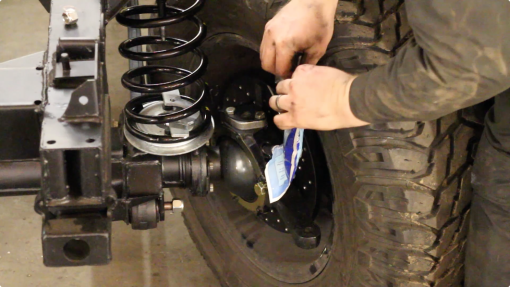
One shot grease was added to the swivel housings. It was necessary to remove the steering stop locks to turn the housing past the end of the swivel ball. This allows you to insert the grease bag filling tube right into the housing and get the grease in the right place, rather than it spewing back out all over.
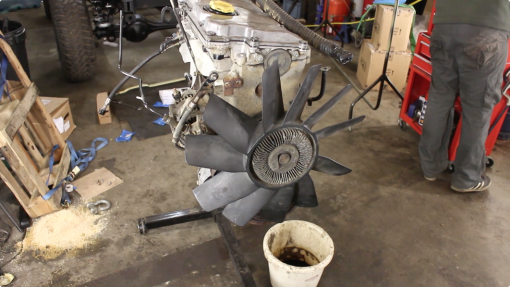
Next, we moved onto the TD5 lump. This needs cleaning up, as we're going to paint and polish it. Unnecessary? Perhaps, but it would look out of place in the build if we had a dirty old engine.
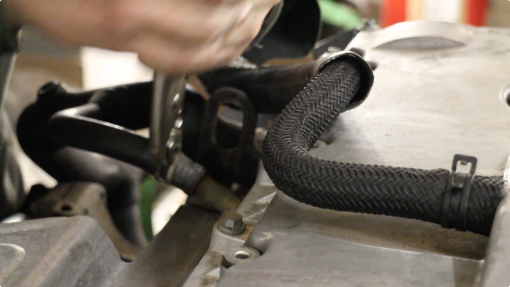
First off, I started by removing all hoses.
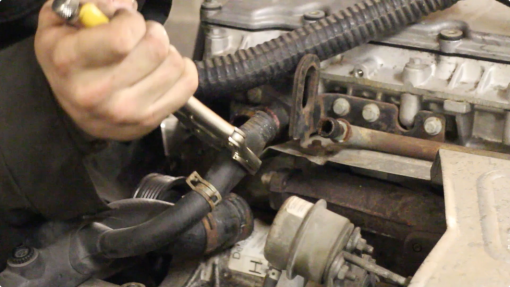
Some of the pipes had quite an amount of corrosion in them.
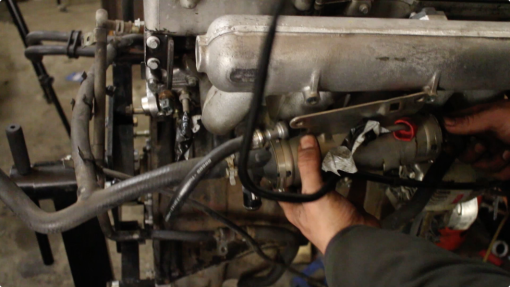
Next, the fuel cooler was removed. It's helpful to put bolts back in their respective holes so you can remember where they came from later.
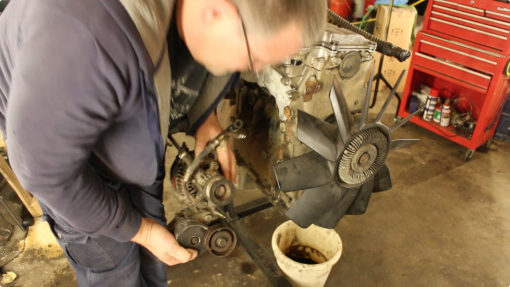
The Alternator and associated belt pulleys were next.

The turbo came off afterwards, revealing the all too common snapped exhaust manifold stud problem. Not one stud had snapped but two!

The answer is to get the manifold machined flat (as it has warped due to the exhaust gas temperatures) then have some of the casting removed to help it flex little. We'll also fit longer, more heavy duty studs with spacers and this should stop it ever happening again.

This week, we headed over to a local gearbox specialist to get our R380 stripped down and inspected.

Here it is after we dropped it off, looking a little sad. The plan is to have it inspected, have all bearings & seals replaced then the outer cases will be fully cleaned and painted before reassembly.

If you look in the R380 manual, it lists the tools need to remove this oil selector collar: LRT-37-009 and LRT-37-010

Glenn then removed the foam insulation that sits in the tunnel over the gear selector housing and gear knobs. He then went on to remove the extension housing upper bolts, the ones that go through the remote and gear change housing.

The high low and centre diff lock linkages were also removed as were the breather pipes that were still bundled with the gearbox.

Next Glenn removed the 4 bolts left on the remaining gearbox mounting bracket.

The remote housing was then free to remove.

The front cover is held on with 6 bolts. This can be tapped loose using a soft faced hammer.

The input shaft front taper bearing is in good condition

The bearing races themselves though have a little scoring, only light - but then this gearbox has covered 75 thousand miles.

The spool retainers also need removing, there's one in the gearcase and one in the extension housing.

Next out comes the inhibitor camshaft, then Glenn removed the bolts holding the extension housing to the centre plate and gearcase.

The outer Detent ball and spring need removing, these have a torx screw holding them in on this box. After a liberal spray of penetrating fluid and heating with a propane torch, this came out much easier. The detent ball and spring can be retrieved with a magnet. The gearcase and extension housing are then separated, before removing the selector quadrant and completely splitting the outer cases.

The oil filter was retrieved and appeared to be in good condition

And that's the internals removed.

The bank / synchro rings are also in decent condition, they haven't worn sharp.

The housings are then put into the parts washer and a hot wash tank for a thorough degrease before painting.

On the gearbox internals, glenn first removes the 5th gear nut - then the layshaft 5th gear

Before moving onto the mainshaft and removing the mainshaft 5th. The syncro here was in excellent condition. After removing the 5th gear, you need to remove the circlip that holds the Reverse/5th gear synchro hub and sleeve in place, then the hub itself.


Reverse gear comes off next.

The input shaft slides off now along with the 4th gear syncro ring.

Then reverse comes off.

When taking the center plate off, watch out for the lower detent spring and ball. The Selector fork and shaft can be removed next and that’s the gearbox done. It’ll then be cleaned, any worn parts replaced and painted - we should be able to pick that up in the next episode!

Back at FunRover HQ - we’re working on the steering box. We purchased a recon steering box as the old one would make quite a grumble as it was turned from lock to lock. This was supplied by LrParts.net. Once this is fitted, we can send the old one back, it’s a neat way of saving cash and recycling Land Rover parts. Empty as much steering fluid out the system as you can. Will need to be centred and bled and the torque will be rechecked after our shake down drive.

Adding the tie bar

This can be lifted into place and bolted up, it's much easier if there are 2 of you.

One shot grease was added to the swivel housings. It was necessary to remove the steering stop locks to turn the housing past the end of the swivel ball. This allows you to insert the grease bag filling tube right into the housing and get the grease in the right place, rather than it spewing back out all over.

Next, we moved onto the TD5 lump. This needs cleaning up, as we're going to paint and polish it. Unnecessary? Perhaps, but it would look out of place in the build if we had a dirty old engine.

First off, I started by removing all hoses.

Some of the pipes had quite an amount of corrosion in them.

Next, the fuel cooler was removed. It's helpful to put bolts back in their respective holes so you can remember where they came from later.

The Alternator and associated belt pulleys were next.

The turbo came off afterwards, revealing the all too common snapped exhaust manifold stud problem. Not one stud had snapped but two!

The answer is to get the manifold machined flat (as it has warped due to the exhaust gas temperatures) then have some of the casting removed to help it flex little. We'll also fit longer, more heavy duty studs with spacers and this should stop it ever happening again.
https://www.youtube.com/watch?v=I3cKPF3G-08
This week, we've been mainly working on our engine, as well as inspecting the rear tub.
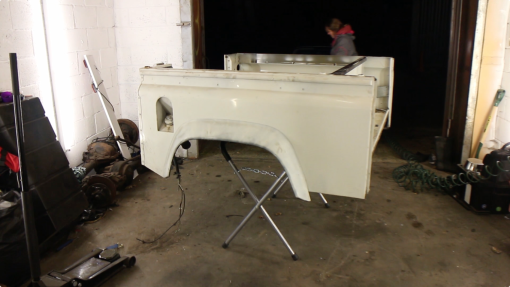
It's a good idea to get the tub sat on an body painting trestle. These can be found on eBay pretty reasonably. They give you really good access to the underside and as an added bonus, fold away when not needed.

The inside of the tub has accumulated a lot of grime from the workshop and so it needed a good clean out. We used a strong road and traffic film remover to strip away any oils that might have been on the surfaces of the tub.
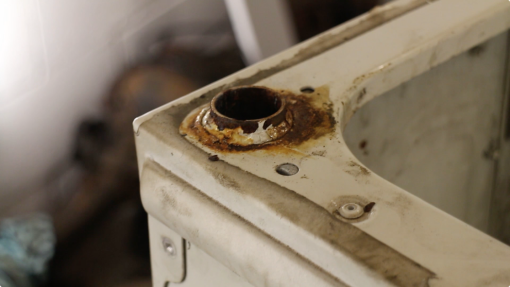
After cleaning, the body mappings have revealed some rust, not to worry, these are going to be blasted and then galved.
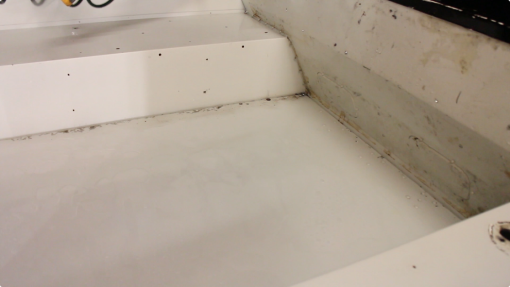
There are a lot of holes left in the tub. We'll try alloy brazing to fill them in.
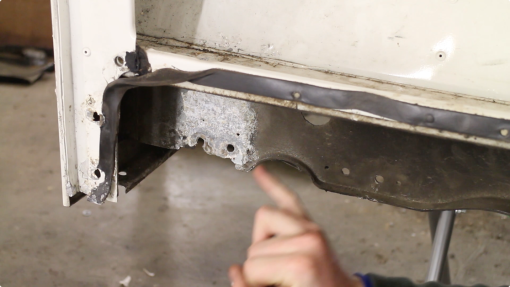
This seat belt mounting bracket is corroded, fortunately YRM metal solutions produces laser cut reproduction panels that we can simply rivet on. The part isn't too expensive either!
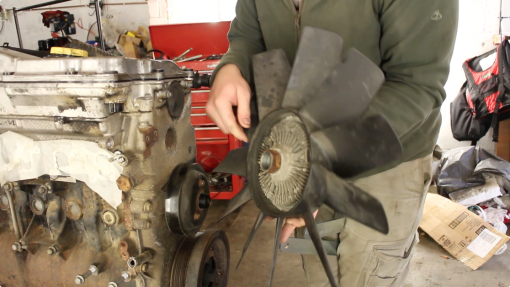
Use a TD5 / V8 Viscous fan set from FlatDog UK we removed the viscous fan in preparation for cleaning and painting the engine.
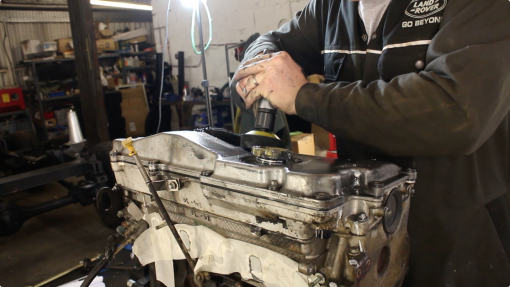
Using a 75mm air polisher and white diamond metal polish and sealer. Why are we polishing the rocker cover? Well, we're not refitting the acoustic cover on the engine, so we want it to look as good as the rest of the vehicle.

Here's a before and part way through, the White Diamond polish is great, it takes very little effort to get to the finish on the right. A few more passes and we'll have a chrome like finish that is protected from further oxidisation thanks to the sealer in the polishing compound.
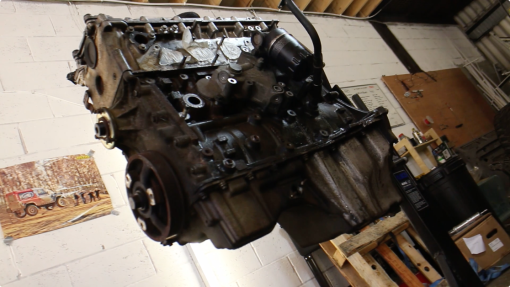
Then we moved onto cleaning the engine, which had a lot of baked on oils, carbon deposits, mud and corrosion.
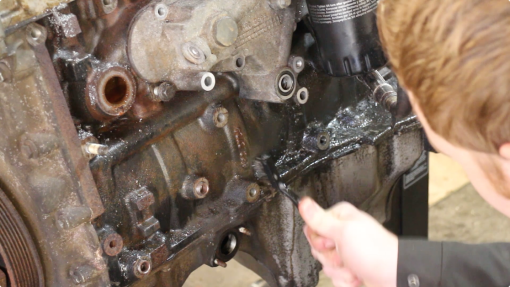
First, it was given a thorough scrub down with some small stainless steel wire brushes and a degreasing detergent.
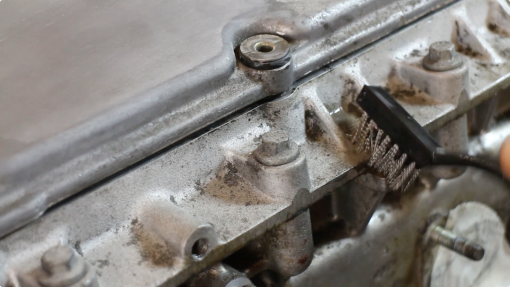
Once dry, we could then tackle the corrosion. Here we're working the corroded areas with the brush more, before switching to a dremel with a wire cup.
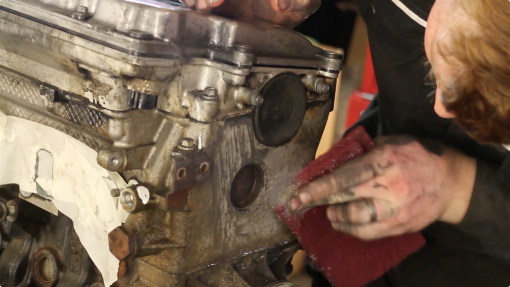
Areas such as the end of the block were pretty corroded so it was knocked back with a red scotchbrite pad, polished and then sealed.
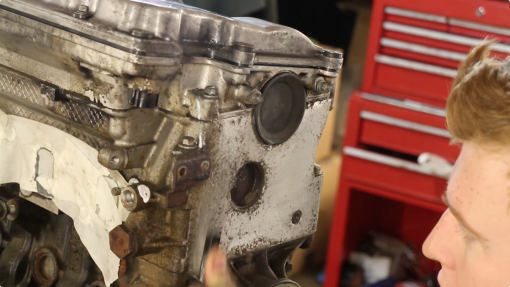
Still a little more corrosion that was removed with a flapper wheel on the dremel.]
This week, we've been mainly working on our engine, as well as inspecting the rear tub.

It's a good idea to get the tub sat on an body painting trestle. These can be found on eBay pretty reasonably. They give you really good access to the underside and as an added bonus, fold away when not needed.

The inside of the tub has accumulated a lot of grime from the workshop and so it needed a good clean out. We used a strong road and traffic film remover to strip away any oils that might have been on the surfaces of the tub.

After cleaning, the body mappings have revealed some rust, not to worry, these are going to be blasted and then galved.

There are a lot of holes left in the tub. We'll try alloy brazing to fill them in.

This seat belt mounting bracket is corroded, fortunately YRM metal solutions produces laser cut reproduction panels that we can simply rivet on. The part isn't too expensive either!

Use a TD5 / V8 Viscous fan set from FlatDog UK we removed the viscous fan in preparation for cleaning and painting the engine.

Using a 75mm air polisher and white diamond metal polish and sealer. Why are we polishing the rocker cover? Well, we're not refitting the acoustic cover on the engine, so we want it to look as good as the rest of the vehicle.

Here's a before and part way through, the White Diamond polish is great, it takes very little effort to get to the finish on the right. A few more passes and we'll have a chrome like finish that is protected from further oxidisation thanks to the sealer in the polishing compound.

Then we moved onto cleaning the engine, which had a lot of baked on oils, carbon deposits, mud and corrosion.

First, it was given a thorough scrub down with some small stainless steel wire brushes and a degreasing detergent.

Once dry, we could then tackle the corrosion. Here we're working the corroded areas with the brush more, before switching to a dremel with a wire cup.

Areas such as the end of the block were pretty corroded so it was knocked back with a red scotchbrite pad, polished and then sealed.

Still a little more corrosion that was removed with a flapper wheel on the dremel.]
https://youtu.be/3ofuyHLnue0
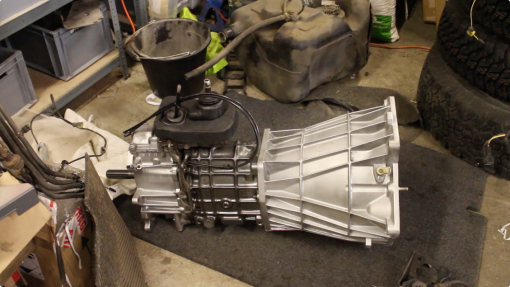
Recon Gearboxes LTD completed our R380 and it's looking superb! We're having the brackets blasted and galved so hope to put that back in soon!
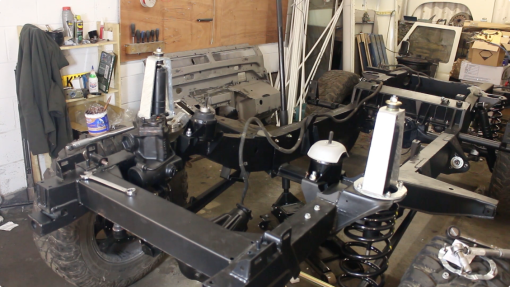
Following a suggestion from one of the forum posts we've been running for the build, we swapped our Britpart galvanised turrets for some heavy duty
http://www.gwynlewis4x4.co.uk/product/std-height-h...
. These replacement turrets are stronger, galvanised, easier to clean / maintain and once fitted, will make shock replacement much faster! These have been designed for challenge trucks and are extremely well made. We're also fitting matching
http://www.gwynlewis4x4.co.uk/product/heavy-duty-f...
. These have 10.9 tensile bolts welded into the ring and feature a chamfered edge to stop tyres rubbing at full articulation.
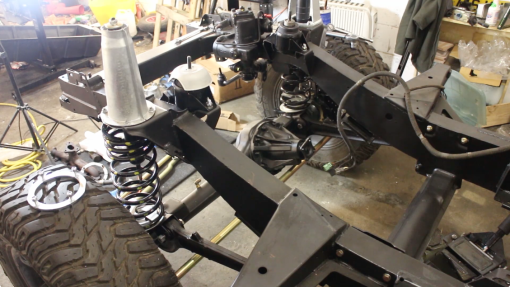
Fitting these turrets is a doddle. The easiest way is to undo the lower nut on the shock, then jack the chassis up to release the spring from it's seat about an inch or two.
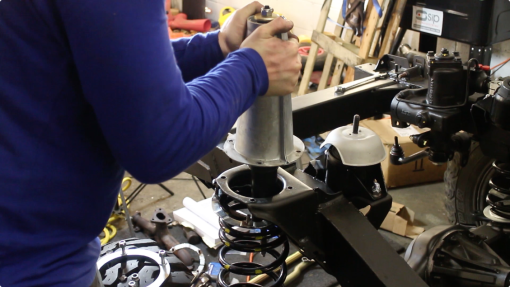
Then, if you unbolt the access panel in the wheel arch, and carefully undo the four nuts on the ring, the whole assembly will lift out in one piece. You may have to use a propane torch on the nuts as these can shear quite easily on corroded parts.
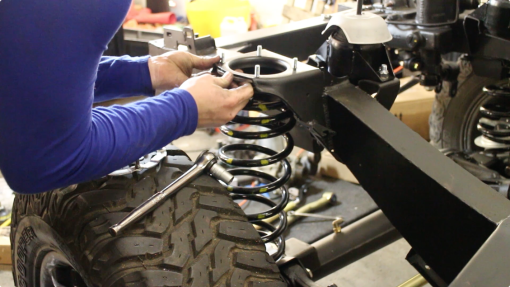
Then the ring can be slipped into place, the turret offered up and bolted down to 24nm or 17.7lb ft.
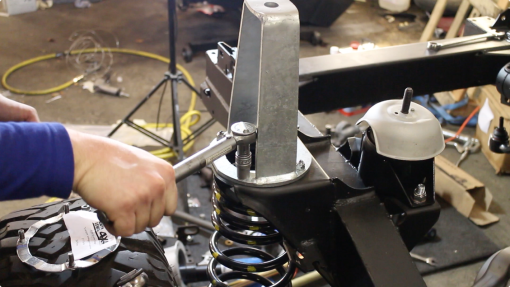
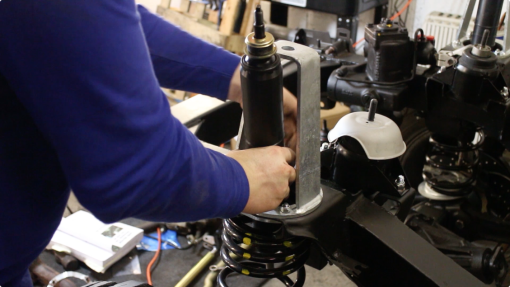
One key benefit of the Gwynn Lewis shock is that you can fit a shock absorber without removing the turret or spring.
Engine Painting
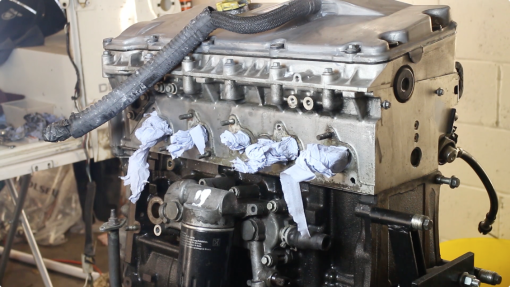
The TD5 rocker cover has been polished up and cleaned, so now it's the blocks turn for some attention. First off, all holes are plugged and bolts are temporarily placed back into their holes.
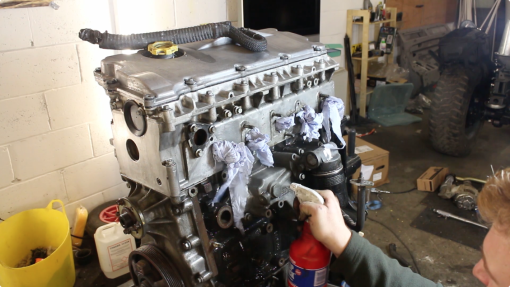
Look how clean that head is! Took a lot of work, but the results are worth it! Now using a bottle of brake cleaner, the block was throughly scrubbed down and agitated with brushes.
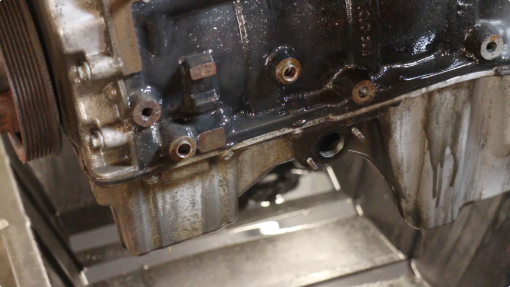
This is why it's so important! Even after 3 wash downs already, there's still dirt and oil left behind!
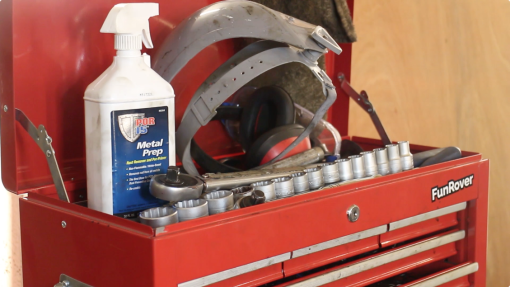
I'm using POR 15 Engine Enamel from
http://Frost.co.uk]
to paint the block, it is recommended that bare aluminium surfaces should be treated with metal prep first before painting.
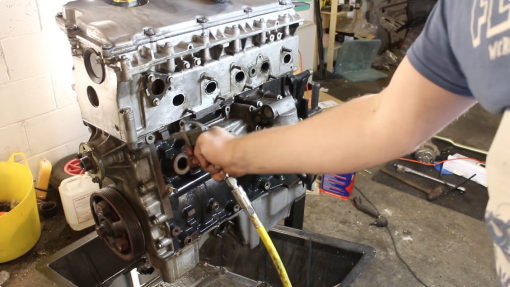
Then blown down with the air gun to get rid of any final bits of debris and moisture that might effect our paint.
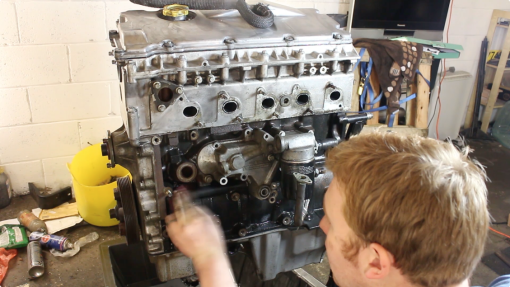
Almost ready to paint, I keyed off the surface with a 3M scrotchbrite pad, just for a little extra adhesion!

Finally! Painting time! I'm using a good quality brush and POR 15 Engine enamel from Frost. It's designed specifically to be used on engine blocks so will withstand higher temperatures and comes in a selection of colours. I've chosen Buick Green, which is as near as makes no difference to the final build colour, Pastel Green. This colour has become ever so popular recently, however, I bought mine about a year ago. Oh well, this is one Defender that isn't just following the crowd!

Looks good! Need to leave this 6 days to fully cure before starting the engine, but we can be on with putting it back in over the next week!
Engine Mounts

Engine mounts have been refitted, we've replaced the tired originals for some OEM replacements. These need to be torqued to 85NM. We also took the time to shot blast the original heat shield and paint that in a high temperature spray paint.
Fuel Tank and Guard
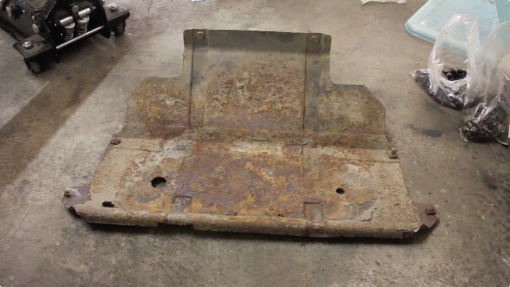
The old fuel tank guard looks a bit sorry for itself. On the TD5 90 this is all that holds the fuel tank in place - it also offers a little protection against terrain when off-roading. We could have replaced it with an original style guard, but these were actually more expensive than an aftermarket, heavy duty galvanised guard (bought from
http://paddockspares.com]
). So we cleaned up the tank, and fitted up the replacement item
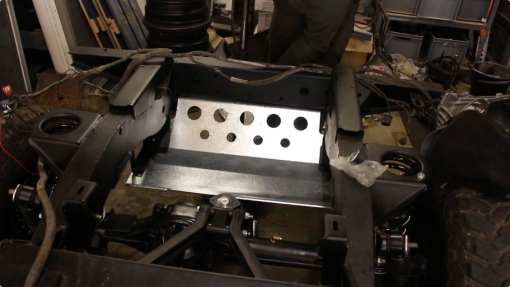
I used a trolley jack to line it up and hold the guard in place, it's quite cumbersome to do this on your back by yourself. Once bolted up, it looks great and is very tough! I can stand on the guard and it will take all 16 stone (100kg) of me no worries.

A great value replacement / upgrade!

Recon Gearboxes LTD completed our R380 and it's looking superb! We're having the brackets blasted and galved so hope to put that back in soon!

Following a suggestion from one of the forum posts we've been running for the build, we swapped our Britpart galvanised turrets for some heavy duty
http://www.gwynlewis4x4.co.uk/product/std-height-h...
. These replacement turrets are stronger, galvanised, easier to clean / maintain and once fitted, will make shock replacement much faster! These have been designed for challenge trucks and are extremely well made. We're also fitting matching
http://www.gwynlewis4x4.co.uk/product/heavy-duty-f...
. These have 10.9 tensile bolts welded into the ring and feature a chamfered edge to stop tyres rubbing at full articulation.

Fitting these turrets is a doddle. The easiest way is to undo the lower nut on the shock, then jack the chassis up to release the spring from it's seat about an inch or two.

Then, if you unbolt the access panel in the wheel arch, and carefully undo the four nuts on the ring, the whole assembly will lift out in one piece. You may have to use a propane torch on the nuts as these can shear quite easily on corroded parts.

Then the ring can be slipped into place, the turret offered up and bolted down to 24nm or 17.7lb ft.


One key benefit of the Gwynn Lewis shock is that you can fit a shock absorber without removing the turret or spring.
Engine Painting

The TD5 rocker cover has been polished up and cleaned, so now it's the blocks turn for some attention. First off, all holes are plugged and bolts are temporarily placed back into their holes.

Look how clean that head is! Took a lot of work, but the results are worth it! Now using a bottle of brake cleaner, the block was throughly scrubbed down and agitated with brushes.

This is why it's so important! Even after 3 wash downs already, there's still dirt and oil left behind!

I'm using POR 15 Engine Enamel from
http://Frost.co.uk]
to paint the block, it is recommended that bare aluminium surfaces should be treated with metal prep first before painting.

Then blown down with the air gun to get rid of any final bits of debris and moisture that might effect our paint.

Almost ready to paint, I keyed off the surface with a 3M scrotchbrite pad, just for a little extra adhesion!

Finally! Painting time! I'm using a good quality brush and POR 15 Engine enamel from Frost. It's designed specifically to be used on engine blocks so will withstand higher temperatures and comes in a selection of colours. I've chosen Buick Green, which is as near as makes no difference to the final build colour, Pastel Green. This colour has become ever so popular recently, however, I bought mine about a year ago. Oh well, this is one Defender that isn't just following the crowd!

Looks good! Need to leave this 6 days to fully cure before starting the engine, but we can be on with putting it back in over the next week!
Engine Mounts

Engine mounts have been refitted, we've replaced the tired originals for some OEM replacements. These need to be torqued to 85NM. We also took the time to shot blast the original heat shield and paint that in a high temperature spray paint.
Fuel Tank and Guard

The old fuel tank guard looks a bit sorry for itself. On the TD5 90 this is all that holds the fuel tank in place - it also offers a little protection against terrain when off-roading. We could have replaced it with an original style guard, but these were actually more expensive than an aftermarket, heavy duty galvanised guard (bought from
http://paddockspares.com]
). So we cleaned up the tank, and fitted up the replacement item

I used a trolley jack to line it up and hold the guard in place, it's quite cumbersome to do this on your back by yourself. Once bolted up, it looks great and is very tough! I can stand on the guard and it will take all 16 stone (100kg) of me no worries.

A great value replacement / upgrade!
https://youtu.be/9VCDqXqbCqg
[url=http://funrover.com/wp-content/uploads/2015/11/Screen-Shot-2015-11-27-at-12.44.57.png]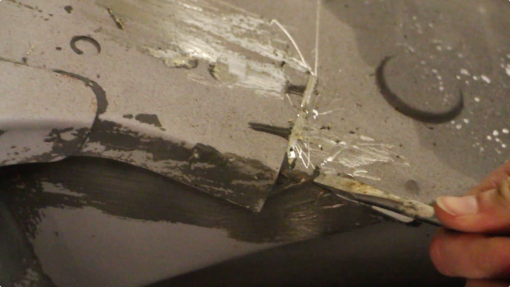
[/url]
This week, I've had my better half working on the bulkhead, removing the remains of the seam sealer so the bulkhead can be sent off to the shot blasters, then to the galvanisers and back to me for painting.
[url=http://funrover.com/wp-content/uploads/2015/11/Screen-Shot-2015-11-27-at-12.45.29.png]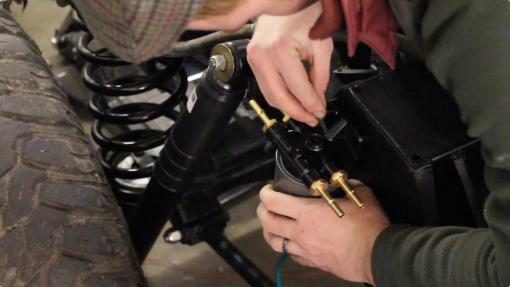
[/url]
The filter housing corrodes on the TD5, the one we removed was unusable. I replaced it with this new part which is anodised and also took the time to spray the casting cavity with Dinitrol.
[url=http://funrover.com/wp-content/uploads/2015/11/Screen-Shot-2015-11-27-at-12.47.05.png]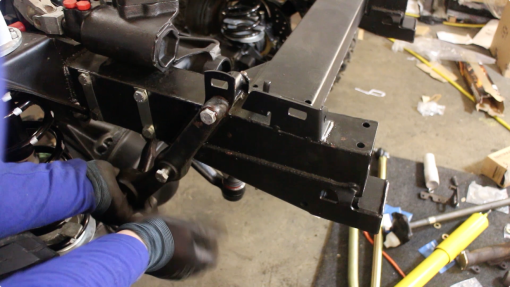
[/url]
Then I fitted up this bracket, ready to accept the panhard rod.
[url=http://funrover.com/wp-content/uploads/2015/11/Screen-Shot-2015-11-27-at-12.49.43.png]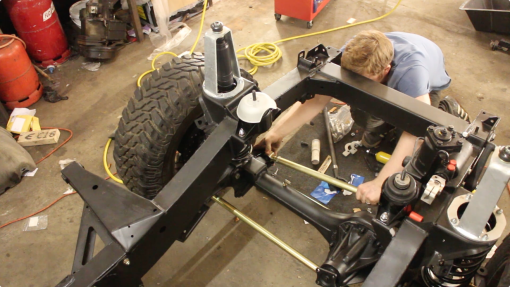
[/url]
I've chosen to use a heavy duty adjustable panhard rod from Terrafirma. It's well made and looks good. I had to tap it in place with a soft faced hammer.
[url=http://funrover.com/wp-content/uploads/2015/11/Screen-Shot-2015-11-27-at-12.51.27.png]
[/url]
To get it to fit, I had to adjust it slightly - then use a screwdriver to align the bolt hole. Both bolts then need*torquing*down. I'm having the Defender professionally set-up and aligned at a later date, so the steering arms e.t.c will be adjusted then.
[url=http://funrover.com/wp-content/uploads/2015/11/Screen-Shot-2015-11-27-at-12.54.25.png]
[/url]
Then I fitted the cross rod eye into the steering arm. This has a counter clockwise thread so it tightens opposite to what you're normally used to.
[url=http://funrover.com/wp-content/uploads/2015/11/Screen-Shot-2015-11-27-at-12.56.03.png]
[/url]
Then offered up the steering arm. Unfortunately, I've lost the castellated nuts that go onto the track rods so will need to replace those, along with the split pins.
[url=http://funrover.com/wp-content/uploads/2015/11/Screen-Shot-2015-11-27-at-12.57.22.png]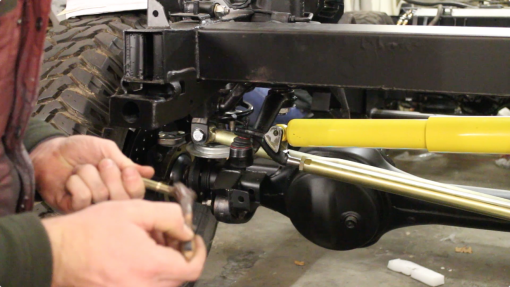
[/url]
Next I dropped in the new Old Man Emu steering damper. This is a very heavy duty damper, it's fairly easy to fit though I did have to file down the lower bush race slightly (mostly just the powder coat really).
[url=http://funrover.com/wp-content/uploads/2015/11/Screen-Shot-2015-11-27-at-12.59.07.png]
[/url]
Moving onto the brake callipers, we were shot blasting our old ones, which brought them up a treat. But when you have 4 callipers that need blasting, painting, the seals replacing then refitting 0 the time taken quickly adds up. So, the decision was made to replace them with 4 OEM new brake callipers. We are also swapping*the standard steel*piston callipers with stainless steel replacements. In the past, I've had to rebuild the brakes almost everytime I swapped brake pads - as we cover very little miles in the Land Rover, it allows the callipers to corrode. Then when you come along to replace the pads, the callipers will not retract. Lots of people say "just force them", but if your pistons are binding, this is more friction and thus a less efficient brake.
[url=http://funrover.com/wp-content/uploads/2015/11/Screen-Shot-2015-11-27-at-13.00.37.png]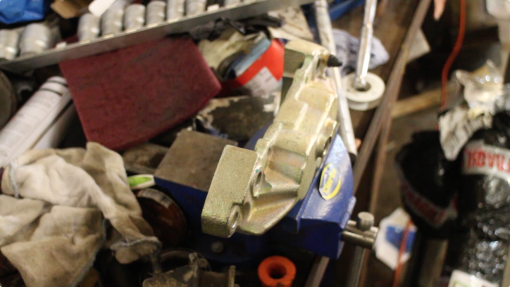
[/url]
The easiest way to remove the old pistons is using an air line and blow gun. Be careful though, they fly out with tremendous force! I've had caliber pistons fly 30 feet easily! Then unbolt the calliper halves (this is not recommended by us or any brake manufacturer) but if you do so - you must have a spotlessly clean work area.
[url=http://funrover.com/wp-content/uploads/2015/11/Screen-Shot-2015-11-27-at-13.03.49.png]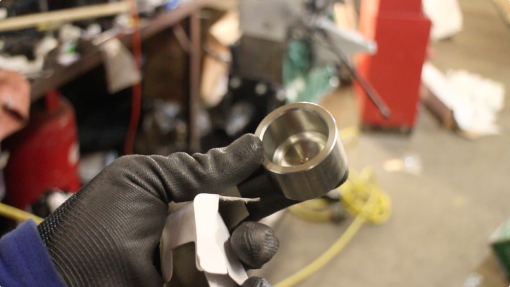
[/url]
This is the*stainless steel replacement, they can be picked up quite reasonably nowadays and should prevent any problems in the future!
[url=http://funrover.com/wp-content/uploads/2015/11/Screen-Shot-2015-11-27-at-13.04.56.png]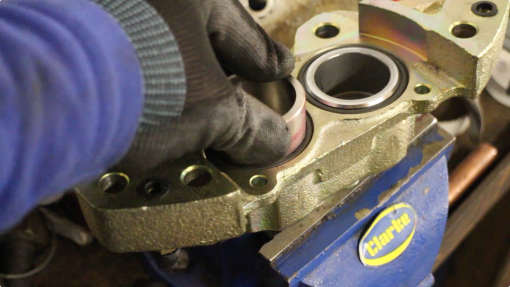
[/url]
When assembling, smear Red Rubber Grease on the piston calliper. These has numerous benefits:[list][*]It prolongs the life of the rubber seal[*]It reduces the effects of wear from moving parts[*]It helps helps to resist*water ingress / hydroscopic action[*]It's a rust inhibitor[/list]Once smeared in red rubber grease, the piston*should slide smoothly back into place. Repeat for the remaining pistons. When doing the calliper bolts up, it's best to do these as tight as you can.
[url=http://funrover.com/wp-content/uploads/2015/11/Screen-Shot-2015-11-27-at-13.07.06.png]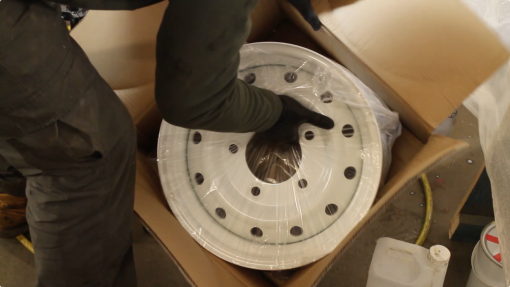
[/url]
We sold our 90's old wheels. These were aftermarket & oversized*alloys that wouldn't suit our build, to a fellow Land Rover enthusiast and FunRover fan. In their place, we're fitting Wolf steel rims. We're trying to stick very closely to Land Rover factory fitment options so these suit our build perfectly, whilst still giving us a more vintage Land Rover appearance. Wolf rims are also impressively strong with a high load ratings per corner. These need painting though to match our concept drawings. We've chosen the classic Land Rover wheel colour: Limestone.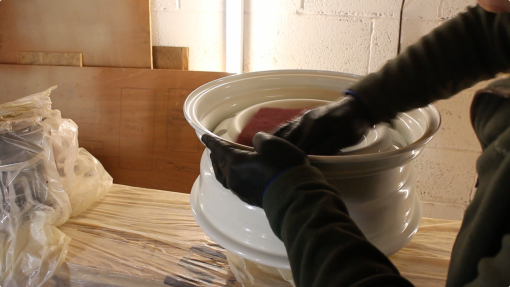 Throughly keying*off our wheels with a 3M red scotchbrite*pad, and blowing away the resulting dust. Anywhere that isn't keyed off will likely not adhere correctly with the paint.
Throughly keying*off our wheels with a 3M red scotchbrite*pad, and blowing away the resulting dust. Anywhere that isn't keyed off will likely not adhere correctly with the paint.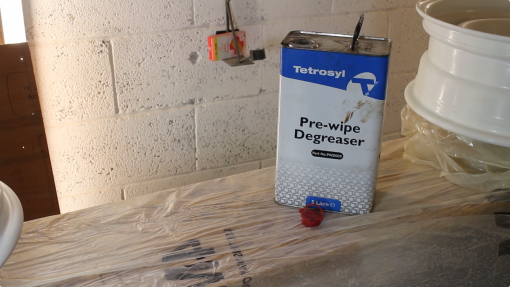 The whole rim was degreased. After the degreaser evaporated, it was then tack clothed.
The whole rim was degreased. After the degreaser evaporated, it was then tack clothed.
[url=http://funrover.com/wp-content/uploads/2015/11/Screen-Shot-2015-11-27-at-13.19.23.png]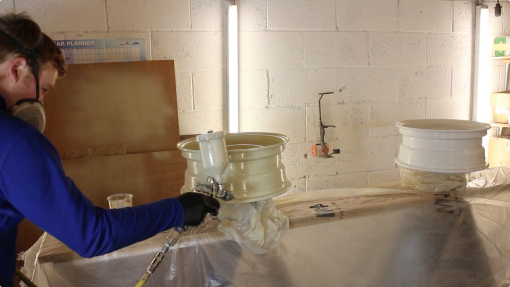
[/url]
Finally, onto painting. We're using a single pack, matt finish acrylic enamel. This one uses Xylene industrial thinners, at a ratio of around 10 / 15%. However, since it's so cold in the workshop, I had to add more to suit. A light coat of paint was added for*the first layer. Subsequent layers were*medium wet. We;d been firing up the space heater prior to painting to raise the ambient temperature and burn off some of the humidity. Paints work best when applied around 20 degrees, so the closer to this mark you get, the better.
[url=http://funrover.com/wp-content/uploads/2015/11/Screen-Shot-2015-11-27-at-13.22.29.jpg]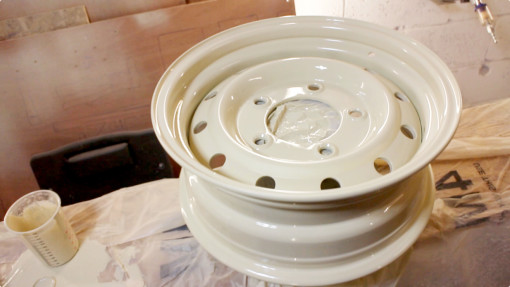
[/url]
The wheels will then be left to cure for a week at least before mounting the tyres. The coat here is still drying, hence the high gloss appearance.
[url=http://funrover.com/wp-content/uploads/2015/11/Screen-Shot-2015-11-27-at-12.44.57.png]

[/url]
This week, I've had my better half working on the bulkhead, removing the remains of the seam sealer so the bulkhead can be sent off to the shot blasters, then to the galvanisers and back to me for painting.
[url=http://funrover.com/wp-content/uploads/2015/11/Screen-Shot-2015-11-27-at-12.45.29.png]

[/url]
The filter housing corrodes on the TD5, the one we removed was unusable. I replaced it with this new part which is anodised and also took the time to spray the casting cavity with Dinitrol.
[url=http://funrover.com/wp-content/uploads/2015/11/Screen-Shot-2015-11-27-at-12.47.05.png]

[/url]
Then I fitted up this bracket, ready to accept the panhard rod.
[url=http://funrover.com/wp-content/uploads/2015/11/Screen-Shot-2015-11-27-at-12.49.43.png]

[/url]
I've chosen to use a heavy duty adjustable panhard rod from Terrafirma. It's well made and looks good. I had to tap it in place with a soft faced hammer.
[url=http://funrover.com/wp-content/uploads/2015/11/Screen-Shot-2015-11-27-at-12.51.27.png]

[/url]
To get it to fit, I had to adjust it slightly - then use a screwdriver to align the bolt hole. Both bolts then need*torquing*down. I'm having the Defender professionally set-up and aligned at a later date, so the steering arms e.t.c will be adjusted then.
[url=http://funrover.com/wp-content/uploads/2015/11/Screen-Shot-2015-11-27-at-12.54.25.png]

[/url]
Then I fitted the cross rod eye into the steering arm. This has a counter clockwise thread so it tightens opposite to what you're normally used to.
[url=http://funrover.com/wp-content/uploads/2015/11/Screen-Shot-2015-11-27-at-12.56.03.png]

[/url]
Then offered up the steering arm. Unfortunately, I've lost the castellated nuts that go onto the track rods so will need to replace those, along with the split pins.
[url=http://funrover.com/wp-content/uploads/2015/11/Screen-Shot-2015-11-27-at-12.57.22.png]

[/url]
Next I dropped in the new Old Man Emu steering damper. This is a very heavy duty damper, it's fairly easy to fit though I did have to file down the lower bush race slightly (mostly just the powder coat really).
[url=http://funrover.com/wp-content/uploads/2015/11/Screen-Shot-2015-11-27-at-12.59.07.png]

[/url]
Moving onto the brake callipers, we were shot blasting our old ones, which brought them up a treat. But when you have 4 callipers that need blasting, painting, the seals replacing then refitting 0 the time taken quickly adds up. So, the decision was made to replace them with 4 OEM new brake callipers. We are also swapping*the standard steel*piston callipers with stainless steel replacements. In the past, I've had to rebuild the brakes almost everytime I swapped brake pads - as we cover very little miles in the Land Rover, it allows the callipers to corrode. Then when you come along to replace the pads, the callipers will not retract. Lots of people say "just force them", but if your pistons are binding, this is more friction and thus a less efficient brake.
[url=http://funrover.com/wp-content/uploads/2015/11/Screen-Shot-2015-11-27-at-13.00.37.png]

[/url]
The easiest way to remove the old pistons is using an air line and blow gun. Be careful though, they fly out with tremendous force! I've had caliber pistons fly 30 feet easily! Then unbolt the calliper halves (this is not recommended by us or any brake manufacturer) but if you do so - you must have a spotlessly clean work area.
[url=http://funrover.com/wp-content/uploads/2015/11/Screen-Shot-2015-11-27-at-13.03.49.png]

[/url]
This is the*stainless steel replacement, they can be picked up quite reasonably nowadays and should prevent any problems in the future!
[url=http://funrover.com/wp-content/uploads/2015/11/Screen-Shot-2015-11-27-at-13.04.56.png]

[/url]
When assembling, smear Red Rubber Grease on the piston calliper. These has numerous benefits:[list][*]It prolongs the life of the rubber seal[*]It reduces the effects of wear from moving parts[*]It helps helps to resist*water ingress / hydroscopic action[*]It's a rust inhibitor[/list]Once smeared in red rubber grease, the piston*should slide smoothly back into place. Repeat for the remaining pistons. When doing the calliper bolts up, it's best to do these as tight as you can.
[url=http://funrover.com/wp-content/uploads/2015/11/Screen-Shot-2015-11-27-at-13.07.06.png]

[/url]
We sold our 90's old wheels. These were aftermarket & oversized*alloys that wouldn't suit our build, to a fellow Land Rover enthusiast and FunRover fan. In their place, we're fitting Wolf steel rims. We're trying to stick very closely to Land Rover factory fitment options so these suit our build perfectly, whilst still giving us a more vintage Land Rover appearance. Wolf rims are also impressively strong with a high load ratings per corner. These need painting though to match our concept drawings. We've chosen the classic Land Rover wheel colour: Limestone.
 Throughly keying*off our wheels with a 3M red scotchbrite*pad, and blowing away the resulting dust. Anywhere that isn't keyed off will likely not adhere correctly with the paint.
Throughly keying*off our wheels with a 3M red scotchbrite*pad, and blowing away the resulting dust. Anywhere that isn't keyed off will likely not adhere correctly with the paint. The whole rim was degreased. After the degreaser evaporated, it was then tack clothed.
The whole rim was degreased. After the degreaser evaporated, it was then tack clothed.[url=http://funrover.com/wp-content/uploads/2015/11/Screen-Shot-2015-11-27-at-13.19.23.png]

[/url]
Finally, onto painting. We're using a single pack, matt finish acrylic enamel. This one uses Xylene industrial thinners, at a ratio of around 10 / 15%. However, since it's so cold in the workshop, I had to add more to suit. A light coat of paint was added for*the first layer. Subsequent layers were*medium wet. We;d been firing up the space heater prior to painting to raise the ambient temperature and burn off some of the humidity. Paints work best when applied around 20 degrees, so the closer to this mark you get, the better.
[url=http://funrover.com/wp-content/uploads/2015/11/Screen-Shot-2015-11-27-at-13.22.29.jpg]

[/url]
The wheels will then be left to cure for a week at least before mounting the tyres. The coat here is still drying, hence the high gloss appearance.
TacoExcellence said:
I've always wanted to do this with a 110, but looking at this I'm now realising what a massive undertaking and how far beyond my abilities it is.
Fantastic work though.
It is indeed a big job, even more so on a 110, but very rewarding. You just need to remain motivated as much as possibleFantastic work though.
https://www.youtube.com/watch?v=WLLmDy4aUxc

This is Spray booth MK2 which I'll show in a future episode, it's working very well, cutting humidity to the low 30s and upping the air temp to a solid 20+ celsius. It means that I can get the whole car painted even if it's freezing outside and the workshop is only 1 or 2 degrees warmer.
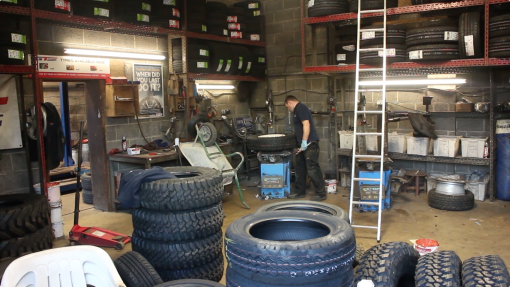
Once the wheels had been cured in the booth I took them along to a local tyre fitters
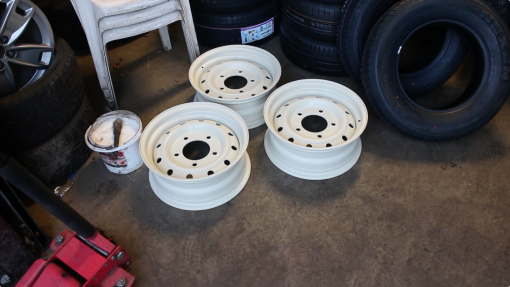
I've chosen the Wolf HD rims (as seen on Heritage edition Defenders). These are tough, strong and quite cheap.
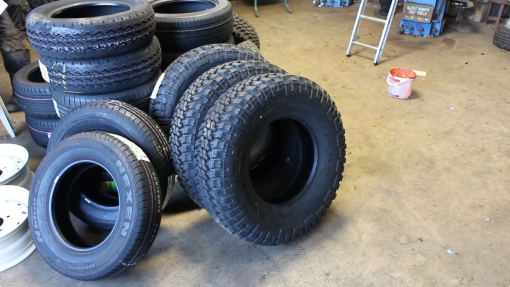
Along with tubeless Goodyear MTR tyres, another factory fit option.

The tyre fitter used a product known as Rim Seal that has anti-corrosion properties as well as adding lubrication for the next step

The tyre fitting machine has a large guide that eases the tyre bead of the lip of the wheel.

Finally, the tyres are inflated to manufacturer specifications, this helps to seat them too (watch the video too see how loud this stage is!)

Here they are mounted up in daylight, the colour and*finish is perfect! The SIP HVLP gun I used works well for the money!
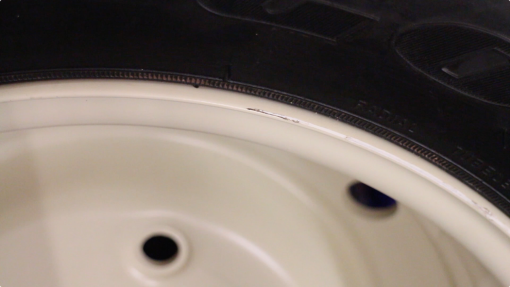
The tyre fitting guide can score the lips of the wheel, which is no real problem!
[img:510:287]http://funrover.com/wp-content/uploads/2015/12/Screen-Shot-2015-12-14-at-08.42.38-510x287.png[/img]
I simply wiped it clean with alcohol then used an artist brush to touch in the scrapes.
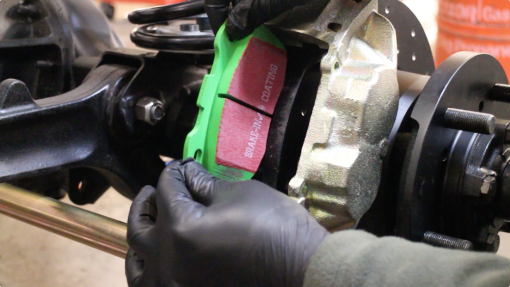
Whilst the repairs are drying, I dropped in the pads - EBC Green stuff to match the EBC performance disks. This Land Rover will stop on a penny if needs be!
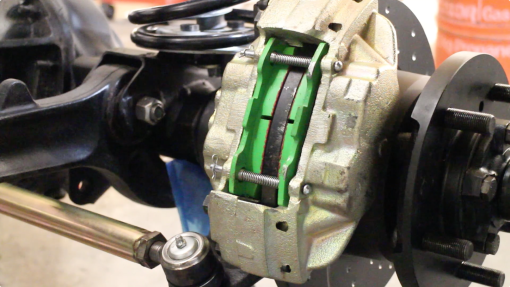
Not keen on the colour, but the wheels will cover them up!

Lifting the wheels onto the longer Wolf*FRC7577 extended wheel studs - expensive but*designed to work with the Wolf rim

Nipping the nuts up, they need to be torqued to 170NM after lowering the Landy of it's jacks.

All 4 wheels fitted!
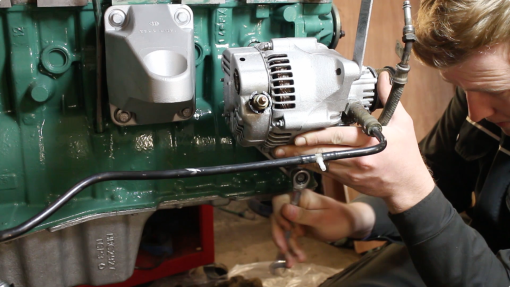
Fitting up the alternator / vacuum pump whilst the engine is still on the stand

This has been painted with a high temp paint to match the rest of the engine

Now it's time to finally drop the engine back in the 90! This feels like it's finally getting somewhere!
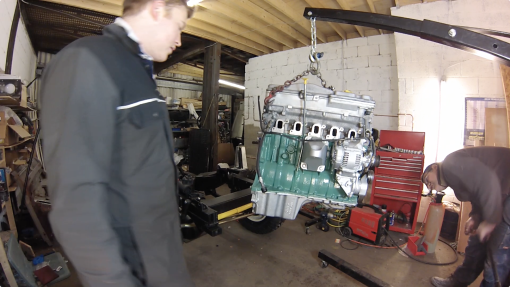
The engine needs to*be lifted over the front crossmember between the dumb irons. The engine crane is an extremely useful tool, I love it! It's also useful to have 2 people here, one to jack and watch the near side, whilst the other guides in the engine from the other.

Fitting an engine to a rolling chassis is great, there's nothing in the way! Takes about a minute!
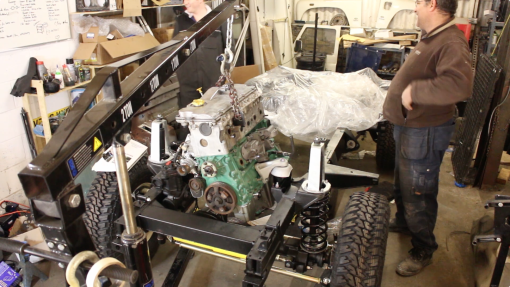
And that's it for this week, need to get cracking now as I would still like to hit my deadline of January 1st XD

This is Spray booth MK2 which I'll show in a future episode, it's working very well, cutting humidity to the low 30s and upping the air temp to a solid 20+ celsius. It means that I can get the whole car painted even if it's freezing outside and the workshop is only 1 or 2 degrees warmer.

Once the wheels had been cured in the booth I took them along to a local tyre fitters

I've chosen the Wolf HD rims (as seen on Heritage edition Defenders). These are tough, strong and quite cheap.

Along with tubeless Goodyear MTR tyres, another factory fit option.

The tyre fitter used a product known as Rim Seal that has anti-corrosion properties as well as adding lubrication for the next step

The tyre fitting machine has a large guide that eases the tyre bead of the lip of the wheel.

Finally, the tyres are inflated to manufacturer specifications, this helps to seat them too (watch the video too see how loud this stage is!)

Here they are mounted up in daylight, the colour and*finish is perfect! The SIP HVLP gun I used works well for the money!

The tyre fitting guide can score the lips of the wheel, which is no real problem!
[img:510:287]http://funrover.com/wp-content/uploads/2015/12/Screen-Shot-2015-12-14-at-08.42.38-510x287.png[/img]
I simply wiped it clean with alcohol then used an artist brush to touch in the scrapes.

Whilst the repairs are drying, I dropped in the pads - EBC Green stuff to match the EBC performance disks. This Land Rover will stop on a penny if needs be!

Not keen on the colour, but the wheels will cover them up!

Lifting the wheels onto the longer Wolf*FRC7577 extended wheel studs - expensive but*designed to work with the Wolf rim

Nipping the nuts up, they need to be torqued to 170NM after lowering the Landy of it's jacks.

All 4 wheels fitted!

Fitting up the alternator / vacuum pump whilst the engine is still on the stand

This has been painted with a high temp paint to match the rest of the engine

Now it's time to finally drop the engine back in the 90! This feels like it's finally getting somewhere!

The engine needs to*be lifted over the front crossmember between the dumb irons. The engine crane is an extremely useful tool, I love it! It's also useful to have 2 people here, one to jack and watch the near side, whilst the other guides in the engine from the other.

Fitting an engine to a rolling chassis is great, there's nothing in the way! Takes about a minute!

And that's it for this week, need to get cracking now as I would still like to hit my deadline of January 1st XD
https://www.youtube.com/watch?v=vrEJwVE1jr4

The rear tub is in need of some minor repairs. The tub cappings will be removed and sent off for galvanising. Everywhere else, we have replacement repair sections.
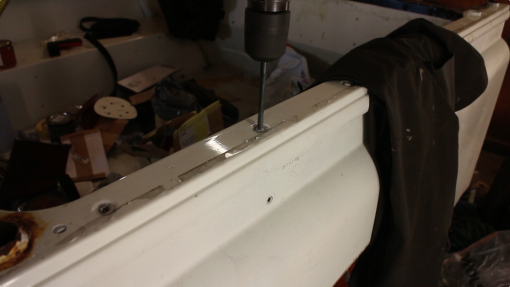
Using a 6mm drill bit, we're drilling into the rivet head, which typically shears off.

Then the crush section of the rivet can be tapped out, this is the quickest way to remove rivets.
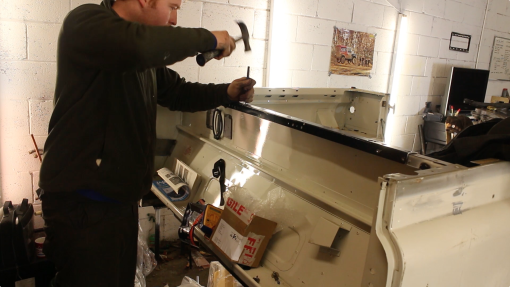
There are quite a number of rivets all told on the cappings
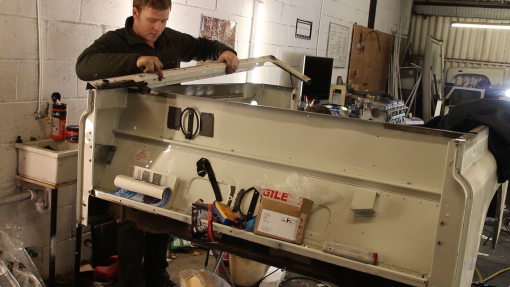
In addition to rivets, the cappings are typically held on with some mild adhesives / foam tape and can then be lifted away. Those will be going to the galvanisers along side the bulkhead and will be fitted unpainted to the 90 for that classic Land Rover appearance.
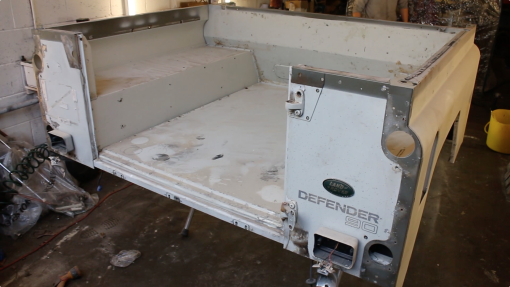
Cappings gone, you can see the Zinc Phosphate primer applied at the factory. Over the primer, the tub is currently overcoated in 2 pack (Chawton White). We'll be going to the classic (and now rather popular) Pastel Green, a Series 1 colour

These seatbelt mount brackets panels came from YRM Metal Solutions. They've been laser cut, CNC folded and galvanised. The result is excellent tolerances and a lasting repair!
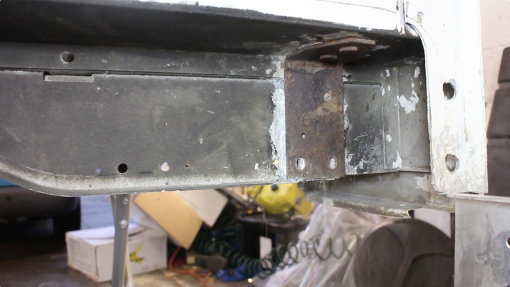
Fitting is easy, the old seat belt mount bracket is removed.

And any flaky aluminium corrosion is stripped away with a wire wheel.
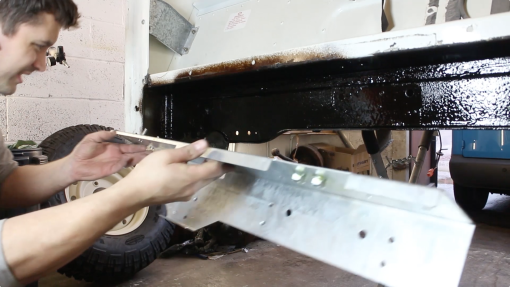
We applied Dinitrol cavity wax to the tub, before offering up the repair section.
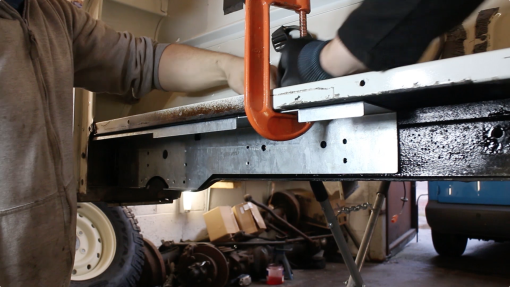
It's supplied in 2 pieces (otherwise it wouldn't fit), there are a few holes that have captive nuts so bolts were installed to hold the panel in place, along with a G clamp.
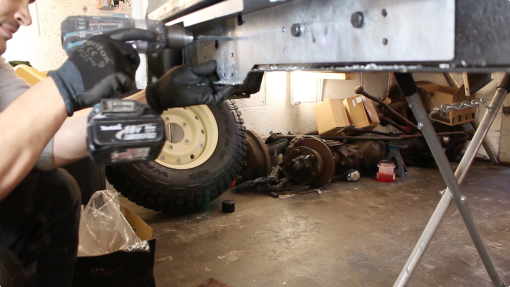
Before drilling the holes for each fixing.

There are a total of 48 M8 bolts required. Once secured, these panels are very strong! There's zero movement and the whole lot will be overcoated with stone chip for further protection.

Moving onto the strike plate, this often corrodes where the tub fits to the sill rail, due to bimetallic reaction. The aluminium turns to a powder and is completely unusable.
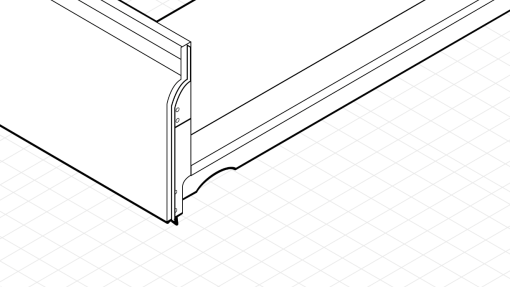
So to repair we'll fit new strike plate sections from YRM too. These are pretty simple to fit, and once prepared and painted, it should be as good as new.
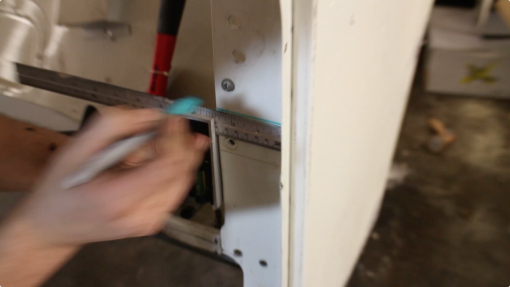
We're starting by marking off where we'd like to cut off the strike plate.

And using a spot weld drill to remove the spot welds and rivets below the line, including on the seal retainer.

Then, using a bolster chisel and a scraper, we can begin to prise the 2 skins apart
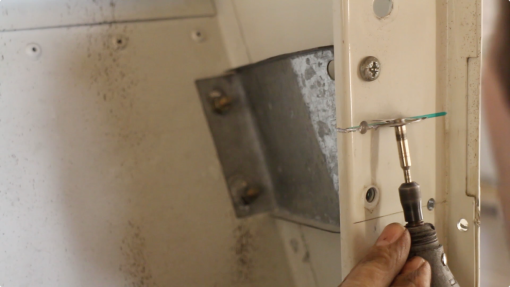
Finally, we scored a mark with a Dremel multi tool along the line. Then we were able to fracture the corroded part off, with a clean break formed along our score.
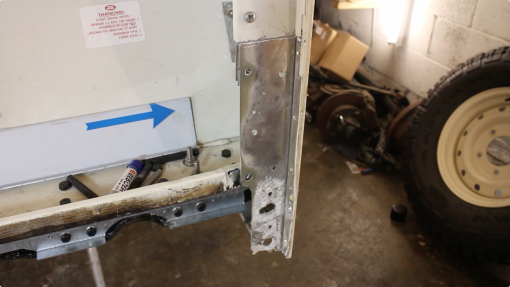
I'll be fitting the new sections in another video, shown here is the exposed rear skin.
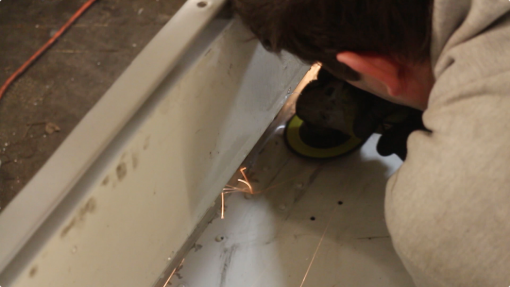
The floor too has suffered with some corrosion and needs replacing. The dome rivets need to be ground down, others will need to be drilled and others still, cut with a grinder.

The floor has adhesives applied in key areas, so it can take some time with a breaker bar & hammer to separate the floor from the supports.

After all rivets have been drilled out, the floor will lift out
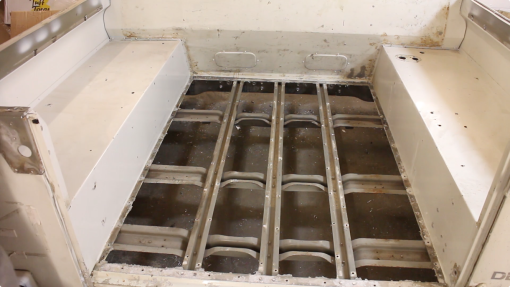
Now's a good time to assess the condition of the tub supports. We can also throughly rust proof these whilst they're exposed.

Finally, my plumber wife kindly began brazing some of the redundant holes in my tub, using the excellent Lumiweld from Frost.co.uk. You can check out the results at the end of the video, it's impressive stuff! And is formulated to work on Birmabright!

The rear tub is in need of some minor repairs. The tub cappings will be removed and sent off for galvanising. Everywhere else, we have replacement repair sections.

Using a 6mm drill bit, we're drilling into the rivet head, which typically shears off.

Then the crush section of the rivet can be tapped out, this is the quickest way to remove rivets.

There are quite a number of rivets all told on the cappings

In addition to rivets, the cappings are typically held on with some mild adhesives / foam tape and can then be lifted away. Those will be going to the galvanisers along side the bulkhead and will be fitted unpainted to the 90 for that classic Land Rover appearance.

Cappings gone, you can see the Zinc Phosphate primer applied at the factory. Over the primer, the tub is currently overcoated in 2 pack (Chawton White). We'll be going to the classic (and now rather popular) Pastel Green, a Series 1 colour

These seatbelt mount brackets panels came from YRM Metal Solutions. They've been laser cut, CNC folded and galvanised. The result is excellent tolerances and a lasting repair!

Fitting is easy, the old seat belt mount bracket is removed.

And any flaky aluminium corrosion is stripped away with a wire wheel.

We applied Dinitrol cavity wax to the tub, before offering up the repair section.

It's supplied in 2 pieces (otherwise it wouldn't fit), there are a few holes that have captive nuts so bolts were installed to hold the panel in place, along with a G clamp.

Before drilling the holes for each fixing.

There are a total of 48 M8 bolts required. Once secured, these panels are very strong! There's zero movement and the whole lot will be overcoated with stone chip for further protection.

Moving onto the strike plate, this often corrodes where the tub fits to the sill rail, due to bimetallic reaction. The aluminium turns to a powder and is completely unusable.

So to repair we'll fit new strike plate sections from YRM too. These are pretty simple to fit, and once prepared and painted, it should be as good as new.

We're starting by marking off where we'd like to cut off the strike plate.

And using a spot weld drill to remove the spot welds and rivets below the line, including on the seal retainer.

Then, using a bolster chisel and a scraper, we can begin to prise the 2 skins apart

Finally, we scored a mark with a Dremel multi tool along the line. Then we were able to fracture the corroded part off, with a clean break formed along our score.

I'll be fitting the new sections in another video, shown here is the exposed rear skin.

The floor too has suffered with some corrosion and needs replacing. The dome rivets need to be ground down, others will need to be drilled and others still, cut with a grinder.

The floor has adhesives applied in key areas, so it can take some time with a breaker bar & hammer to separate the floor from the supports.

After all rivets have been drilled out, the floor will lift out

Now's a good time to assess the condition of the tub supports. We can also throughly rust proof these whilst they're exposed.

Finally, my plumber wife kindly began brazing some of the redundant holes in my tub, using the excellent Lumiweld from Frost.co.uk. You can check out the results at the end of the video, it's impressive stuff! And is formulated to work on Birmabright!
https://www.youtube.com/watch?v=lKugafonbWo
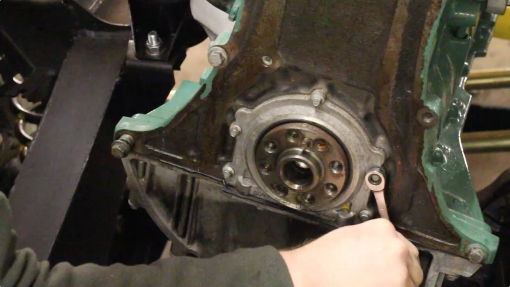
One of the many brilliant things about YouTube is that we can get feedback directly from our viewers. Some of these these comments are very useful (in fact*we read and respond to every single one). One fan told us a woeful story when he had to remove his gearbox for a 2nd time after forgetting*to change the rear crankshaft oil seal on a high mileage TD5. So a replacement was sort from LR Parts.

Once the*new item was in place (see video for fitting), the spigot bush was pressed into place. This had*been soaked in engine oil for a few days. This is an old school trick I read about that helps sintered bronze bushes (which are supposedly*porous) to add extra lubrication to a material that is already self-lubricating. I've read of premature spigot bush failings and figured it was worth a shot. The rear of the engine block was cleaned up too.
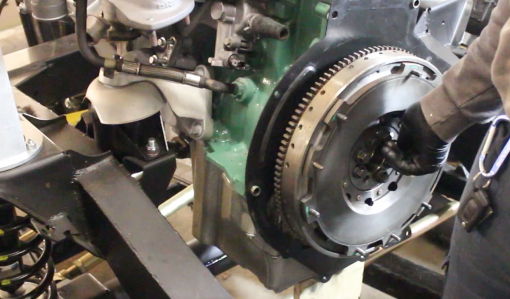
Once cleaned off, the gearbox shim plate / cover and DMF were fitted up. You can purchase a flywheel holder to fasten down the 2 stage bolts, or simply get someone else to hold it. The bolts are tightened up by*diagonal selection (star pattern).
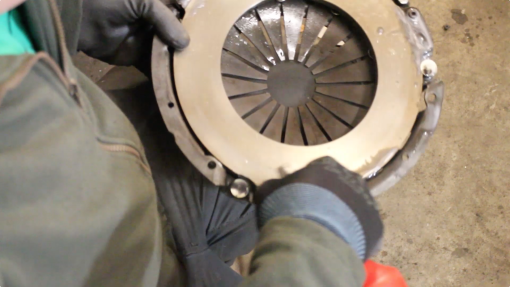
The clutch cover (and flywheel) were*cleaned up using Brake & Clutch cleaner.
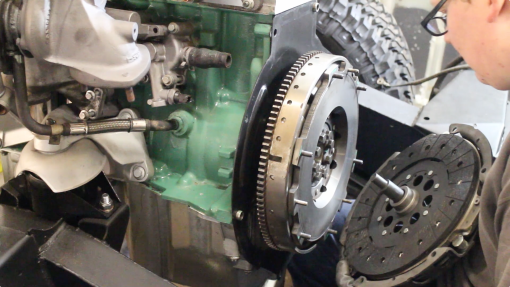
Using a clutch alignment tool (these are available on eBay at a good price), the clutch plate was offered up and correctly positioned.
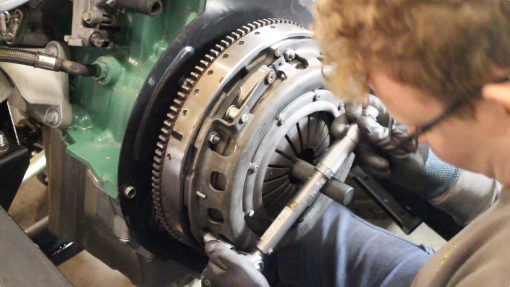
And the 3/8 torque wrench broken out to secure down the clutch cover
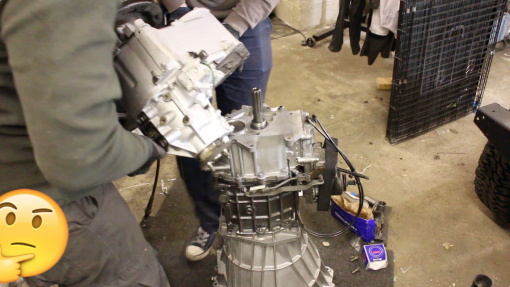
Moving onto the transfer box, this needed to be reunited with the reconditioned R380. I toyed with the idea of fitting a Discovery transfer box, with it's preferable ratio that offers lower revs at cruising speeds. *On balance, I decided against fitting the disco box as I*rarely go on substantial motorway trips to warrant such a change. This was most easily achieved by standing the gearbox on end, then square lifting the transfer box onto the output*shaft of the gearbox.
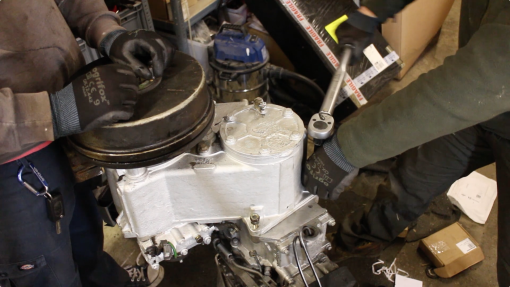
Torque settings can be found in the manual. We'll re-finish the hand brake drum once the gearbox is in place, as it will undoubtedly get scratched during fitting.

The gearbox and transfer box are joined once more! Incidentally, I've been making use of some carpeted plywood panels as assembly mats. We removed them from the 90*on disassembly, but they've proven useful at preventing newly painted components from getting marked and scuffed*up.

We next fitted the clutch release bearing guide (of which I now have 3, thanks to ordering one part that was completely wrong and losing my original one and then finding it a few days later). The clutch fork, push rod and clips such as this one above that prevent the whole lot from*dislodging and destroying the clutch plate, were secured also. Molybdenum grease was used in appropriate areas.
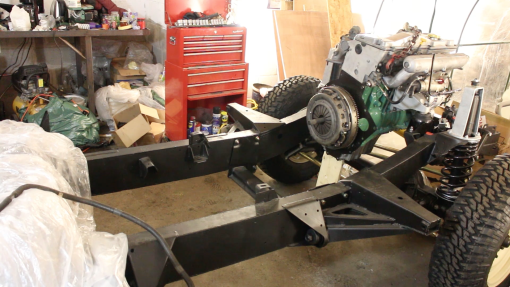
The engine ready to receive the gearbox /transfer box assembly.
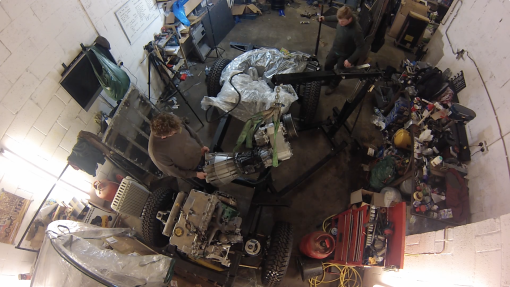
An engine crane is worth it's weight in gold here. A second pair of hands (thanks Phil, he always brings biscuits!) make lighter work of aligning the box, as does a high lift*trolley jack to fine tune positioning. Strap the gearbox to the crane as though the bell housing wasn't present as this weighs almost nothing. Try go diagonally across the gearbox casing and transfer box to get as level*a lift as possible.

Reconditioned gearbox meets the engine for the first time! Meshing the splines together was a little tricky and took a while, but once done, it's very satisfying! Need to fire some oil in both of those now. I'm going to run some cheap oil*through both to flush them out (just in case)
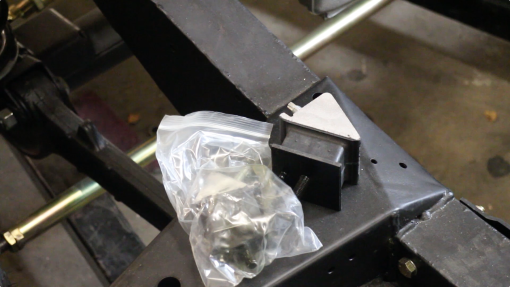
Took the chance to renew the gearbox mounts whilst I had access. These are OEM replacements.
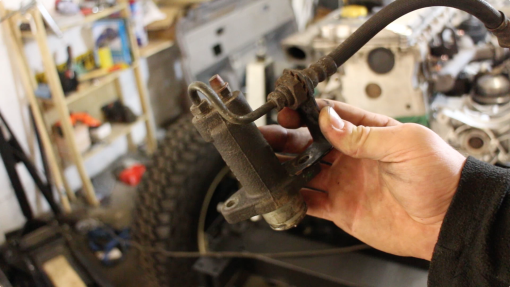
The slave cylinder and associated pipes were looking worse for wear. It was decided to replace them as the cost isn't particularly prohibitive and it's an easy job.
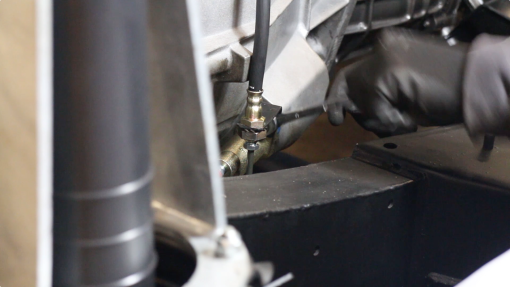
The only original parts saved were the bracket and the nuts (albeit,*cleaned up on the wire wheel and the bracket was sanded and painted). I've popped a pen lid on there to stop any dirt from the ceiling dropping in (there's a shop*above mine and when they walk around, tiny specs of chipboard*dust fall everywhere)
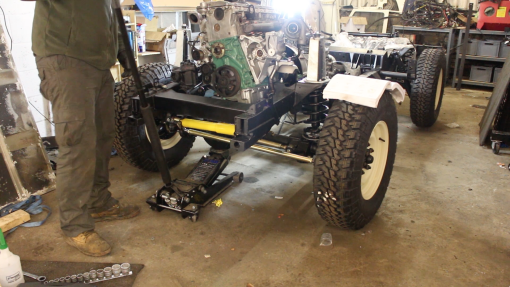
Once that's sorted, I can put my new props on. In the end, the decision came down to either reconditioning the old ones, replacing them with large and expensive HD ones or just purchasing new OEM ones. I chose OEM ones from Britpart as I've been told these are produced by Hardy Spicer (well, GKN as they bought out HS apparently). Time will tell if this was the right decision. Fitting the props is made easier if you jack up one wheel, allowing the transmission to freely rotate.
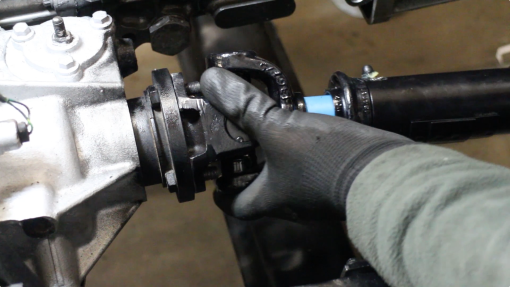
I'll grease those UJs and props again before running the vehicle, once offered up, fixings were lightly greased to prevent seizing up, and torqued down to 48nm. A propshaft socket is very handy here, you'll also need a 9/16 spanner*(some owners make a 14mm combination*work, though this isn't quite the right size and can cause nut rounding)

Props in place
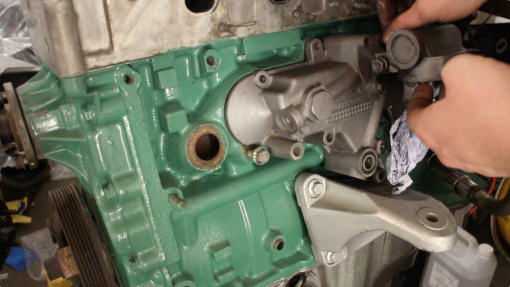
I've fitted the oil cooler, however some owners have contacted me suggesting an upgrade to this area - will feature that in a coming episode.
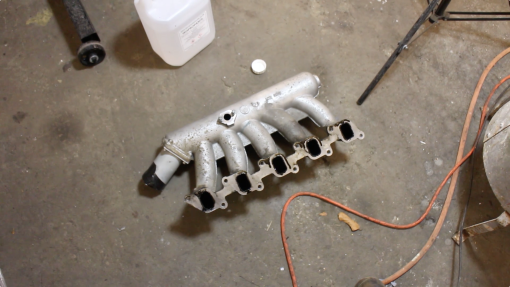
I managed to accidentally format my SD card the other week, losing a lot of engine re-assmebly clips! And a rather humorous one of me putting the inlet manifold into a dishwasher, before the dishwasher began to spew diesel and oil*bubbles all over the kitchen. The wife, needless to say, wasn't impressed.
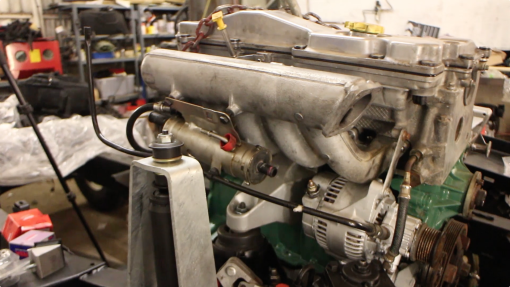
Inlet manifold and fuel cooler in position.
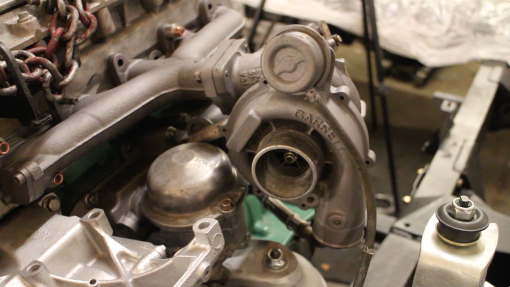
The painted turbo and exhaust manifold, we used grey POR 15 high temperature*manifold paint from Frost.co.uk.

You might*remember that our manifold had warped and snapped studs. This is a common issue on Td5's. The easiest fix (and most cost effective) is to remove the manifold and have it skimmed true and dewebbed. The theory is that the casting*has warped and shouldn't warp again. Once it's been engineered back to acceptable tolerances, you can fit longer studs from AliveTuning or similar with spacers to help prevent the studs from snapping again. We purchased a set of 16mm stainless steel spacers from eBay, along with an extended stud kit and then painted the whole lot*to match the turbo. It shouldn't ever shift*again and the cost was preferential to that of a custom stainless or ceramic coated manifold.
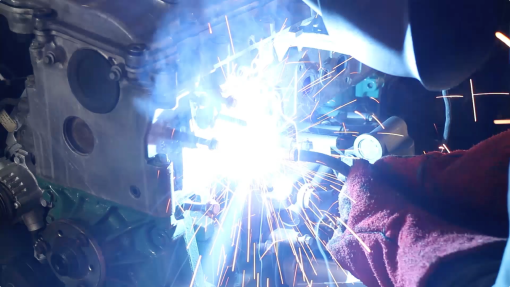
Removing broken studs: you can try stud extractors (didn't work for me), drilling and retapping, drilling and helicoiling or welding a nut onto the end of the stud and removing that way.
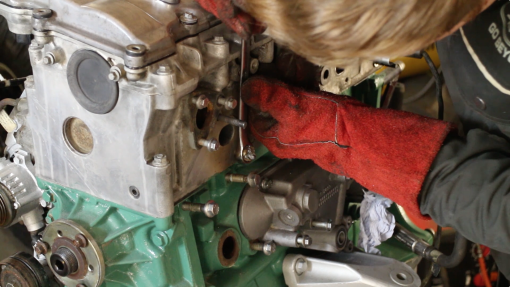
This works well as the heat from welding helps*free up*the threads*and the whole stud*should simply*wind out.
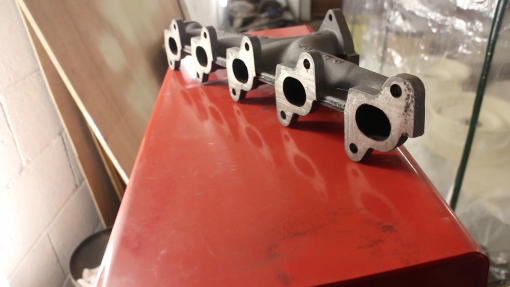
The manifold skimming*cost £90 in the end from a local machine shop. This was considerably cheaper than £500+ for a stainless part.
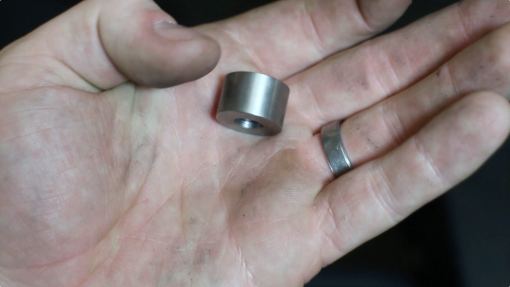
These M8 16mm spacers were purchased from eBay and match our Wurth extended studs nicely.
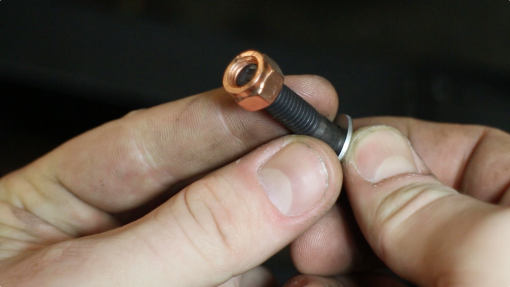
The kit also includes a washer and copper flashed nut, helping avoid*corrosion issues.
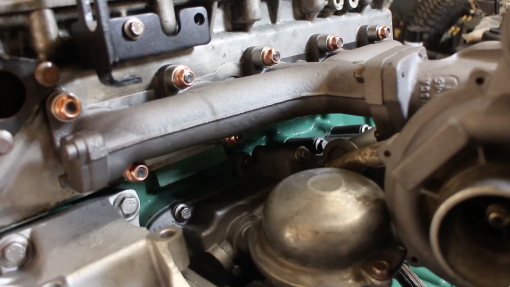
Here's the manifold in place, complete with it's spacers. It certainly looks the part and shouldn't warp again. I also fitted 2 gaskets because when I removed it, there were 2 gaskets - probably a service bulletin fix from a dealer!
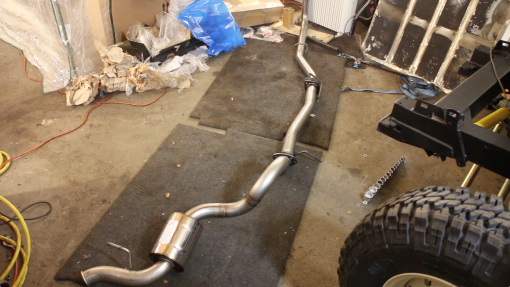
Next time, we can fit up our stainless exhaust system, weld the bulkhead and sort out the brake pipes.

One of the many brilliant things about YouTube is that we can get feedback directly from our viewers. Some of these these comments are very useful (in fact*we read and respond to every single one). One fan told us a woeful story when he had to remove his gearbox for a 2nd time after forgetting*to change the rear crankshaft oil seal on a high mileage TD5. So a replacement was sort from LR Parts.

Once the*new item was in place (see video for fitting), the spigot bush was pressed into place. This had*been soaked in engine oil for a few days. This is an old school trick I read about that helps sintered bronze bushes (which are supposedly*porous) to add extra lubrication to a material that is already self-lubricating. I've read of premature spigot bush failings and figured it was worth a shot. The rear of the engine block was cleaned up too.

Once cleaned off, the gearbox shim plate / cover and DMF were fitted up. You can purchase a flywheel holder to fasten down the 2 stage bolts, or simply get someone else to hold it. The bolts are tightened up by*diagonal selection (star pattern).

The clutch cover (and flywheel) were*cleaned up using Brake & Clutch cleaner.

Using a clutch alignment tool (these are available on eBay at a good price), the clutch plate was offered up and correctly positioned.

And the 3/8 torque wrench broken out to secure down the clutch cover

Moving onto the transfer box, this needed to be reunited with the reconditioned R380. I toyed with the idea of fitting a Discovery transfer box, with it's preferable ratio that offers lower revs at cruising speeds. *On balance, I decided against fitting the disco box as I*rarely go on substantial motorway trips to warrant such a change. This was most easily achieved by standing the gearbox on end, then square lifting the transfer box onto the output*shaft of the gearbox.

Torque settings can be found in the manual. We'll re-finish the hand brake drum once the gearbox is in place, as it will undoubtedly get scratched during fitting.

The gearbox and transfer box are joined once more! Incidentally, I've been making use of some carpeted plywood panels as assembly mats. We removed them from the 90*on disassembly, but they've proven useful at preventing newly painted components from getting marked and scuffed*up.

We next fitted the clutch release bearing guide (of which I now have 3, thanks to ordering one part that was completely wrong and losing my original one and then finding it a few days later). The clutch fork, push rod and clips such as this one above that prevent the whole lot from*dislodging and destroying the clutch plate, were secured also. Molybdenum grease was used in appropriate areas.

The engine ready to receive the gearbox /transfer box assembly.

An engine crane is worth it's weight in gold here. A second pair of hands (thanks Phil, he always brings biscuits!) make lighter work of aligning the box, as does a high lift*trolley jack to fine tune positioning. Strap the gearbox to the crane as though the bell housing wasn't present as this weighs almost nothing. Try go diagonally across the gearbox casing and transfer box to get as level*a lift as possible.

Reconditioned gearbox meets the engine for the first time! Meshing the splines together was a little tricky and took a while, but once done, it's very satisfying! Need to fire some oil in both of those now. I'm going to run some cheap oil*through both to flush them out (just in case)

Took the chance to renew the gearbox mounts whilst I had access. These are OEM replacements.

The slave cylinder and associated pipes were looking worse for wear. It was decided to replace them as the cost isn't particularly prohibitive and it's an easy job.

The only original parts saved were the bracket and the nuts (albeit,*cleaned up on the wire wheel and the bracket was sanded and painted). I've popped a pen lid on there to stop any dirt from the ceiling dropping in (there's a shop*above mine and when they walk around, tiny specs of chipboard*dust fall everywhere)

Once that's sorted, I can put my new props on. In the end, the decision came down to either reconditioning the old ones, replacing them with large and expensive HD ones or just purchasing new OEM ones. I chose OEM ones from Britpart as I've been told these are produced by Hardy Spicer (well, GKN as they bought out HS apparently). Time will tell if this was the right decision. Fitting the props is made easier if you jack up one wheel, allowing the transmission to freely rotate.

I'll grease those UJs and props again before running the vehicle, once offered up, fixings were lightly greased to prevent seizing up, and torqued down to 48nm. A propshaft socket is very handy here, you'll also need a 9/16 spanner*(some owners make a 14mm combination*work, though this isn't quite the right size and can cause nut rounding)

Props in place

I've fitted the oil cooler, however some owners have contacted me suggesting an upgrade to this area - will feature that in a coming episode.

I managed to accidentally format my SD card the other week, losing a lot of engine re-assmebly clips! And a rather humorous one of me putting the inlet manifold into a dishwasher, before the dishwasher began to spew diesel and oil*bubbles all over the kitchen. The wife, needless to say, wasn't impressed.

Inlet manifold and fuel cooler in position.

The painted turbo and exhaust manifold, we used grey POR 15 high temperature*manifold paint from Frost.co.uk.

You might*remember that our manifold had warped and snapped studs. This is a common issue on Td5's. The easiest fix (and most cost effective) is to remove the manifold and have it skimmed true and dewebbed. The theory is that the casting*has warped and shouldn't warp again. Once it's been engineered back to acceptable tolerances, you can fit longer studs from AliveTuning or similar with spacers to help prevent the studs from snapping again. We purchased a set of 16mm stainless steel spacers from eBay, along with an extended stud kit and then painted the whole lot*to match the turbo. It shouldn't ever shift*again and the cost was preferential to that of a custom stainless or ceramic coated manifold.

Removing broken studs: you can try stud extractors (didn't work for me), drilling and retapping, drilling and helicoiling or welding a nut onto the end of the stud and removing that way.

This works well as the heat from welding helps*free up*the threads*and the whole stud*should simply*wind out.

The manifold skimming*cost £90 in the end from a local machine shop. This was considerably cheaper than £500+ for a stainless part.

These M8 16mm spacers were purchased from eBay and match our Wurth extended studs nicely.

The kit also includes a washer and copper flashed nut, helping avoid*corrosion issues.

Here's the manifold in place, complete with it's spacers. It certainly looks the part and shouldn't warp again. I also fitted 2 gaskets because when I removed it, there were 2 gaskets - probably a service bulletin fix from a dealer!

Next time, we can fit up our stainless exhaust system, weld the bulkhead and sort out the brake pipes.
Gassing Station | Readers' Cars | Top of Page | What's New | My Stuff




